Paul van Yperen's Blog, page 240
March 22, 2019
Photo by Union Film
Union Film or the Projektions-AG Union (PAGU) was a German film production company which operated during the silent era between 1911 and 1924. The company was founded by Paul Davidson, a leading cinema owner who branched out into production. One of his first major coups was signing up the Danish film star Asta Nielsen for a lengthy contract. A rising star of the company was also the actor-director Ernst Lubitsch who made a series of comedies for Union Film. From 1917 onwards the company functioned as an independent unit of Universum Film AG (Ufa), and was eventually merged into it entirely.
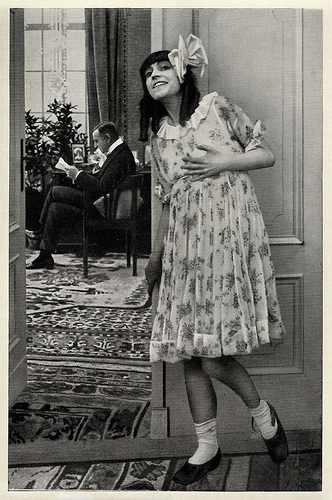
German small photo for the album by Dr. Oskar Kalbus, Vom Werden deutscher Filmkunst, Vol. I, Der Stummfilm (Cigaretten Bilderdienst, 1935). Photo: PAGU. Asta Nielsen in Engelein/The little Angel (Urban Gad, 1914).
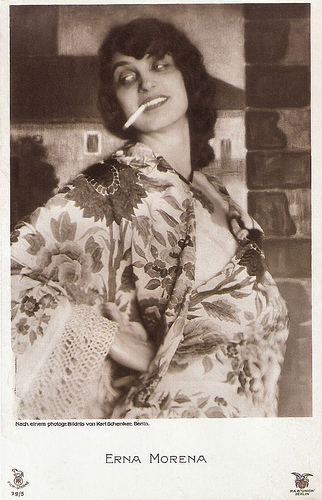
Erna Morena . German postcard in the Film Sterne Series by Rotophot, no. 79/5. Photo: Karl Schenker, Berlin / P.A.G. Union. Collection: Didier Hanson.
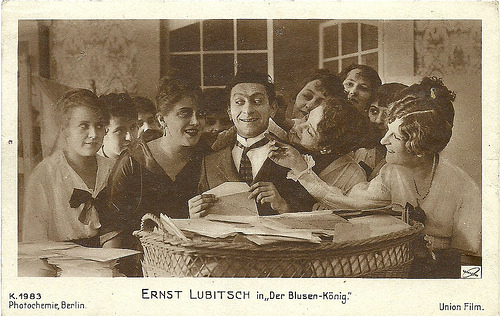
German postcard by Photochemie, no. K. 1983. Photo: Union Film. Ernst Lubitsch in Der Blusen-König (Ernst Lubitsch, 1917). Collection: Didier Hanson.
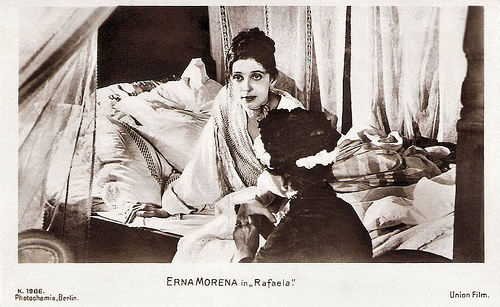
German postcard by Photochemie, Berlin, no. K. 1986. Photo: Union-Film. Publicity still of Erna Morena in Rafaela/Wer weiss? (Arsen von Cserépy, 1917).
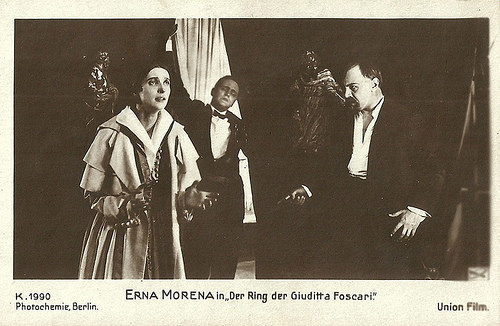
German postcard by Photochemie, Berlin, no. K. 1990. Photo: Union Film. Erna Morena , Emil Jannings and Harry Liedtke in the German silent drama Der Ring der Giuditta Foscari (Alfred Halm, 1917).
Paul Davidson
Paul Davidson (1867–1927) was born in Lötzen, East Prussia (now Giżycko, Poland). He was the son of Moritz Davidson. Paul initially worked as a commercial traveller in the textile industry and he became the manager of a security firm in Frankfurt am Main in 1902.
On vacation to Paris, he saw his first film, a Georges Méliès production, in a cinema. Back in Frankfurt, he founded the 'Allgemeine Kinematographen-Theater Gesellschaft, Union-Theater für lebende und Tonbilder GmbH' (A.K.T.G.) on 21 March 1906 and opened Mannheim’s first permanent cinema, the Union-Theater (U.T.). Further cinemas followed in Frankfurt, Düsseldorf, Cologne, Strasbourg, Amsterdam and Brussels.
Initially his company was based in Frankfurt, but in 1912, Davidson moved his headquarters to Berlin as it was clear that Berlin had become the centre of the German film industry.
In 1909, Davidson transformed the A.K.T.G. into the Projektions-AG 'Union' (PAGU), the first publicly traded film company in Germany. A year later, he started Germany's first distribution company, renting rather than selling outright prints of the heavyweight championship boxing fight between Jack Johnson and James J. Jeffries.
On 4 September 1909, Davidson opened the Union-Theater at Berlin, Alexanderplatz. Another, even more luxurious Union-Theater was opened at Berlin's Unter den Linden on 21 August 1910. By 1910 Davidson had built up a sizeable chain of 600–1000 seater luxury cinemas.
In less than ten years, Paul Davidson had created an empire of over 56 cinemas in Germany, Belgium, and Hungary, drawing 6 million patrons in 1913.
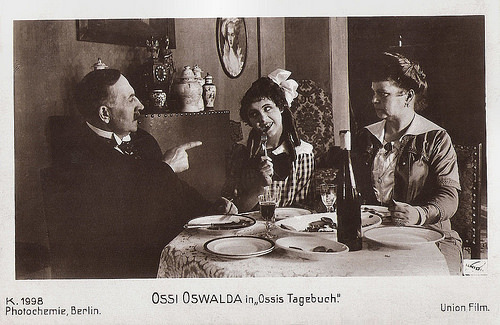
German postcard by Photochemie, Berlin, no. K. 1998. Photo: Union Film. Ossi Oswalda in Ossi's Tagebuch/Ossi's Diary (Ernst Lubitsch, 1917).
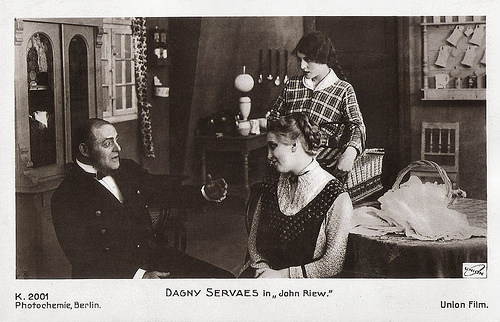
German postcard by Photochemie, Berlin, no. K. 2001. Photo: Union Film. Publicity still for John Riew (Walter Schmidthässler, 1917) with Karl Valentin, Dagny Servaes and Käthe Dorsch .
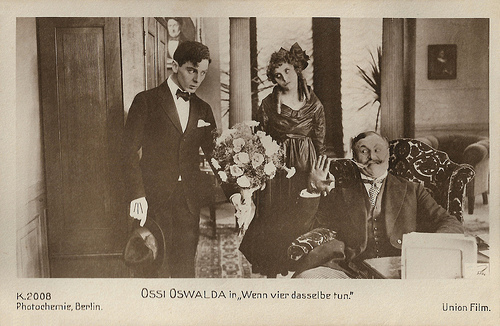
German postcard by Photochemie, Berlin, no. K. 2008. Photo: Union Film. Publicity still for Wenn vier dasselbe tun (Ernst Lubitsch, 1917), starring Ossi Oswalda as the girl, Fritz Schulz (here on the left) as her lover, and Emil Jannings as her father (here on the right).
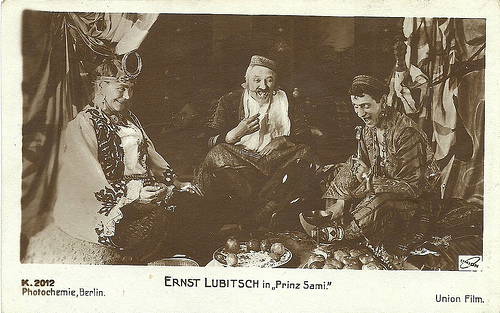
German postcard by Photochemie, Berlin, no. K. 2012. Photo: Union Film. Ernst Lubitsch in Prinz Sami/Prince Sami (Ernst Lubitsch, 1918). Collection: Didier Hanson.
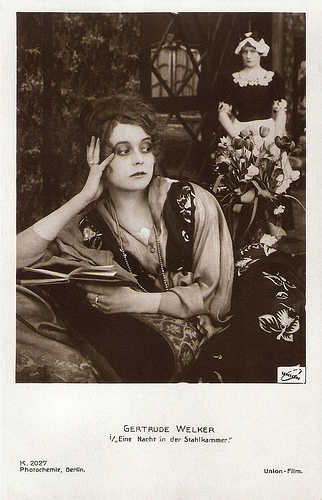
German postcard by Photochemie, Berlin, no. K. 2027. Photo: Union Film. Gertrude Welcker in Eine Nacht in der Stahlkammer/A night in the steel chamber (Felix Basch, 1917).
Asta Nielsen
Paul Davidson had not been thinking about moving into film production himself, but then he saw the first Asta Nielsen film, Afgrunden/The Abyss (Urban Gad, 1910). He realised that the age of short film was past. In Asta Nielsen he also saw the first artist in the medium of film. She was thus the decisive factor for his move to film producing.
In March 1910, Paul Davidson founded the Projektions-Aktiengesellschaft Union (PAGU), Germany’s first joint-stock company in film industry and the first to integrate production, distribution and equipment hire. At the time, the majority of films being shown in Germany were foreign-produced, a situation which Davidson attempted to change.
Following the success of Afgrunden/The Abyss (1910), he founded the Internationale Film-Vertriebs-Gesellschaft in conjunction with Asta Nielsen and her husband Urban Gad on 1 June 1911. The company held the European rights on all Nielsen films.
Davidson instantly felt that the Danish actress could be a global success. It was International film Sales that provided Union with eight Nielsen films per year. Davidson built her a studio in Berlin Tempelhof, later overlooking Berlin’s Tempelhof airport, and set up a big production staff around her. He was confident that Nielsen could carry it off.
Davidson used every available means – and devised many new ones – in order to bring the Asta Nielsen films to the world. It was a success. Asta Nielsen became a sensational international film star with an annual fee of 85,000 Marks in 1914 alone.
Davidson was also notable for his success in breaking a boycott of German playwrights, who were refusing to allow their works to be adapted for the screen. He was even able to persuade the leading German stage director Max Reinhardt to make two films, shot in Italy, for the company. On 2 August 1913 the Union-Palast, Kurfürstendamm, one of the first buildings of Berlin exclusively built as a cinema, premiered with Max Reinhardt’s Die Insel der Seligen/The Islands of Bliss (Max Reinhardt, 1913).
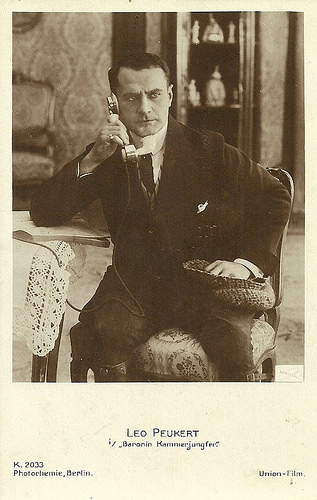
German postcard by Photochemie, Berlin, no. K. 2033. Photo: Union-Film. Leo Peukert in the German silent film Baronin Kammerjungfer (Leo Peukert 1918)
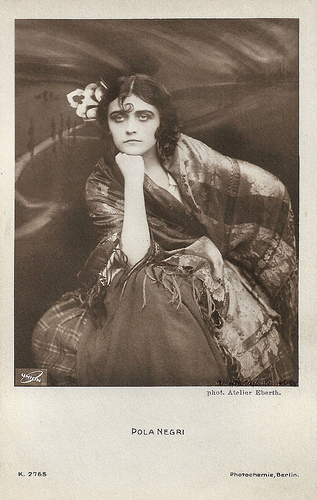
German postcard by Photochemie, Berlin, no. K. 2765. Photo: Atelier Eberth / Union. Pola Negri as Carmen in the German silent drama Carmen (Ernst Lubitsch, 1918).
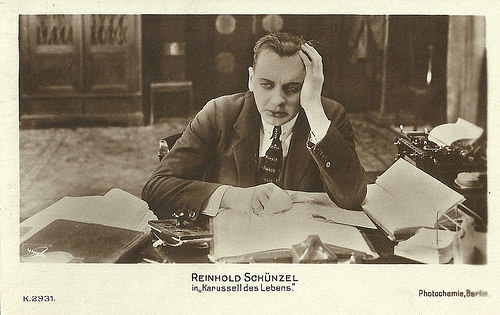
German postcard by Photochemie, Berlin, no. K. 2931. Photo: Union. Reinhold Schünzel in Das Karussell des Lebens (Georg Jacoby, 1918). According to German Wikipedia Schünzel's presence in the film is unsure, but this postcard seems to prove it.
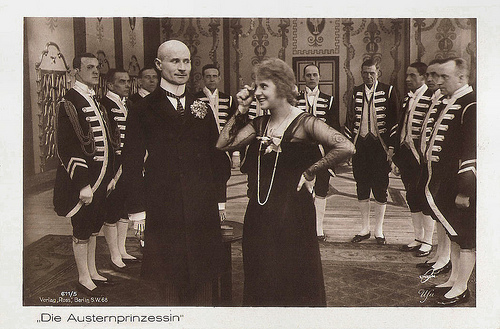
German postcard by Ross Verlag, Berlin, no. 611/5. Photo: Union / Ufa. Julius Falkenstein and Ossi Oswalda in Die Austernprinzessin/The Oyster Princess (Ernst Lubitsch, 1919).
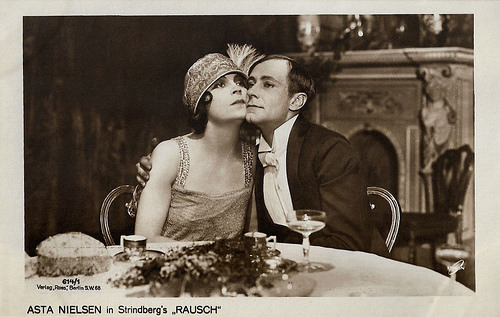
German postcard by Ross Verlag, no. 614/1. Photo: Union. Publicity still with Asta Nielsen and Alfred Abel in Rausch/Intoxication (Ernst Lubitsch, 1919).
Ernst Lubitsch
A financial crisis at the beginning of World War I forced Paul Davidson to sell his cinema chain to the Danish Nordisk Film Company in August 1915.
Davidson decided to focus on film production. His Union Film engaged such actors as Paul Wegener , Fern Andra , Pola Negri , Ossi Oswalda , Emil Jannings , and Harry Liedtke .
The rising star of the company became the actor Ernst Lubitsch who starred in a series of comedies for Union Film. Lubitsch soon also became a director. The position of Union Film was boosted when German government restricted the screening of non-German films because of the war.
Davidson produced propaganda films at the request of the German Military High Command such as Das Tagebuch des Dr. Hart/Dr. Hart's Diary (Paul Leni, 1917). By decree of the German Military High Command, Union became a founder of the new government-backed conglomerate Universum Film A.G. (Ufa) in November 1917.
Many of German's leading production companies were merged into a single organisation which would dominate German cinema for the next thirty years. So, the Nordisk's Union-Theater chain, as well as Davidson's Union were re-united under one roof.
Davidson worked as the Ufa’s artistic director and head of production. Lubitsch and Davidson's films continued to fill the coffers of the Ufa. Now functioning as one of several production units of Ufa, the company made further propaganda films such as Der gelbe Schein/The Yellow Passport (Eugen Illés, Victor Janson, Paul L. Stein, 1918).
Germany's film industry boomed after 1918 and was increasingly artistically respected, partly due to the films produced by Davidson's Union production unit featuring Emil Jannings and Pola Negri .
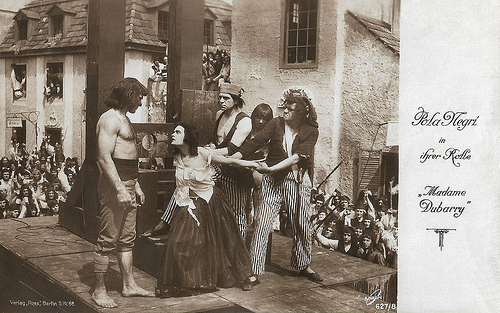
German postcard by Ross Verlag, no. 627/8. Photo: Union. Pola Negri in Madame Dubarry (Ernst Lubitsch, 1918).
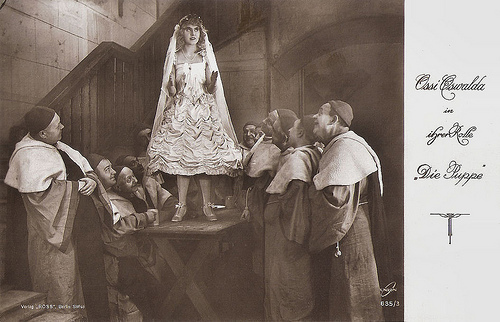
German postcard by Ross Verlag, Berlin, no. 635/3. Photo: Union. Ossi Oswalda in Die Puppe (Ernst Lubitsch, 1919).

German postcard by Ross Verlag, Berlin. Photo: Union Film. Publicity still for Sumurun (Ernst Lubitsch, 1920) with Pola Negri , Paul Wegener and Jenny Hasselqvist .
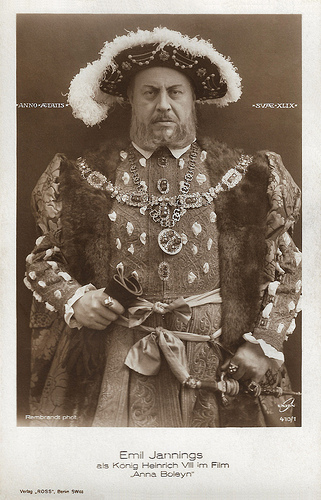
German postcard by Ross Verlag, no. 410/1. Photo: Union-Film. Emil Jannings as Henry VIII in Anna Boleyn (Ernst Lubitsch, 1920).
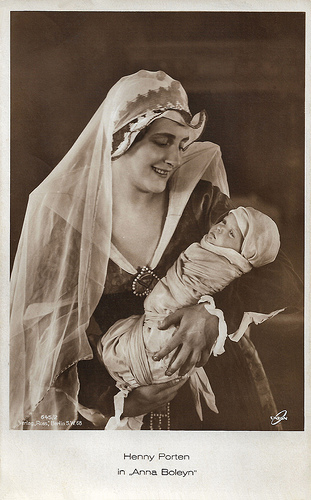
German postcard by Ross Verlag, no. 645/2. Photo: Union Film. Henny Porten as Anna Boleyn in Anna Boleyn (Ernst Lubitsch, 1920).
Paul Davidson
Davidson was unhappy with his subordinate position at Ufa. He made an attempt to buy back Union Film from Ufa, but this was rejected - partly because it was believed he was backed by the large Hollywood studios who wished to gain a foothold in the German market. Soon afterwards Union's existence as a notionally separate company was brought to an end.
In 1920 Paul Davidson left the Ufa to produce Lubitsch’s Das Weib des Pharao/The Wife of the Pharaoh (Ernst Lubitsch, 1920) and Die Flamme/The Flame (Ernst Lubitsch, 1920) within the short-living Europäische Film-Allianz (EFA). When Ernst Lubitsch moved to Hollywood in 1922, Davidson had produced 39 films directed by Lubitsch.
On 7 April 1921, Davidson resigned from his positions as production head and member of the Board of Ufa. Ufa lost its most successful producer, eventually finding a worthy replacement when Erich Pommer joined the studio after the merger with Decla-Bioscop AG in early 1922.
After the failure of the EFA, Davidson founded the Paul-Davidson AG on 17 September 1924, producing films 'independently' within the Ufa.
In the Spring of 1927, he cancelled his contract and entered a mental institution. It was not the first time he had experienced a breakdown. A few months later, on 18 July 1927, Paul Davidson committed suicide at the institution.
Sources: (IMDb), Wikipedia and .

German small photo for the album by Dr. Oskar Kalbus, Vom Werden deutscher Filmkunst, Vol. I, Der Stummfilm (Cigaretten Bilderdienst, 1935). Photo: PAGU. Asta Nielsen in Engelein/The little Angel (Urban Gad, 1914).

Erna Morena . German postcard in the Film Sterne Series by Rotophot, no. 79/5. Photo: Karl Schenker, Berlin / P.A.G. Union. Collection: Didier Hanson.

German postcard by Photochemie, no. K. 1983. Photo: Union Film. Ernst Lubitsch in Der Blusen-König (Ernst Lubitsch, 1917). Collection: Didier Hanson.

German postcard by Photochemie, Berlin, no. K. 1986. Photo: Union-Film. Publicity still of Erna Morena in Rafaela/Wer weiss? (Arsen von Cserépy, 1917).

German postcard by Photochemie, Berlin, no. K. 1990. Photo: Union Film. Erna Morena , Emil Jannings and Harry Liedtke in the German silent drama Der Ring der Giuditta Foscari (Alfred Halm, 1917).
Paul Davidson
Paul Davidson (1867–1927) was born in Lötzen, East Prussia (now Giżycko, Poland). He was the son of Moritz Davidson. Paul initially worked as a commercial traveller in the textile industry and he became the manager of a security firm in Frankfurt am Main in 1902.
On vacation to Paris, he saw his first film, a Georges Méliès production, in a cinema. Back in Frankfurt, he founded the 'Allgemeine Kinematographen-Theater Gesellschaft, Union-Theater für lebende und Tonbilder GmbH' (A.K.T.G.) on 21 March 1906 and opened Mannheim’s first permanent cinema, the Union-Theater (U.T.). Further cinemas followed in Frankfurt, Düsseldorf, Cologne, Strasbourg, Amsterdam and Brussels.
Initially his company was based in Frankfurt, but in 1912, Davidson moved his headquarters to Berlin as it was clear that Berlin had become the centre of the German film industry.
In 1909, Davidson transformed the A.K.T.G. into the Projektions-AG 'Union' (PAGU), the first publicly traded film company in Germany. A year later, he started Germany's first distribution company, renting rather than selling outright prints of the heavyweight championship boxing fight between Jack Johnson and James J. Jeffries.
On 4 September 1909, Davidson opened the Union-Theater at Berlin, Alexanderplatz. Another, even more luxurious Union-Theater was opened at Berlin's Unter den Linden on 21 August 1910. By 1910 Davidson had built up a sizeable chain of 600–1000 seater luxury cinemas.
In less than ten years, Paul Davidson had created an empire of over 56 cinemas in Germany, Belgium, and Hungary, drawing 6 million patrons in 1913.

German postcard by Photochemie, Berlin, no. K. 1998. Photo: Union Film. Ossi Oswalda in Ossi's Tagebuch/Ossi's Diary (Ernst Lubitsch, 1917).

German postcard by Photochemie, Berlin, no. K. 2001. Photo: Union Film. Publicity still for John Riew (Walter Schmidthässler, 1917) with Karl Valentin, Dagny Servaes and Käthe Dorsch .

German postcard by Photochemie, Berlin, no. K. 2008. Photo: Union Film. Publicity still for Wenn vier dasselbe tun (Ernst Lubitsch, 1917), starring Ossi Oswalda as the girl, Fritz Schulz (here on the left) as her lover, and Emil Jannings as her father (here on the right).

German postcard by Photochemie, Berlin, no. K. 2012. Photo: Union Film. Ernst Lubitsch in Prinz Sami/Prince Sami (Ernst Lubitsch, 1918). Collection: Didier Hanson.

German postcard by Photochemie, Berlin, no. K. 2027. Photo: Union Film. Gertrude Welcker in Eine Nacht in der Stahlkammer/A night in the steel chamber (Felix Basch, 1917).
Asta Nielsen
Paul Davidson had not been thinking about moving into film production himself, but then he saw the first Asta Nielsen film, Afgrunden/The Abyss (Urban Gad, 1910). He realised that the age of short film was past. In Asta Nielsen he also saw the first artist in the medium of film. She was thus the decisive factor for his move to film producing.
In March 1910, Paul Davidson founded the Projektions-Aktiengesellschaft Union (PAGU), Germany’s first joint-stock company in film industry and the first to integrate production, distribution and equipment hire. At the time, the majority of films being shown in Germany were foreign-produced, a situation which Davidson attempted to change.
Following the success of Afgrunden/The Abyss (1910), he founded the Internationale Film-Vertriebs-Gesellschaft in conjunction with Asta Nielsen and her husband Urban Gad on 1 June 1911. The company held the European rights on all Nielsen films.
Davidson instantly felt that the Danish actress could be a global success. It was International film Sales that provided Union with eight Nielsen films per year. Davidson built her a studio in Berlin Tempelhof, later overlooking Berlin’s Tempelhof airport, and set up a big production staff around her. He was confident that Nielsen could carry it off.
Davidson used every available means – and devised many new ones – in order to bring the Asta Nielsen films to the world. It was a success. Asta Nielsen became a sensational international film star with an annual fee of 85,000 Marks in 1914 alone.
Davidson was also notable for his success in breaking a boycott of German playwrights, who were refusing to allow their works to be adapted for the screen. He was even able to persuade the leading German stage director Max Reinhardt to make two films, shot in Italy, for the company. On 2 August 1913 the Union-Palast, Kurfürstendamm, one of the first buildings of Berlin exclusively built as a cinema, premiered with Max Reinhardt’s Die Insel der Seligen/The Islands of Bliss (Max Reinhardt, 1913).

German postcard by Photochemie, Berlin, no. K. 2033. Photo: Union-Film. Leo Peukert in the German silent film Baronin Kammerjungfer (Leo Peukert 1918)

German postcard by Photochemie, Berlin, no. K. 2765. Photo: Atelier Eberth / Union. Pola Negri as Carmen in the German silent drama Carmen (Ernst Lubitsch, 1918).

German postcard by Photochemie, Berlin, no. K. 2931. Photo: Union. Reinhold Schünzel in Das Karussell des Lebens (Georg Jacoby, 1918). According to German Wikipedia Schünzel's presence in the film is unsure, but this postcard seems to prove it.

German postcard by Ross Verlag, Berlin, no. 611/5. Photo: Union / Ufa. Julius Falkenstein and Ossi Oswalda in Die Austernprinzessin/The Oyster Princess (Ernst Lubitsch, 1919).

German postcard by Ross Verlag, no. 614/1. Photo: Union. Publicity still with Asta Nielsen and Alfred Abel in Rausch/Intoxication (Ernst Lubitsch, 1919).
Ernst Lubitsch
A financial crisis at the beginning of World War I forced Paul Davidson to sell his cinema chain to the Danish Nordisk Film Company in August 1915.
Davidson decided to focus on film production. His Union Film engaged such actors as Paul Wegener , Fern Andra , Pola Negri , Ossi Oswalda , Emil Jannings , and Harry Liedtke .
The rising star of the company became the actor Ernst Lubitsch who starred in a series of comedies for Union Film. Lubitsch soon also became a director. The position of Union Film was boosted when German government restricted the screening of non-German films because of the war.
Davidson produced propaganda films at the request of the German Military High Command such as Das Tagebuch des Dr. Hart/Dr. Hart's Diary (Paul Leni, 1917). By decree of the German Military High Command, Union became a founder of the new government-backed conglomerate Universum Film A.G. (Ufa) in November 1917.
Many of German's leading production companies were merged into a single organisation which would dominate German cinema for the next thirty years. So, the Nordisk's Union-Theater chain, as well as Davidson's Union were re-united under one roof.
Davidson worked as the Ufa’s artistic director and head of production. Lubitsch and Davidson's films continued to fill the coffers of the Ufa. Now functioning as one of several production units of Ufa, the company made further propaganda films such as Der gelbe Schein/The Yellow Passport (Eugen Illés, Victor Janson, Paul L. Stein, 1918).
Germany's film industry boomed after 1918 and was increasingly artistically respected, partly due to the films produced by Davidson's Union production unit featuring Emil Jannings and Pola Negri .

German postcard by Ross Verlag, no. 627/8. Photo: Union. Pola Negri in Madame Dubarry (Ernst Lubitsch, 1918).

German postcard by Ross Verlag, Berlin, no. 635/3. Photo: Union. Ossi Oswalda in Die Puppe (Ernst Lubitsch, 1919).

German postcard by Ross Verlag, Berlin. Photo: Union Film. Publicity still for Sumurun (Ernst Lubitsch, 1920) with Pola Negri , Paul Wegener and Jenny Hasselqvist .

German postcard by Ross Verlag, no. 410/1. Photo: Union-Film. Emil Jannings as Henry VIII in Anna Boleyn (Ernst Lubitsch, 1920).

German postcard by Ross Verlag, no. 645/2. Photo: Union Film. Henny Porten as Anna Boleyn in Anna Boleyn (Ernst Lubitsch, 1920).
Paul Davidson
Davidson was unhappy with his subordinate position at Ufa. He made an attempt to buy back Union Film from Ufa, but this was rejected - partly because it was believed he was backed by the large Hollywood studios who wished to gain a foothold in the German market. Soon afterwards Union's existence as a notionally separate company was brought to an end.
In 1920 Paul Davidson left the Ufa to produce Lubitsch’s Das Weib des Pharao/The Wife of the Pharaoh (Ernst Lubitsch, 1920) and Die Flamme/The Flame (Ernst Lubitsch, 1920) within the short-living Europäische Film-Allianz (EFA). When Ernst Lubitsch moved to Hollywood in 1922, Davidson had produced 39 films directed by Lubitsch.
On 7 April 1921, Davidson resigned from his positions as production head and member of the Board of Ufa. Ufa lost its most successful producer, eventually finding a worthy replacement when Erich Pommer joined the studio after the merger with Decla-Bioscop AG in early 1922.
After the failure of the EFA, Davidson founded the Paul-Davidson AG on 17 September 1924, producing films 'independently' within the Ufa.
In the Spring of 1927, he cancelled his contract and entered a mental institution. It was not the first time he had experienced a breakdown. A few months later, on 18 July 1927, Paul Davidson committed suicide at the institution.
Sources: (IMDb), Wikipedia and .
Published on March 22, 2019 23:00
March 21, 2019
Cary Grant
Handsome, suave English-American actor Cary Grant (1904-1986) became one of Hollywood's definitive classic leading men, known for his debonair demeanour. Grant’s best-known films include Bringing Up Baby (1938), The Philadelphia Story (1940), His Girl Friday (1940), Notorious (1946), An Affair to Remember (1957), North by Northwest (1959), and Charade (1963).
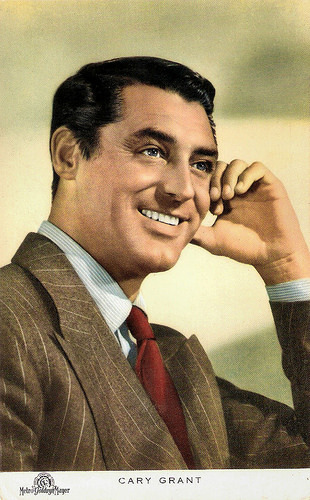
Belgian postcard by N.V. Victoria, Brussels, no. 639. Photo: Metro-Goldwyn-Mayer.
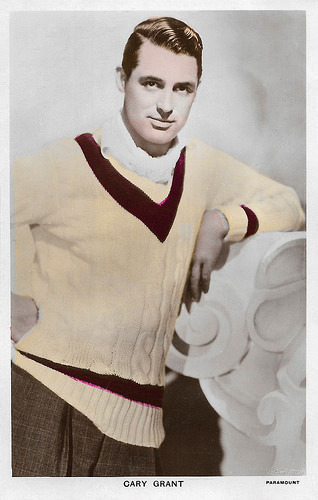
British postcard in the Colourgraph Series, London, no. C 213. Photo: Paramount.
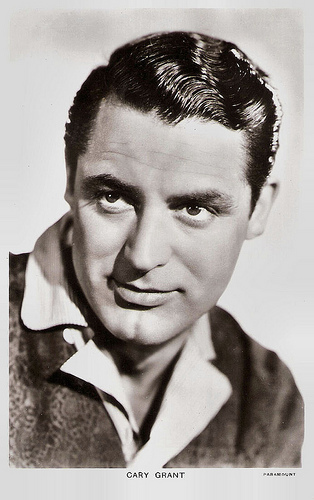
British Real Photo postcard in the Picturegoer Series, London, no. 735b. Photo: Paramount.
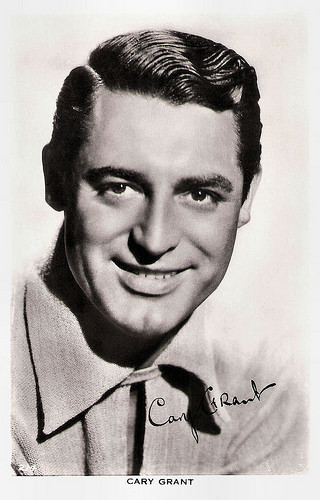
British Real Photograph postcard, no. 214.
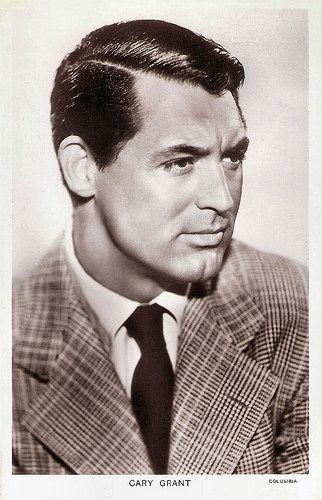
British postcard in the Picturegoer Series, London, no. 735c. Photo: Columbia.
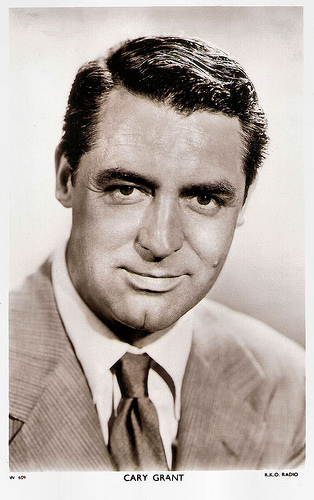
British postcard in the Picturegoer Series, London, no. W 609. Photo: R.K.O. Radio.
The combination of virility, sexuality and the aura and bearing of a gentleman
Cary Grant was born Archibald Alexander Leach in Horfield, Bristol, England, in 1904. His parents were Elsie Maria (Kingdon) and Elias James Leach, who worked in a factory. Grant considered himself to have been partly Jewish.
He had an unhappy upbringing in Bristol. At age nine, he came home from school one day and was told his mother had gone off to a seaside resort. The real truth, however, was that she had been placed in a mental institution, where she would remain for years, and he was never told about it. Grant did not learn that his mother was still alive until he was 31, when his father confessed to the lie, shortly before his own death.
At age 14, Archibald dropped out of school. He lied about his age and forged his father's signature on a letter to join Bob Pender's troupe of knockabout comedians. He learned pantomime as well as acrobatics as he toured with the Pender troupe in the English provinces. Then in 1920, he was one of the eight Pender boys selected to go to the US. Their show on Broadway, Good Times, ran for 456 performances at the New York Hippodrome (the largest theatre in the world at the time with a capacity of 5,697), giving Grant time to acclimatise.
He would stay in America. Grant spent the next couple of years touring the United States with The Walking Stanleys. He visited Los Angeles for the first time in 1924, which left a lasting impression upon him. After the group split up he returned to New York, where he began living and performing at the National Vaudeville Artists Club. In 1927, he was cast as an Australian in Reggie Hammerstein's musical, Golden Dawn.
In the following years he gained a reputation as a romantic leading man. After a successful screen-test, Paramount producer Bud Schulberg signed a contract with the 27-year-old Grant in 1931 for five years. He made his feature film debut with the comedy This is the Night (Frank Tuttle, 1932), playing an Olympic javelin thrower opposite Thelma Todd and Lily Damita .
Grant played a wealthy playboy opposite Marlene Dietrich in Blonde Venus (1932), directed by Josef von Sternberg. Mae West wanted Grant for She Done Him Wrong (Lowell Sherman, 1933) because she saw his combination of virility, sexuality and the aura and bearing of a gentleman. The film was a box office hit, earning more than $2 million in the United States. For their next pairing, I'm No Angel (Wesley Ruggles, 1934), Grant's salary was increased from $450 to $750 a week. The film was even more successful than She Done Him Wrong, and saved Paramount from bankruptcy.
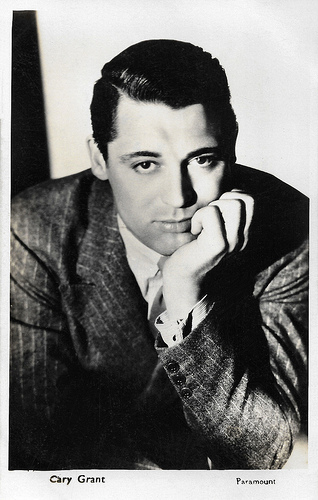
British Real Photograph postcard. Photo: Paramount.
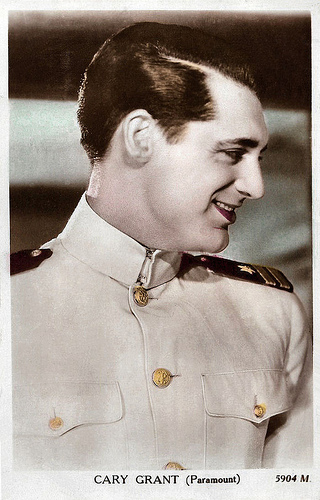
British Art Photo postcard, no. 5904 M. Photo: Paramount. Publicity still for Devil and the Deep (Marion Gehring, 1932).
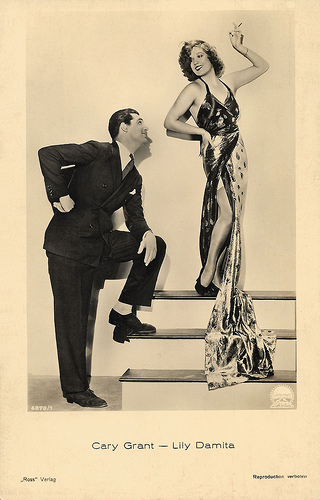
German postcard by Ross Verlag, no. 6870/1, 1931-1932. Photo: Paramount. Publicity still for This is the Night (Frank Tuttle, 1932) with Lily Damita .
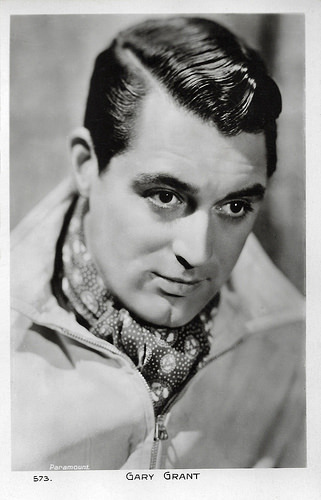
French postcard by Editions Chantal, Paris, no. 573. Photo: Paramount.
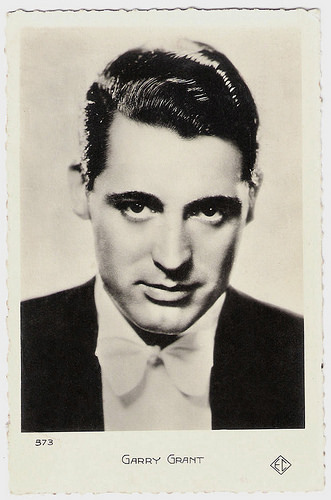
French postcard by Editions E.C., Paris, no. 373.
A leopard and frequent bickering and verbal jousting
When the Paramount contract was up, Cary Grant made an unusual decision for the time: he decided to freelance. Because his films were so successful at the box office, he was able to work at any studio he chose for the majority of his career.
For Hal Roach's studio he made the screwball comedy Topper (Norman Z. McLeod, 1937), which became his first major comedy success. The following year, he starred opposite Katharine Hepburn in the screwball comedy Bringing Up Baby (Howard Hawks, 1938), featuring a leopard and frequent bickering and verbal jousting between Grant and Hepburn.
He played a British army sergeant opposite Douglas Fairbanks, Jr. in the adventure film Gunga Din (George Stevens, 1939), set at a military station in India, and he was a pilot opposite Jean Arthur and Rita Hayworth in the drama Only Angels Have Wings (Howard Hawks, 1939). Grant gained even more success for his appearances in the romantic comedies His Girl Friday (Howard Hawks, 1940) with Rosalind Russell, and The Philadelphia Story (George Cukor, 1940) with Katharine Hepburn and James Stewart.
Along with Arsenic and Old Lace (Frank Capra, 1944) and I Was a Male War Bride (Howard Hawks, 1949); these films are among the all-time great comedy films. Having established himself as a major Hollywood star, he was nominated twice for the Academy Award for Best Actor, for Penny Serenade (George Stevens, 1941) and None but the Lonely Heart (Clifford Odets, 1944).
In the 1940s, Grant also started a working relationship with director Alfred Hitchcock, appearing in films such as Suspicion (1941) opposite Joan Fontaine, and Notorious (1946) opposite Ingrid Bergman . Hitchcock admired Grant and considered him to have been the only actor that he had ever loved working with.
In To Catch a Thief (1955), he and Grace Kelly were allowed to improvise some of the dialogue. They knew what Hitchcock wanted to do with a scene, they rehearsed it, put in some clever double entendres that got past the censors, and then the scene was filmed. His biggest box-office success was Hitchcock’s North by Northwest (1959) made with Eva Marie Saint since Kelly was by that time Princess of Monaco.
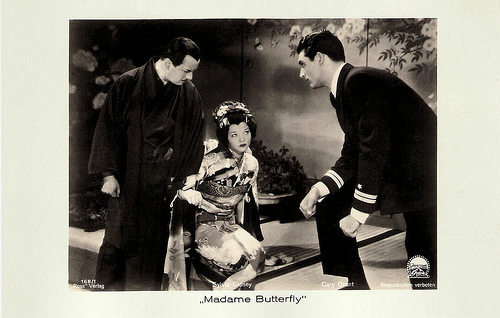
German postcard by Ross Verlag, no. 168/1. Photo: Paramount. Publicity still for Madame Butterfly (Marion Gering, 1932) with Sylvia Sidney.
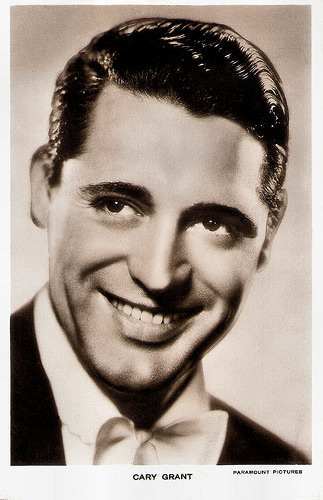
British Real Photo postcard. Photo: Paramount Pictures.
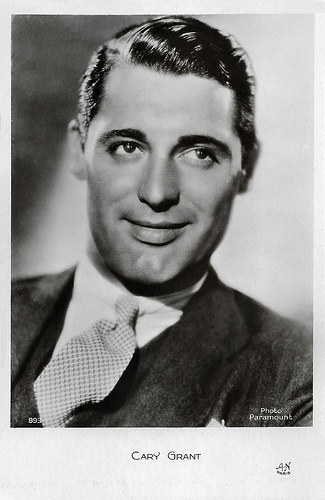
French postcard by A.N., Paris, no. 893. Photo: Paramount.
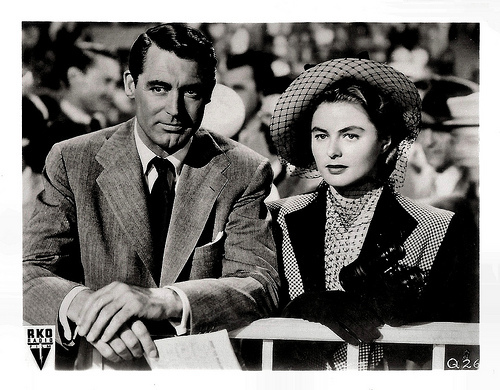
German collectors card. Photo: RKO Radio Film. Publicity still for Notorious (Alfred Hitchcock, 1946) with Ingrid Bergman .
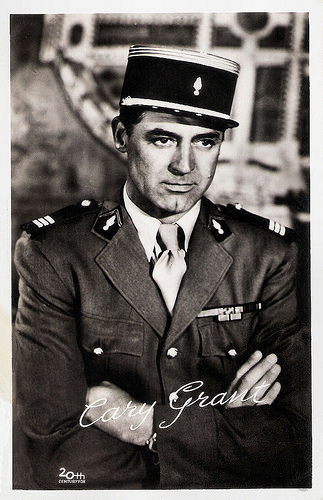
Dutch postcard, no. 3286. Photo: 20th Century Fox. Publicity still for I Was a Male War Bride (Howard Hawks, 1949).
Marriages, living arrangements and fatherhood
Cary Grant was young enough to begin the new career of fatherhood when he stopped making films at age 62. Grant retired from the screen at 62, when his daughter Jennifer was born, to focus on bringing her up and to provide a sense of permanency and stability in her life.
Although Grant had retired from the screen, he remained active. In 1966, he accepted a position on the board of directors at Fabergé. By all accounts this position was not honorary, as some had assumed; Grant regularly attended meetings and travelled internationally to support them. The position also permitted use of a private plane, which Grant could use to fly to see his daughter wherever her mother, Dyan Cannon, was working.
He later joined the boards of Hollywood Park, the Academy of Magical Arts (The Magic Castle, Hollywood, California), Western Airlines (acquired by Delta Air Lines in 1987), and MGM. In 1999, the American Film Institute named Grant the second greatest male star of Golden Age Hollywood cinema (after Humphrey Bogart). He was nominated twice for the Academy Award for Best Actor and five times for a Golden Globe Award for Best Actor. After his retirement from film in 1966, Grant was presented with an Honorary Oscar in 1970.
He expressed no interest in making a career comeback. He was in good health until almost the end of his life, when he suffered a mild stroke in October 1984. His final appearance at the Academy Awards was in 1985 to present James Stewart with an honorary Oscar for lifetime achievement. In the last few years of his life, Grant undertook tours of the United States in a one-man show, 'A Conversation with Cary Grant', in which he would show clips from his films and answer audience questions.
In 1986, Grant suffered a major stroke prior to performing in his one man show in Davenport, Iowa. He died later that night at St. Luke's Hospital. Grant had been married five times. His wives were actress Virginia Cherrill (1934-1935), Barbara Hutton (1942-1945), actress Betsy Drake (1949-1962), actress Dyan Cannon (1965-1968), and Barbara Harris (1981-1986).
From 1932 till 1944 he shared a house with Randolph Scott, whom he met on Hot Saturday (1932). Studio heads threatened not to employ them together, unless they lived separately. Grant's marriage to Barbara Hutton permanently dissolved his living arrangement with Scott. Grant later fell in love with Sophia Loren while filming The Pride and the Passion (1957) when he was 53 and she was 22. At the time, Grant was still married to actress Betsy Drake, and Loren was involved with 45-year-old producer Carlo Ponti, who was also married. Both men eventually separated from their wives and proposed to Loren at the same time; she chose Ponti.
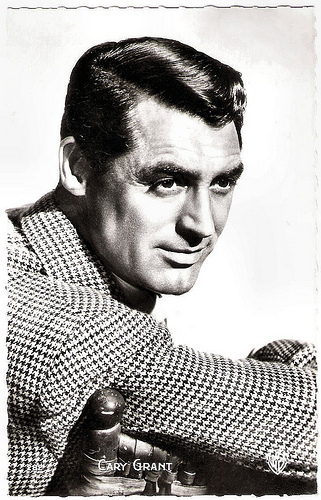
French postcard by Editions P.I., Paris, no. 287. Photo: Warner Bros.
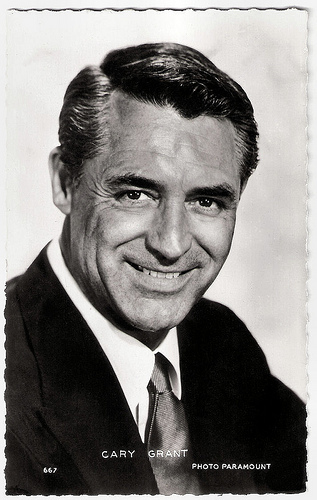
French postcard by Editions P.I., Paris, offered by Les Carbones Korès 'Carboplane', no. 667. Photo: Paramount, 1951.
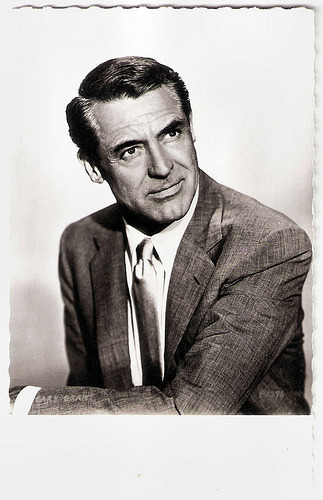
French postcard by Editions P.I., Paris, offered by Les Carbones Korès 'Carboplane', no. 999. Photo: Paramount. Publicity still for Houseboat (Melville Shavelson, 1958).
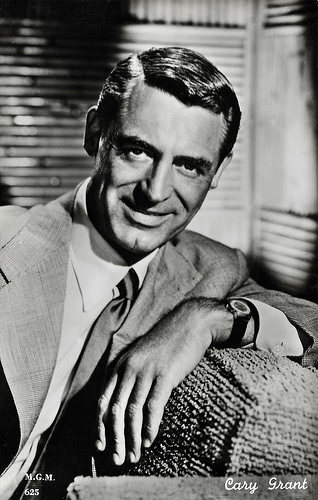
Vintage card, no. 625. Photo: M.G.M.
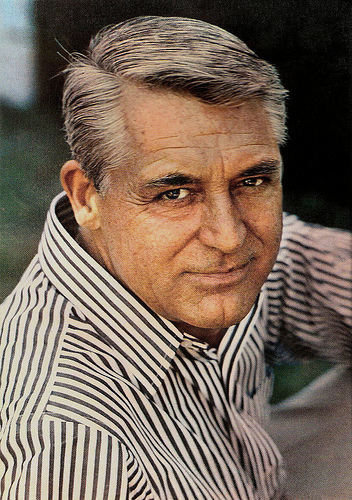
Italian postcard by Rotalfoto, no. N. 207.
Sources: (IMDb), Wikipedia and .

Belgian postcard by N.V. Victoria, Brussels, no. 639. Photo: Metro-Goldwyn-Mayer.

British postcard in the Colourgraph Series, London, no. C 213. Photo: Paramount.

British Real Photo postcard in the Picturegoer Series, London, no. 735b. Photo: Paramount.

British Real Photograph postcard, no. 214.

British postcard in the Picturegoer Series, London, no. 735c. Photo: Columbia.

British postcard in the Picturegoer Series, London, no. W 609. Photo: R.K.O. Radio.
The combination of virility, sexuality and the aura and bearing of a gentleman
Cary Grant was born Archibald Alexander Leach in Horfield, Bristol, England, in 1904. His parents were Elsie Maria (Kingdon) and Elias James Leach, who worked in a factory. Grant considered himself to have been partly Jewish.
He had an unhappy upbringing in Bristol. At age nine, he came home from school one day and was told his mother had gone off to a seaside resort. The real truth, however, was that she had been placed in a mental institution, where she would remain for years, and he was never told about it. Grant did not learn that his mother was still alive until he was 31, when his father confessed to the lie, shortly before his own death.
At age 14, Archibald dropped out of school. He lied about his age and forged his father's signature on a letter to join Bob Pender's troupe of knockabout comedians. He learned pantomime as well as acrobatics as he toured with the Pender troupe in the English provinces. Then in 1920, he was one of the eight Pender boys selected to go to the US. Their show on Broadway, Good Times, ran for 456 performances at the New York Hippodrome (the largest theatre in the world at the time with a capacity of 5,697), giving Grant time to acclimatise.
He would stay in America. Grant spent the next couple of years touring the United States with The Walking Stanleys. He visited Los Angeles for the first time in 1924, which left a lasting impression upon him. After the group split up he returned to New York, where he began living and performing at the National Vaudeville Artists Club. In 1927, he was cast as an Australian in Reggie Hammerstein's musical, Golden Dawn.
In the following years he gained a reputation as a romantic leading man. After a successful screen-test, Paramount producer Bud Schulberg signed a contract with the 27-year-old Grant in 1931 for five years. He made his feature film debut with the comedy This is the Night (Frank Tuttle, 1932), playing an Olympic javelin thrower opposite Thelma Todd and Lily Damita .
Grant played a wealthy playboy opposite Marlene Dietrich in Blonde Venus (1932), directed by Josef von Sternberg. Mae West wanted Grant for She Done Him Wrong (Lowell Sherman, 1933) because she saw his combination of virility, sexuality and the aura and bearing of a gentleman. The film was a box office hit, earning more than $2 million in the United States. For their next pairing, I'm No Angel (Wesley Ruggles, 1934), Grant's salary was increased from $450 to $750 a week. The film was even more successful than She Done Him Wrong, and saved Paramount from bankruptcy.

British Real Photograph postcard. Photo: Paramount.

British Art Photo postcard, no. 5904 M. Photo: Paramount. Publicity still for Devil and the Deep (Marion Gehring, 1932).

German postcard by Ross Verlag, no. 6870/1, 1931-1932. Photo: Paramount. Publicity still for This is the Night (Frank Tuttle, 1932) with Lily Damita .

French postcard by Editions Chantal, Paris, no. 573. Photo: Paramount.

French postcard by Editions E.C., Paris, no. 373.
A leopard and frequent bickering and verbal jousting
When the Paramount contract was up, Cary Grant made an unusual decision for the time: he decided to freelance. Because his films were so successful at the box office, he was able to work at any studio he chose for the majority of his career.
For Hal Roach's studio he made the screwball comedy Topper (Norman Z. McLeod, 1937), which became his first major comedy success. The following year, he starred opposite Katharine Hepburn in the screwball comedy Bringing Up Baby (Howard Hawks, 1938), featuring a leopard and frequent bickering and verbal jousting between Grant and Hepburn.
He played a British army sergeant opposite Douglas Fairbanks, Jr. in the adventure film Gunga Din (George Stevens, 1939), set at a military station in India, and he was a pilot opposite Jean Arthur and Rita Hayworth in the drama Only Angels Have Wings (Howard Hawks, 1939). Grant gained even more success for his appearances in the romantic comedies His Girl Friday (Howard Hawks, 1940) with Rosalind Russell, and The Philadelphia Story (George Cukor, 1940) with Katharine Hepburn and James Stewart.
Along with Arsenic and Old Lace (Frank Capra, 1944) and I Was a Male War Bride (Howard Hawks, 1949); these films are among the all-time great comedy films. Having established himself as a major Hollywood star, he was nominated twice for the Academy Award for Best Actor, for Penny Serenade (George Stevens, 1941) and None but the Lonely Heart (Clifford Odets, 1944).
In the 1940s, Grant also started a working relationship with director Alfred Hitchcock, appearing in films such as Suspicion (1941) opposite Joan Fontaine, and Notorious (1946) opposite Ingrid Bergman . Hitchcock admired Grant and considered him to have been the only actor that he had ever loved working with.
In To Catch a Thief (1955), he and Grace Kelly were allowed to improvise some of the dialogue. They knew what Hitchcock wanted to do with a scene, they rehearsed it, put in some clever double entendres that got past the censors, and then the scene was filmed. His biggest box-office success was Hitchcock’s North by Northwest (1959) made with Eva Marie Saint since Kelly was by that time Princess of Monaco.

German postcard by Ross Verlag, no. 168/1. Photo: Paramount. Publicity still for Madame Butterfly (Marion Gering, 1932) with Sylvia Sidney.

British Real Photo postcard. Photo: Paramount Pictures.

French postcard by A.N., Paris, no. 893. Photo: Paramount.

German collectors card. Photo: RKO Radio Film. Publicity still for Notorious (Alfred Hitchcock, 1946) with Ingrid Bergman .

Dutch postcard, no. 3286. Photo: 20th Century Fox. Publicity still for I Was a Male War Bride (Howard Hawks, 1949).
Marriages, living arrangements and fatherhood
Cary Grant was young enough to begin the new career of fatherhood when he stopped making films at age 62. Grant retired from the screen at 62, when his daughter Jennifer was born, to focus on bringing her up and to provide a sense of permanency and stability in her life.
Although Grant had retired from the screen, he remained active. In 1966, he accepted a position on the board of directors at Fabergé. By all accounts this position was not honorary, as some had assumed; Grant regularly attended meetings and travelled internationally to support them. The position also permitted use of a private plane, which Grant could use to fly to see his daughter wherever her mother, Dyan Cannon, was working.
He later joined the boards of Hollywood Park, the Academy of Magical Arts (The Magic Castle, Hollywood, California), Western Airlines (acquired by Delta Air Lines in 1987), and MGM. In 1999, the American Film Institute named Grant the second greatest male star of Golden Age Hollywood cinema (after Humphrey Bogart). He was nominated twice for the Academy Award for Best Actor and five times for a Golden Globe Award for Best Actor. After his retirement from film in 1966, Grant was presented with an Honorary Oscar in 1970.
He expressed no interest in making a career comeback. He was in good health until almost the end of his life, when he suffered a mild stroke in October 1984. His final appearance at the Academy Awards was in 1985 to present James Stewart with an honorary Oscar for lifetime achievement. In the last few years of his life, Grant undertook tours of the United States in a one-man show, 'A Conversation with Cary Grant', in which he would show clips from his films and answer audience questions.
In 1986, Grant suffered a major stroke prior to performing in his one man show in Davenport, Iowa. He died later that night at St. Luke's Hospital. Grant had been married five times. His wives were actress Virginia Cherrill (1934-1935), Barbara Hutton (1942-1945), actress Betsy Drake (1949-1962), actress Dyan Cannon (1965-1968), and Barbara Harris (1981-1986).
From 1932 till 1944 he shared a house with Randolph Scott, whom he met on Hot Saturday (1932). Studio heads threatened not to employ them together, unless they lived separately. Grant's marriage to Barbara Hutton permanently dissolved his living arrangement with Scott. Grant later fell in love with Sophia Loren while filming The Pride and the Passion (1957) when he was 53 and she was 22. At the time, Grant was still married to actress Betsy Drake, and Loren was involved with 45-year-old producer Carlo Ponti, who was also married. Both men eventually separated from their wives and proposed to Loren at the same time; she chose Ponti.

French postcard by Editions P.I., Paris, no. 287. Photo: Warner Bros.

French postcard by Editions P.I., Paris, offered by Les Carbones Korès 'Carboplane', no. 667. Photo: Paramount, 1951.

French postcard by Editions P.I., Paris, offered by Les Carbones Korès 'Carboplane', no. 999. Photo: Paramount. Publicity still for Houseboat (Melville Shavelson, 1958).

Vintage card, no. 625. Photo: M.G.M.

Italian postcard by Rotalfoto, no. N. 207.
Sources: (IMDb), Wikipedia and .
Published on March 21, 2019 23:00
March 20, 2019
Harold Lloyd
American actor, comedian, director, producer, screenwriter, and stunt performer Harold Lloyd (1893-1971) is best known for his silent comedies. He ranks alongside Charlie Chaplin and Buster Keaton as one of the three most popular and influential comedians of the silent film. Between 1914 and 1947, Lloyd made nearly 200 comedies, often as a bespectacled 'Glass' character, a resourceful, success-seeking go-getter who was perfectly in tune with 1920s-era United States. His films frequently contained 'thrill sequences' of extended chase scenes and daredevil physical feats. A classic is Lloyd hanging from the hands of a clock high above the street in Safety Last! (1923).
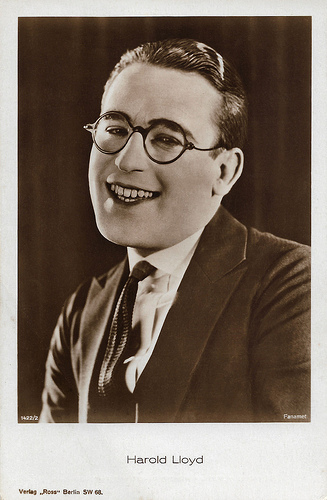
German postcard by Ross Verlag, no. 1422/2, 1927-1928. Photo: Fanamet.
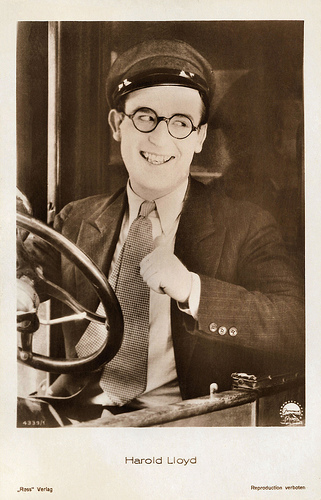
German postcard by Ross Verlag, no. 4339/1, 1929-1930. Photo: Paramount. Publicity still for Speedy (Ted Wilde, 1928).
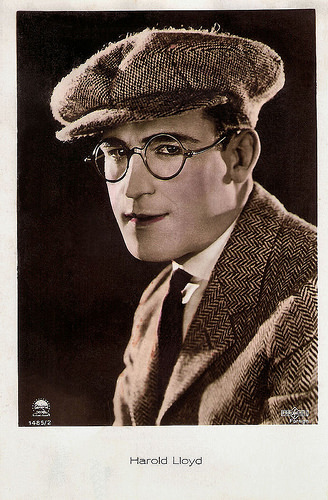
German postcard by Ross Verlag, Foreign, no. 1485/2, 1927-1928. Photo: Paramount / Parufamet.
Lonesome Luke
Harold Clayton Lloyd was born in 1893 in Burchard, Nebraska, the son of James Darsie Lloyd and Sarah Elisabeth Fraser. In 1910, after his father had several business ventures fail, Lloyd's parents divorced and his father moved with his son to San Diego, California.
Lloyd had acted in theatre since he was a child, and in San Diego he received his stage training at the School of Dramatic Art and began acting in one-reel film comedies around 1912. Lloyd worked with Thomas Edison's motion picture company, and his first role was a bit part as a Yaqui Indian in The Old Monk's Tale (J. Searle Dawley, 1913).
At the age of 20, Lloyd moved to Los Angeles, and took up roles in several Keystone comedies. He was also hired by Universal Studios as an extra. Lloyd began collaborating with his friend Hal Roach who had formed his own studio in 1913. They created Will E. Work and then Lonesome Luke, variations of Charles Chaplin 's Little Tramp character.
In 1914, Lloyd hired Bebe Daniels as a supporting actress. The two were involved romantically and were known as 'The Boy and The Girl'. In 1919, she left him after it became apparent he was unable to make a commitment, and she pursued her dramatic aspirations. Later that year, Lloyd replaced Daniels with Mildred Davis, whom he would marry in 1923.
By 1918, Lloyd and Roach had begun to develop a new character beyond an imitation of his contemporaries. Harold Lloyd would move away from tragicomic personas, and portray an everyman with unwavering confidence and optimism. The persona Lloyd referred to as his 'Glass' character was a much more mature comedy character with greater potential for sympathy and emotional depth, and was easy for audiences of the time to identify with. To create his new character Lloyd donned a pair of lensless horn-rimmed eyeglasses but wore normal clothing. Previously, he had worn a fake moustache and ill-fitting clothes as the Chaplinesque Lonesome Luke.
In August 1919, while posing for some promotional still photographs in the Los Angeles Witzel Photography Studio, he was seriously injured holding a prop bomb thought merely to be a smoke pot. It exploded and mangled his right hand, causing him to lose a thumb and forefinger. The blast was severe enough that the cameraman and prop director nearby were also seriously injured. Lloyd was in the act of lighting a cigarette from the fuse of the bomb when it exploded, also badly burning his face and chest and injuring his eye. Despite the proximity of the blast to his face, he retained his sight.
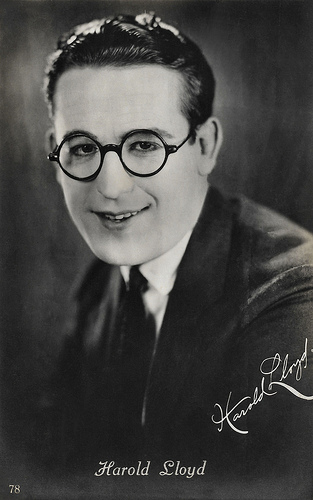
Italian postcard by Ed. A. Traldi, Milano, no. 78.
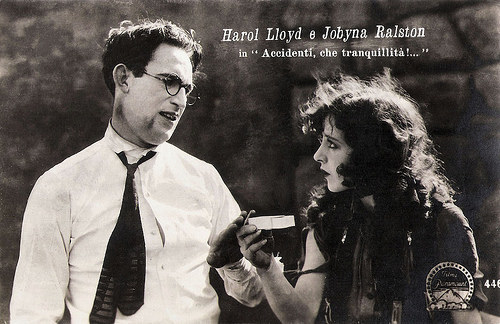
Italian postcard by Casa Editrice Ballerini & Fratini, Firenze (B.F.F.), no. 446. Photo: Paramount. Publicity still for Why Worry (Fred C. Newmeyer, Sam Taylor, 1923) with Jobyna Ralston.
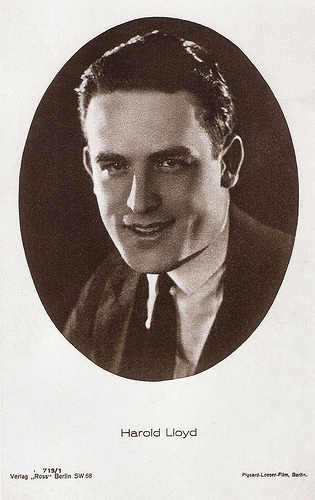
German postcard by Ross Verlag, no. 719/1, 1925-1926. Photo: Pigeard-Loeser-Film, Berlin.
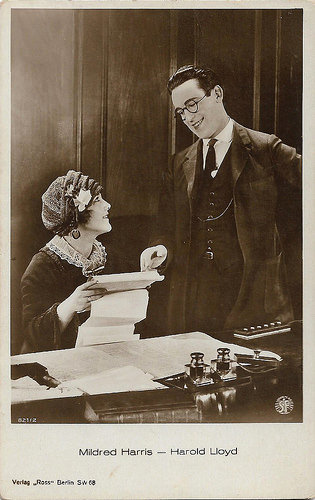
German postcard by Ross Verlag, no. 821/2, 1925-1926. Photo: S.F. (Südfilm A.G.). This postcard, with a picture from Safety Last (Fred Newmeyer, Sam Taylor, 1923), erroneously mentions the actress as Mildred Harris, while she really is Mildred Davis, Lloyd's wife. Many sources today still confound the two actresses.
The Freshman
Beginning in 1921, Harold Lloyd and Hal Roach moved from shorts to feature-length comedies. These included the acclaimed Grandma's Boy, which pioneered the combination of complex character development and film comedy, the highly popular Safety Last! (Fred C. Newmeyer, Sam Taylor, 1923), which cemented Lloyd's stardom, and Why Worry? (Fred C. Newmeyer, Sam Taylor, 1923).
Lloyd and Roach parted ways in 1924, and Lloyd became the independent producer of his own films. These included his most accomplished mature features Girl Shy (Fred C. Newmeyer, Sam Taylor, 1924), The Freshman (Fred C. Newmeyer, Sam Taylor, 1925) - his highest-grossing silent feature, The Kid Brother (Ted Wilde, J.A. Howe, 1927), and Speedy (Ted Wilde, 1928), his final silent film.
Welcome Danger (Clyde Bruckman, 1929) was originally a silent film but Lloyd decided late in the production to remake it with dialogue. All of these films were enormously successful and profitable, and Lloyd would eventually become the highest paid film performer of the 1920s. Although Lloyd's individual films were not as commercially successful as Charles Chaplin 's on average, he was far more prolific (releasing 12 feature films in the 1920s while Chaplin released just four), and made more money overall ($15.7 million to Chaplin's $10.5 million).
The huge financial success of Welcome Danger had proved that audiences were eager to hear Lloyd's voice on film. Lloyd's rate of film releases, which had been one or two a year in the 1920s, slowed to about one every two years until 1938. The films released during this period were: Feet First (Clyde Bruckman, 1930), with a similar scenario to Safety Last which found him clinging to a skyscraper at the climax; Movie Crazy (Clyde Bruckman, 1932) with Constance Cummings; The Cat's-Paw (Sam Taylor, 1934), which was a dark political comedy and a big departure for Lloyd; and The Milky Way (Leo McCarey, 1936), which was Lloyd's only attempt at the fashionable genre of the screwball comedy film.
However, his go-getting screen character was out of touch with Great Depression movie audiences of the 1930s. As the length of time between his film releases increased, his popularity declined, as did the fortunes of his production company. His final film of the decade, Professor Beware (Elliott Nugent, 1938), was made by the Paramount staff, with Lloyd functioning only as actor and partial financier.
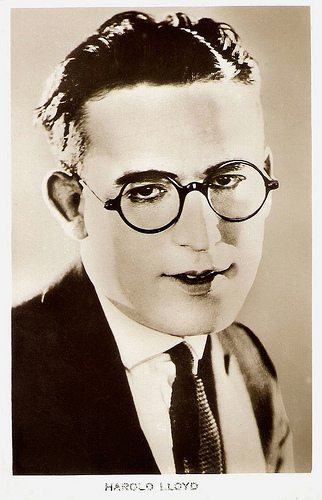
British Real Photograph postcard.
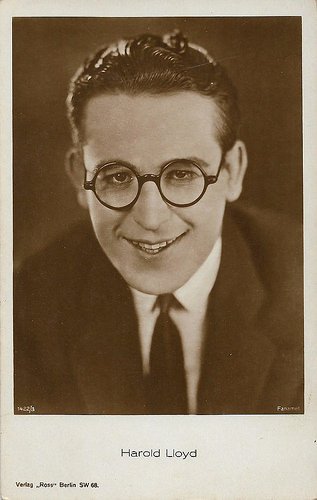
German postcard by Ross Verlag, no. 1422/3, 1927-1928. Photo: Fanamet.
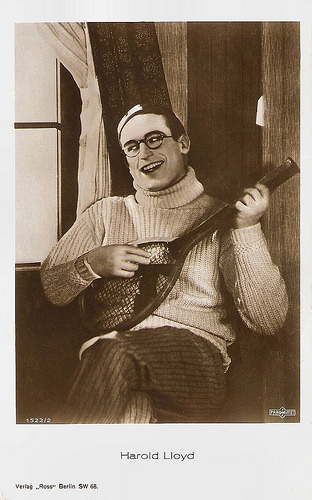
German postcard by Ross Verlag, Foreign, no. 1522/2, 1927-1928. Photo: Paramount / Parufamet. Publicity still for The Freshman (Fred C. Newmeyer, Sam Taylor, 1925).
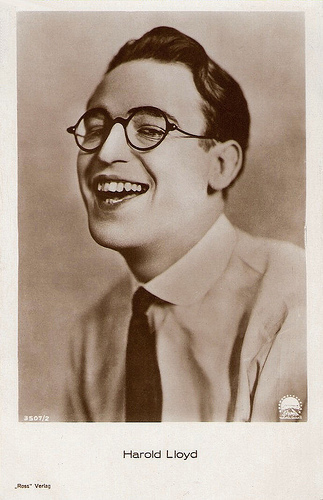
German postcard by Ross Verlag, no. 3507/2, 1928-1929. Photo: Paramount.
The return of the Freshman
In 1937, Harold Lloyd sold the land of his studio, Harold Lloyd Motion Picture Company, to The Church of Jesus Christ of Latter-day Saints. The location is now the site of the Los Angeles California Temple.
Lloyd produced two comedies for RKO, A Girl, a Guy, and a Gob (Richard Wallace, 1941) with Lucille Ball, and a Kay Kyser vehicle, My Favorite Spy (Tay Garnett, 1942) which must have looked good on paper but went nowhere at the box office.
He retired from the screen until an additional starring appearance in The Sin of Harold Diddlebock (Preston Sturges, 1947), an ill-fated homage to Lloyd's career, financed by Howard Hughes. This film had the inspired idea of following Harold's Jazz Age, optimistic character from The Freshman into the Great Depression years. Diddlebock opened with footage from The Freshman (for which Lloyd was paid a royalty of $50,000, matching his actor's fee) and Lloyd was sufficiently youthful-looking to match the older scenes quite well.
Lloyd and Sturges had different conceptions of the material and fought frequently during the shoot. The finished film was released briefly in 1947, then shelved by producer Hughes. Hughes issued a recut version of the film in 1951 through RKO under the title Mad Wednesday. Lloyd sued Howard Hughes, the California Corporation and RKO for damages to his reputation "as an outstanding motion picture star and personality", eventually accepting a $30,000 settlement.
In October 1944, Lloyd emerged as the director and host of The Old Gold Comedy Theater, an NBC radio anthology series, after Preston Sturges, who had turned the job down, recommended him for it. The show presented half-hour radio adaptations of recently successful film comedies, beginning with Palm Beach Story with Claudette Colbert and Robert Young and ending in June 1945 with an adaptation of Tom, Dick and Harry, featuring June Allyson. The show was not renewed for the following season.
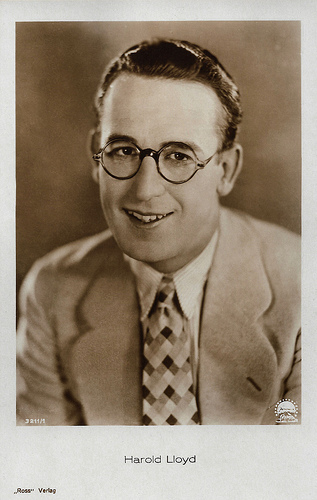
German postcard by Ross Verlag, no. 3211/1, 1928-1929. Photo: Paramount.
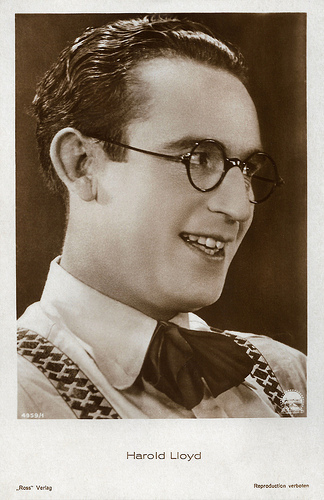
German postcard by Ross Verlag, no. 4959/1, 1929-1930. Photo: Paramount.
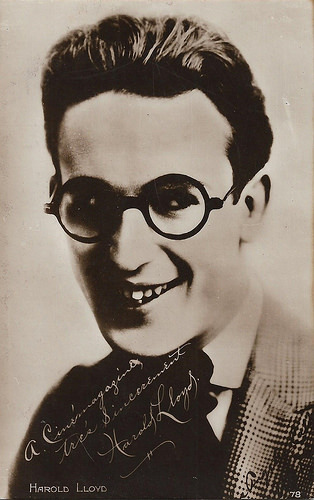
French postcard by Editions Cinémagazine, no. 78.
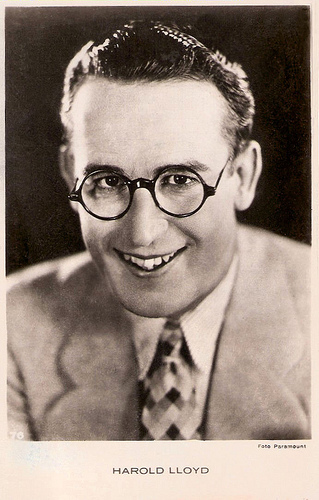
Dutch postcard, no. 76. Photo: Paramount.
Harold Lloyd's Hollywood Nudes in 3D!
Harold Lloyd remained involved in a number of other interests, including civic and charity work. He appeared as himself on several television shows during his retirement, such as Ed Sullivan's variety show Toast of the Town (1949 and 1958). He appeared as the Mystery Guest on What's My Line? (1953), and twice on This Is Your Life: in 1954 for Mack Sennett, and again in 1955, on his own episode.
In 1953, Lloyd received an Academy Honorary Award for being a "master comedian and good citizen". He studied colours and microscopy, and was very involved with photography, including 3D photography and colour film experiments. He became known for his nude photographs of models, such as Bettie Page and stripper Dixie Evans, for a number of men's magazines. He also took photos of Marilyn Monroe lounging at his pool in a bathing suit, which were published after her death. In 2004, his granddaughter Suzanne produced a book of selections from his photographs, 'Harold Lloyd's Hollywood Nudes in 3D!'
Lloyd also provided encouragement and support for a number of younger actors, such as Debbie Reynolds, Robert Wagner, and particularly Jack Lemmon, whom Harold declared as his own choice to play him in a movie of his life and work.
In the early 1960s, Lloyd produced two compilation films, featuring scenes from his old comedies, Harold Lloyd's World of Comedy (Harold Lloyd, 1962) and The Funny Side of Life (Harry Kerwin, 1963). The first film was premiered at the 1962 Cannes Film Festival, where Lloyd was fêted as a major rediscovery. The renewed interest in Lloyd helped restore his status among film historians.
Lloyd and Mildred Davis had two children together: Gloria Lloyd (1923–2012) and Harold Clayton Lloyd Jr. (1931–1971). They also adopted Gloria Freeman (1924–1986) in 1930, whom they renamed Marjorie Elizabeth Lloyd but was known as Peggy for most of her life. Lloyd discouraged Davis from continuing her acting career. He later relented but by that time her career momentum was lost.
Davis died from a heart attack in 1969, two years before Lloyd died at age 77 from prostate cancer, at his Greenacres home in Beverly Hills, California. He was interred in a crypt in the Great Mausoleum at Forest Lawn Memorial Park Cemetery in Glendale, California. In 1990, Kevin Brownlow and David Gill produced the documentary, Harold Lloyd: The Third Genius. Composer Carl Davis wrote a new score for Safety Last! which he performed live during a showing of the film with the Royal Scottish National Orchestra to great acclaim in 1993. The Brownlow and Gill documentary created a renewed interest in Lloyd's work in the United States, but the films were largely unavailable. Criterion Collection has since acquired the home video rights to the Lloyd library, and have released Safety Last!, The Freshman, and Speedy.
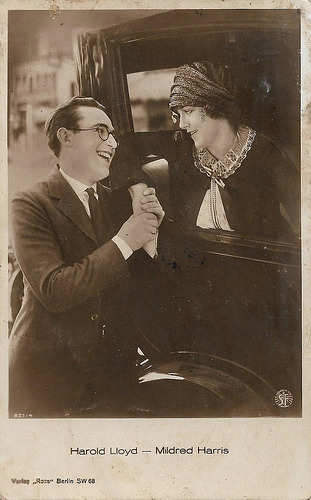
German postcard by Ross Verlag, no. 821/4, 1925-1926. Photo: S.F. (Südfilm A.G.). This postcard, with a picture from Safety Last! (Fred Neymeyer, Sam Taylor, 1923), erroneously mentions the actress as Mildred Harris, while she really is Mildred Davis.
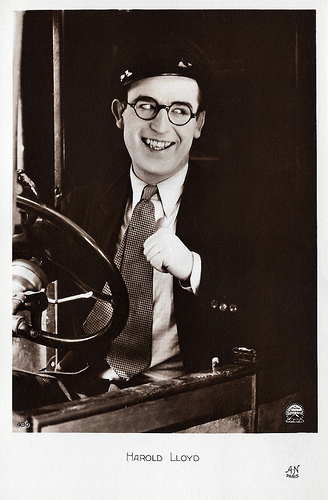
French postcard by A.N., Paris, no. 430. Photo: Paramount. Publicity still for Speedy (Ted Wilde, 1928).
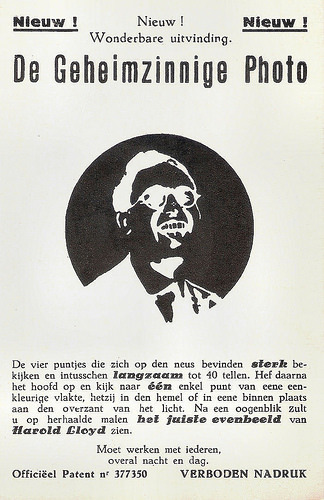
Belgian postcard by Buteco, Brussels.
Translation of the postcard text: New! New! New! A wonderful invention. The Mysterious Photo. Look STRONGLY at the four points on the nose and count SLOWLY till 40. Move your head up and look at ONE point of a one-coloured surface. After a moment, you will see THE RIGHT IMAGE of HAROLD LLOYD several times. Must work for everyone, everywhere, night and day. Official patent no. 377350. Forbidden to copy."
Sources: Wikipedia and .

German postcard by Ross Verlag, no. 1422/2, 1927-1928. Photo: Fanamet.

German postcard by Ross Verlag, no. 4339/1, 1929-1930. Photo: Paramount. Publicity still for Speedy (Ted Wilde, 1928).

German postcard by Ross Verlag, Foreign, no. 1485/2, 1927-1928. Photo: Paramount / Parufamet.
Lonesome Luke
Harold Clayton Lloyd was born in 1893 in Burchard, Nebraska, the son of James Darsie Lloyd and Sarah Elisabeth Fraser. In 1910, after his father had several business ventures fail, Lloyd's parents divorced and his father moved with his son to San Diego, California.
Lloyd had acted in theatre since he was a child, and in San Diego he received his stage training at the School of Dramatic Art and began acting in one-reel film comedies around 1912. Lloyd worked with Thomas Edison's motion picture company, and his first role was a bit part as a Yaqui Indian in The Old Monk's Tale (J. Searle Dawley, 1913).
At the age of 20, Lloyd moved to Los Angeles, and took up roles in several Keystone comedies. He was also hired by Universal Studios as an extra. Lloyd began collaborating with his friend Hal Roach who had formed his own studio in 1913. They created Will E. Work and then Lonesome Luke, variations of Charles Chaplin 's Little Tramp character.
In 1914, Lloyd hired Bebe Daniels as a supporting actress. The two were involved romantically and were known as 'The Boy and The Girl'. In 1919, she left him after it became apparent he was unable to make a commitment, and she pursued her dramatic aspirations. Later that year, Lloyd replaced Daniels with Mildred Davis, whom he would marry in 1923.
By 1918, Lloyd and Roach had begun to develop a new character beyond an imitation of his contemporaries. Harold Lloyd would move away from tragicomic personas, and portray an everyman with unwavering confidence and optimism. The persona Lloyd referred to as his 'Glass' character was a much more mature comedy character with greater potential for sympathy and emotional depth, and was easy for audiences of the time to identify with. To create his new character Lloyd donned a pair of lensless horn-rimmed eyeglasses but wore normal clothing. Previously, he had worn a fake moustache and ill-fitting clothes as the Chaplinesque Lonesome Luke.
In August 1919, while posing for some promotional still photographs in the Los Angeles Witzel Photography Studio, he was seriously injured holding a prop bomb thought merely to be a smoke pot. It exploded and mangled his right hand, causing him to lose a thumb and forefinger. The blast was severe enough that the cameraman and prop director nearby were also seriously injured. Lloyd was in the act of lighting a cigarette from the fuse of the bomb when it exploded, also badly burning his face and chest and injuring his eye. Despite the proximity of the blast to his face, he retained his sight.

Italian postcard by Ed. A. Traldi, Milano, no. 78.

Italian postcard by Casa Editrice Ballerini & Fratini, Firenze (B.F.F.), no. 446. Photo: Paramount. Publicity still for Why Worry (Fred C. Newmeyer, Sam Taylor, 1923) with Jobyna Ralston.

German postcard by Ross Verlag, no. 719/1, 1925-1926. Photo: Pigeard-Loeser-Film, Berlin.

German postcard by Ross Verlag, no. 821/2, 1925-1926. Photo: S.F. (Südfilm A.G.). This postcard, with a picture from Safety Last (Fred Newmeyer, Sam Taylor, 1923), erroneously mentions the actress as Mildred Harris, while she really is Mildred Davis, Lloyd's wife. Many sources today still confound the two actresses.
The Freshman
Beginning in 1921, Harold Lloyd and Hal Roach moved from shorts to feature-length comedies. These included the acclaimed Grandma's Boy, which pioneered the combination of complex character development and film comedy, the highly popular Safety Last! (Fred C. Newmeyer, Sam Taylor, 1923), which cemented Lloyd's stardom, and Why Worry? (Fred C. Newmeyer, Sam Taylor, 1923).
Lloyd and Roach parted ways in 1924, and Lloyd became the independent producer of his own films. These included his most accomplished mature features Girl Shy (Fred C. Newmeyer, Sam Taylor, 1924), The Freshman (Fred C. Newmeyer, Sam Taylor, 1925) - his highest-grossing silent feature, The Kid Brother (Ted Wilde, J.A. Howe, 1927), and Speedy (Ted Wilde, 1928), his final silent film.
Welcome Danger (Clyde Bruckman, 1929) was originally a silent film but Lloyd decided late in the production to remake it with dialogue. All of these films were enormously successful and profitable, and Lloyd would eventually become the highest paid film performer of the 1920s. Although Lloyd's individual films were not as commercially successful as Charles Chaplin 's on average, he was far more prolific (releasing 12 feature films in the 1920s while Chaplin released just four), and made more money overall ($15.7 million to Chaplin's $10.5 million).
The huge financial success of Welcome Danger had proved that audiences were eager to hear Lloyd's voice on film. Lloyd's rate of film releases, which had been one or two a year in the 1920s, slowed to about one every two years until 1938. The films released during this period were: Feet First (Clyde Bruckman, 1930), with a similar scenario to Safety Last which found him clinging to a skyscraper at the climax; Movie Crazy (Clyde Bruckman, 1932) with Constance Cummings; The Cat's-Paw (Sam Taylor, 1934), which was a dark political comedy and a big departure for Lloyd; and The Milky Way (Leo McCarey, 1936), which was Lloyd's only attempt at the fashionable genre of the screwball comedy film.
However, his go-getting screen character was out of touch with Great Depression movie audiences of the 1930s. As the length of time between his film releases increased, his popularity declined, as did the fortunes of his production company. His final film of the decade, Professor Beware (Elliott Nugent, 1938), was made by the Paramount staff, with Lloyd functioning only as actor and partial financier.

British Real Photograph postcard.

German postcard by Ross Verlag, no. 1422/3, 1927-1928. Photo: Fanamet.

German postcard by Ross Verlag, Foreign, no. 1522/2, 1927-1928. Photo: Paramount / Parufamet. Publicity still for The Freshman (Fred C. Newmeyer, Sam Taylor, 1925).

German postcard by Ross Verlag, no. 3507/2, 1928-1929. Photo: Paramount.
The return of the Freshman
In 1937, Harold Lloyd sold the land of his studio, Harold Lloyd Motion Picture Company, to The Church of Jesus Christ of Latter-day Saints. The location is now the site of the Los Angeles California Temple.
Lloyd produced two comedies for RKO, A Girl, a Guy, and a Gob (Richard Wallace, 1941) with Lucille Ball, and a Kay Kyser vehicle, My Favorite Spy (Tay Garnett, 1942) which must have looked good on paper but went nowhere at the box office.
He retired from the screen until an additional starring appearance in The Sin of Harold Diddlebock (Preston Sturges, 1947), an ill-fated homage to Lloyd's career, financed by Howard Hughes. This film had the inspired idea of following Harold's Jazz Age, optimistic character from The Freshman into the Great Depression years. Diddlebock opened with footage from The Freshman (for which Lloyd was paid a royalty of $50,000, matching his actor's fee) and Lloyd was sufficiently youthful-looking to match the older scenes quite well.
Lloyd and Sturges had different conceptions of the material and fought frequently during the shoot. The finished film was released briefly in 1947, then shelved by producer Hughes. Hughes issued a recut version of the film in 1951 through RKO under the title Mad Wednesday. Lloyd sued Howard Hughes, the California Corporation and RKO for damages to his reputation "as an outstanding motion picture star and personality", eventually accepting a $30,000 settlement.
In October 1944, Lloyd emerged as the director and host of The Old Gold Comedy Theater, an NBC radio anthology series, after Preston Sturges, who had turned the job down, recommended him for it. The show presented half-hour radio adaptations of recently successful film comedies, beginning with Palm Beach Story with Claudette Colbert and Robert Young and ending in June 1945 with an adaptation of Tom, Dick and Harry, featuring June Allyson. The show was not renewed for the following season.

German postcard by Ross Verlag, no. 3211/1, 1928-1929. Photo: Paramount.

German postcard by Ross Verlag, no. 4959/1, 1929-1930. Photo: Paramount.

French postcard by Editions Cinémagazine, no. 78.

Dutch postcard, no. 76. Photo: Paramount.
Harold Lloyd's Hollywood Nudes in 3D!
Harold Lloyd remained involved in a number of other interests, including civic and charity work. He appeared as himself on several television shows during his retirement, such as Ed Sullivan's variety show Toast of the Town (1949 and 1958). He appeared as the Mystery Guest on What's My Line? (1953), and twice on This Is Your Life: in 1954 for Mack Sennett, and again in 1955, on his own episode.
In 1953, Lloyd received an Academy Honorary Award for being a "master comedian and good citizen". He studied colours and microscopy, and was very involved with photography, including 3D photography and colour film experiments. He became known for his nude photographs of models, such as Bettie Page and stripper Dixie Evans, for a number of men's magazines. He also took photos of Marilyn Monroe lounging at his pool in a bathing suit, which were published after her death. In 2004, his granddaughter Suzanne produced a book of selections from his photographs, 'Harold Lloyd's Hollywood Nudes in 3D!'
Lloyd also provided encouragement and support for a number of younger actors, such as Debbie Reynolds, Robert Wagner, and particularly Jack Lemmon, whom Harold declared as his own choice to play him in a movie of his life and work.
In the early 1960s, Lloyd produced two compilation films, featuring scenes from his old comedies, Harold Lloyd's World of Comedy (Harold Lloyd, 1962) and The Funny Side of Life (Harry Kerwin, 1963). The first film was premiered at the 1962 Cannes Film Festival, where Lloyd was fêted as a major rediscovery. The renewed interest in Lloyd helped restore his status among film historians.
Lloyd and Mildred Davis had two children together: Gloria Lloyd (1923–2012) and Harold Clayton Lloyd Jr. (1931–1971). They also adopted Gloria Freeman (1924–1986) in 1930, whom they renamed Marjorie Elizabeth Lloyd but was known as Peggy for most of her life. Lloyd discouraged Davis from continuing her acting career. He later relented but by that time her career momentum was lost.
Davis died from a heart attack in 1969, two years before Lloyd died at age 77 from prostate cancer, at his Greenacres home in Beverly Hills, California. He was interred in a crypt in the Great Mausoleum at Forest Lawn Memorial Park Cemetery in Glendale, California. In 1990, Kevin Brownlow and David Gill produced the documentary, Harold Lloyd: The Third Genius. Composer Carl Davis wrote a new score for Safety Last! which he performed live during a showing of the film with the Royal Scottish National Orchestra to great acclaim in 1993. The Brownlow and Gill documentary created a renewed interest in Lloyd's work in the United States, but the films were largely unavailable. Criterion Collection has since acquired the home video rights to the Lloyd library, and have released Safety Last!, The Freshman, and Speedy.

German postcard by Ross Verlag, no. 821/4, 1925-1926. Photo: S.F. (Südfilm A.G.). This postcard, with a picture from Safety Last! (Fred Neymeyer, Sam Taylor, 1923), erroneously mentions the actress as Mildred Harris, while she really is Mildred Davis.

French postcard by A.N., Paris, no. 430. Photo: Paramount. Publicity still for Speedy (Ted Wilde, 1928).

Belgian postcard by Buteco, Brussels.
Translation of the postcard text: New! New! New! A wonderful invention. The Mysterious Photo. Look STRONGLY at the four points on the nose and count SLOWLY till 40. Move your head up and look at ONE point of a one-coloured surface. After a moment, you will see THE RIGHT IMAGE of HAROLD LLOYD several times. Must work for everyone, everywhere, night and day. Official patent no. 377350. Forbidden to copy."
Sources: Wikipedia and .
Published on March 20, 2019 23:00
March 19, 2019
Line Renaud
Line Renaud (1928), is a French singer, stage and screen actress, and AIDS activist. In 1946 Renaud started acting in film and still does so. Her singing skills were often at the heart of her roles. Renaud’s best known film is Dany Boon's comedy Bienvenue chez les Ch'tis (2008). This comedy lead to several new roles.
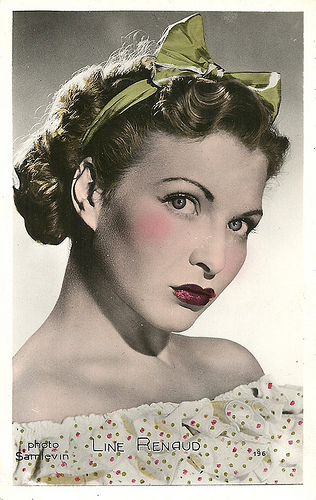
French postcard by Editions P.I., Paris, no. 196. Photo: Sam Lévin.

French promotion card by Publicis / Pathé Marconi. Photo: Sam Lévin.
The Commander
Line Renaud was born Jacqueline Enté in Pont-de-Nieppe in the north of France in 1928. Her father was a truck driver, her mother a steno typist. Because of her father's activity as a trumpeter in the local brass band, she got into contact with music. At age seven, she won an amateur contest. During the Second World War, her father was mobilised and prisoner of war for five years, so she was raised by her her mother, grandmother and great-grandmother.
Her girlfriends called her "the commander" because she knew what she wanted and you always had to listen to her. Having failed at the age of 14 in the Primary School Certificate, she was spotted at the entrance examination at the Lille Conservatory: the very evening of her audition, the director of Radio-Lille suggested that she joined his orchestra.
The 16-years-old made herself known under the name of Jacqueline Ray, singing the songs of well-known composer Louis 'Loulou' Gasté. She moved to Paris in 1945 and landed her first engagement at the Folies-Belleville.
Through Josette Daydé, she met her songwriter 'Loulou' Gasté, twenty years older than her. He became her mentor and made her take a new stage name. She chose Renaud, borrowing from her grandmother Marguerite Renard her surname, and changing one letter. In 1947, she recorded 'Ma cabane au Canada', which received the Grand Prix du Disque in 1949. In 1950, she married Loulou Gasté, who remained her husband until his death in 1995.
Line Renaud continued her success with titles such as 'Étoile des neiges' (1950), 'Ma p'tite folie' (1952), 'Mademoiselle d'Armentières' (1952), and 'Le Chien dans la vitrine' (1952) whose barking was done by the famous French voice-over Roger Carel, as he explained during his visit to the Tribunal des flagrants délires in 1980.
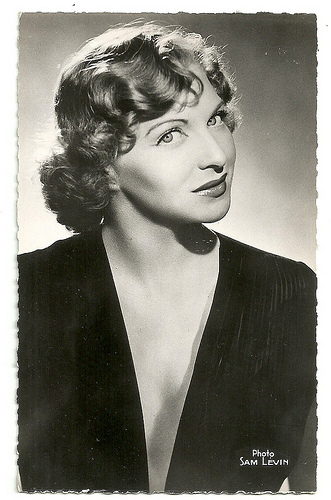
French postcard. Photo: Sam Lévin. Editions du Globe, Paris, No. 146.
Johnny Hallyday's godmother
In 1954 Line Renaud sang at the Moulin Rouge, collecting several prizes that year, causing Edith Piaf 's jealousy. At the Moulin Rouge, she met Bob Hope. She left for the United States, and subsequently appeared in five episodes of The Bob Hope Show in the US. During this trip, she also sang at the theatres of New York and Los Angeles, and at the Ed Sullivan Show. In a duet with Dean Martin, she sang 'Relaxez-vous' as ‘Relax ay voo’. At the end of 1955, she was the first French singer to sing a Rock and Roll song: 'Tweedle Dee' by Lavern Baker.
In 1959, she became a revue leader at the Casino de Paris, then she was engaged in Dunes, a casino in Las Vegas between 1963 and 1965. She also sang in London. Frequenting Nate Jacobson, the founder of Caesar’s Palace at Las Vegas, and her lover for 18 years, she was also involved in the creation of this hotel-casino in terms of decoration and the auditorium.
In April 1960, she became Johnny Hallyday 's godmother for his first television appearance on Aimée Mortimer's show L'école des vedettes. In the 1970s, she presented on television the 'Line Directe' show. In the same decade, she was the producer of Tony Bennett's shows for the Kings Castle in Las Vegas.
In the 1980s, she produced the television show Telle est Line on Antenne 2, and began a theatre career. In the same decade, she sang 'Le Soir' with Dalida , of whom she was a very close friend.
In the 1990s, while the casino hotel Paris Las Vegas was planned, she contacted the mayor of Paris Jean Tibéri, in order to authorise the construction of a replica of the Eiffel Tower on the building. She became artistic director of the establishment and invited Catherine Deneuve and Charles Aznavour for the inauguration in 1999, while singing on stage with Michel Legrand.
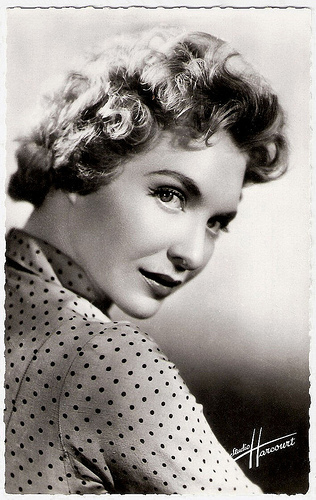
French postcard by Editions du Globe, no. 350. Photo: Studio Harcourt.
A Street in Las Vegas
In 1985, Line Renaud created l'Association des Artistes Contre le Sida and organised televised art events which enabled her to raise funds for helping AIDS scientific research in France. She is the vice-president of the association Sidaction. In 2009, she condemned the statements of Pope Benedict XVI, who claimed condoms promoted behaviour which causes AIDS.
Renaud was president of the jury of the Miss France 2009 election. Ten years later, December 2018, she renewed the experience by presiding the jury of Miss France 2019.
After thirty years of absence, she returned to singing and recorded a new album, entitled 'Rue Washington' (2010), in reference to the recording studio Labomatic located in this street. Directed by Dominique Blanc-Francard, the album includes two duets, the first with Johnny Hallyday , 'Un monde merveilleux', a cover of 'What a Wonderful World', the second with Mylène Farmer , 'C'est pas l'heure', with words by Farmer and music by Laurent Boutonnat. Famous names such as Julien Clerc, Michel Delpech, and Salvatore Adamo, collaborated on this project.
The song 'Torrents d'amour' from the album ranked 24th in the bestseller list at its release in November 2010. On 24 and 25 May 2011, Line Renaud performed for the first time in her career, at the Olympia in Paris.
In October 2017, she opened a street bearing her name in Las Vegas. The path, located near the mythical Strip, the gigantic artery that runs through the city, provides access to a secondary entrance to the casino Caesars Palace. The Line Renaud Road is not far from the streets bearing the names of his friends Frank Sinatra and Dean Martin.
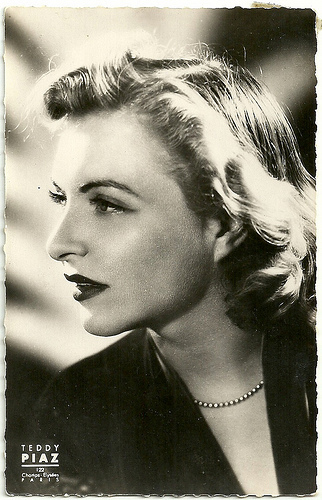
French postcard by Editions du Globe, no. 218. Photo: Teddy Piaz, Paris.
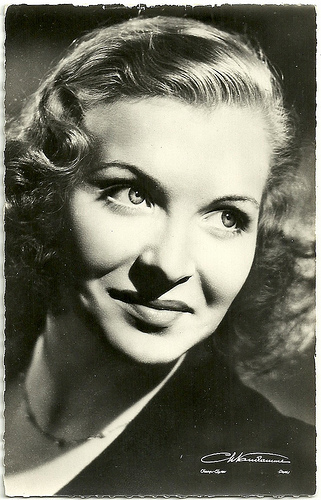
French postcard by Editions du Globe, Paris, no. 362. Photo: Ch. Vandamme, Paris.
The daughter of the local bar owner
In 1946, Line Renaud started acting in films and she still does so. Her singing skills were often at the heart of her roles. Her first part was that of the singer singing 'Tant que tu m'aimeras' in La Foire aux chimères/Devil and the Angel (Pierre Chenal, 1946), starring Madeleine Sologne and Erich von Stroheim .
She had a small part in Une belle garce/A beautiful bitch (Jacques Daroy, 1948) featuring Ginette Leclerc , and played herself in the documentary Au fil des ondes/Over the waves (Pierre Gautherin, 1951).
Renaud became the star of Ils sont dans les vignes/They are in the vineyards... (Robert Vernay, 1952), a musical comedy about a salesman of a non-alcoholic drink, who tries to set up market right in the Burgundy wine area. Renaud is the daughter of the local bar owner and the love interest of the salesman.
In addition to playing herself in more films of the 1950s, she again played the daughter of the local bar owner in La Madelon (Jean Boyer, 1955), in which she has to fight the too brash soldiers during the First World War, but she is a tough girl, so she manages. They go wild for her song 'Madelon', which becomes a kind of hymn to them.
In the police comedy Mademoiselle et son gang/Mademoiselle and her gang (Jean Boyer, 1957), Renaud played the daughter of a police inspector, who under pseudonym writes crime novels, but then gets into trouble with real gangsters. In 1959, she played in another comedy, L’Increvable/The Indestructible (Jean Boyer, 1959) with Darry Cowl as a barman in love with his boss’s wife (Renaud), deciding to draw up a life insurance in favour of his beloved, an act which becomes known.
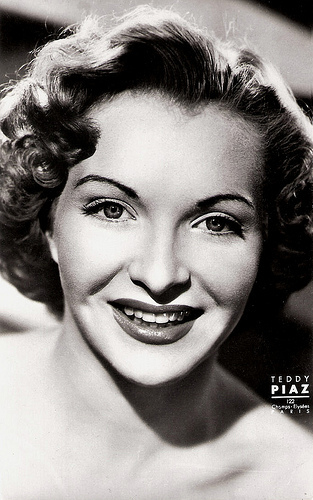
French postcard by Editions O.P., Paris, no. 52. Photo: Teddy Piaz.
Mothers and grandmothers
After a gap of almost two decades, Renaud returned to the film set with La Folle journée ou le mariage de Figaro (Roger Coggio, 1988). She now played roles of mothers and grandmothers. She alternated comedies such as Ripoux contre ripoux/My New Partner II (Claudi Zidi, 1990) with Philippe Noiret , and Ma femme me quitte/My Woman Is Leaving Me (Didier Kaminka, 1995) with drama such as J’ai sommeil/I Can't Sleep (1994) by Claire Denis, based on the true story of a killer of old ladies who was active in the North of France from the late 1980s. Renaud played a supporting part as hotel owner who teaches self-defense to old ladies.
For her supporting part in the comedy Belle-maman/Step mother (Gabriel Aghion, 1999), starring Vincent Lindon and Catherine Deneuve , Renaud received a César Nomination in 2000. In Coline Serreau’s comedy-drama Chaos (2001), she is the mother-in-law of the protagonist Helen (Catherine Frot), earning her a second César nomination.
After Serreau’s film 18 ans après/18 Years Later (Coline Serreau, 2003), the sequel to Trois hommes et un couffin/Three Men and a Cradle (Coline Serreau, 1985), Renaud appeared in the Claude Lelouch comedy Le Courage d'aimer/The Courage to Love (2005), followed by the comedy La Maison du bonheur/The House of Happiness(Dany Boon, 2006), based on the same play as the classic Mr. Blandings builds his Dream House (H.C. Potter, 1948).
Renaud’s nationally and internationally best known film is Dany Boon’s Bienvenue chez les Ch'tis/Welcome to the Sticks (2008). This comedy, directed and co-scripted by Boon, with Kad Merad and himself in the lead, focuses on a cheating post office director (Merad) forced to move to a little city in the North of France. This region is badly considered in the rest of France, for its heavy dialect, its limited cuisine, its bad weather, and alcoholism. The post man discovers it is not that bad in the end.
The film broke records in France, started tourism towards the North, and inspired an Italian remake. Renaud played the mother of the local hero, Antoine (Boon). Boon himself exploited his success and the North discovery with his comedy La Ch'tite Famille/The Stick Family (2018), with Renaud again playing his mother. It was her third part in a film by Dany Boon.
Line Renaud also appeared in the cruise ship comedy La Croisière/The Cruise (Pascale Pouzadoux, 2011) as an old lady who smuggles her dog aboard, and she regularly acts in TV series and films. A new tragicomedy with Renaud, Let's Dance (Ladislas Chollat, 2019) is set to appear this year.
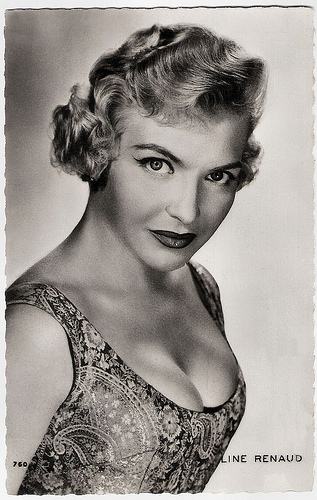
French postcard by Editions P.I., Paris, no. 52. Photo: Sam Lévin.
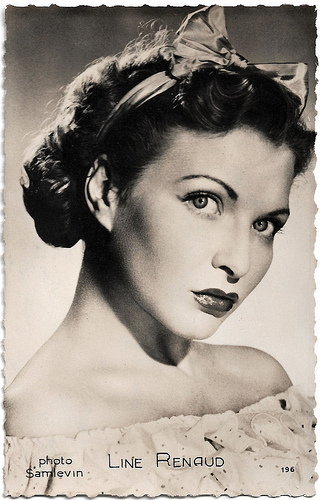
French postcard by Editions P.I., Paris, no. 196. Photo: Sam Lévin.
Sources: Wikipedia (French, English and German) and .

French postcard by Editions P.I., Paris, no. 196. Photo: Sam Lévin.

French promotion card by Publicis / Pathé Marconi. Photo: Sam Lévin.
The Commander
Line Renaud was born Jacqueline Enté in Pont-de-Nieppe in the north of France in 1928. Her father was a truck driver, her mother a steno typist. Because of her father's activity as a trumpeter in the local brass band, she got into contact with music. At age seven, she won an amateur contest. During the Second World War, her father was mobilised and prisoner of war for five years, so she was raised by her her mother, grandmother and great-grandmother.
Her girlfriends called her "the commander" because she knew what she wanted and you always had to listen to her. Having failed at the age of 14 in the Primary School Certificate, she was spotted at the entrance examination at the Lille Conservatory: the very evening of her audition, the director of Radio-Lille suggested that she joined his orchestra.
The 16-years-old made herself known under the name of Jacqueline Ray, singing the songs of well-known composer Louis 'Loulou' Gasté. She moved to Paris in 1945 and landed her first engagement at the Folies-Belleville.
Through Josette Daydé, she met her songwriter 'Loulou' Gasté, twenty years older than her. He became her mentor and made her take a new stage name. She chose Renaud, borrowing from her grandmother Marguerite Renard her surname, and changing one letter. In 1947, she recorded 'Ma cabane au Canada', which received the Grand Prix du Disque in 1949. In 1950, she married Loulou Gasté, who remained her husband until his death in 1995.
Line Renaud continued her success with titles such as 'Étoile des neiges' (1950), 'Ma p'tite folie' (1952), 'Mademoiselle d'Armentières' (1952), and 'Le Chien dans la vitrine' (1952) whose barking was done by the famous French voice-over Roger Carel, as he explained during his visit to the Tribunal des flagrants délires in 1980.

French postcard. Photo: Sam Lévin. Editions du Globe, Paris, No. 146.
Johnny Hallyday's godmother
In 1954 Line Renaud sang at the Moulin Rouge, collecting several prizes that year, causing Edith Piaf 's jealousy. At the Moulin Rouge, she met Bob Hope. She left for the United States, and subsequently appeared in five episodes of The Bob Hope Show in the US. During this trip, she also sang at the theatres of New York and Los Angeles, and at the Ed Sullivan Show. In a duet with Dean Martin, she sang 'Relaxez-vous' as ‘Relax ay voo’. At the end of 1955, she was the first French singer to sing a Rock and Roll song: 'Tweedle Dee' by Lavern Baker.
In 1959, she became a revue leader at the Casino de Paris, then she was engaged in Dunes, a casino in Las Vegas between 1963 and 1965. She also sang in London. Frequenting Nate Jacobson, the founder of Caesar’s Palace at Las Vegas, and her lover for 18 years, she was also involved in the creation of this hotel-casino in terms of decoration and the auditorium.
In April 1960, she became Johnny Hallyday 's godmother for his first television appearance on Aimée Mortimer's show L'école des vedettes. In the 1970s, she presented on television the 'Line Directe' show. In the same decade, she was the producer of Tony Bennett's shows for the Kings Castle in Las Vegas.
In the 1980s, she produced the television show Telle est Line on Antenne 2, and began a theatre career. In the same decade, she sang 'Le Soir' with Dalida , of whom she was a very close friend.
In the 1990s, while the casino hotel Paris Las Vegas was planned, she contacted the mayor of Paris Jean Tibéri, in order to authorise the construction of a replica of the Eiffel Tower on the building. She became artistic director of the establishment and invited Catherine Deneuve and Charles Aznavour for the inauguration in 1999, while singing on stage with Michel Legrand.

French postcard by Editions du Globe, no. 350. Photo: Studio Harcourt.
A Street in Las Vegas
In 1985, Line Renaud created l'Association des Artistes Contre le Sida and organised televised art events which enabled her to raise funds for helping AIDS scientific research in France. She is the vice-president of the association Sidaction. In 2009, she condemned the statements of Pope Benedict XVI, who claimed condoms promoted behaviour which causes AIDS.
Renaud was president of the jury of the Miss France 2009 election. Ten years later, December 2018, she renewed the experience by presiding the jury of Miss France 2019.
After thirty years of absence, she returned to singing and recorded a new album, entitled 'Rue Washington' (2010), in reference to the recording studio Labomatic located in this street. Directed by Dominique Blanc-Francard, the album includes two duets, the first with Johnny Hallyday , 'Un monde merveilleux', a cover of 'What a Wonderful World', the second with Mylène Farmer , 'C'est pas l'heure', with words by Farmer and music by Laurent Boutonnat. Famous names such as Julien Clerc, Michel Delpech, and Salvatore Adamo, collaborated on this project.
The song 'Torrents d'amour' from the album ranked 24th in the bestseller list at its release in November 2010. On 24 and 25 May 2011, Line Renaud performed for the first time in her career, at the Olympia in Paris.
In October 2017, she opened a street bearing her name in Las Vegas. The path, located near the mythical Strip, the gigantic artery that runs through the city, provides access to a secondary entrance to the casino Caesars Palace. The Line Renaud Road is not far from the streets bearing the names of his friends Frank Sinatra and Dean Martin.

French postcard by Editions du Globe, no. 218. Photo: Teddy Piaz, Paris.

French postcard by Editions du Globe, Paris, no. 362. Photo: Ch. Vandamme, Paris.
The daughter of the local bar owner
In 1946, Line Renaud started acting in films and she still does so. Her singing skills were often at the heart of her roles. Her first part was that of the singer singing 'Tant que tu m'aimeras' in La Foire aux chimères/Devil and the Angel (Pierre Chenal, 1946), starring Madeleine Sologne and Erich von Stroheim .
She had a small part in Une belle garce/A beautiful bitch (Jacques Daroy, 1948) featuring Ginette Leclerc , and played herself in the documentary Au fil des ondes/Over the waves (Pierre Gautherin, 1951).
Renaud became the star of Ils sont dans les vignes/They are in the vineyards... (Robert Vernay, 1952), a musical comedy about a salesman of a non-alcoholic drink, who tries to set up market right in the Burgundy wine area. Renaud is the daughter of the local bar owner and the love interest of the salesman.
In addition to playing herself in more films of the 1950s, she again played the daughter of the local bar owner in La Madelon (Jean Boyer, 1955), in which she has to fight the too brash soldiers during the First World War, but she is a tough girl, so she manages. They go wild for her song 'Madelon', which becomes a kind of hymn to them.
In the police comedy Mademoiselle et son gang/Mademoiselle and her gang (Jean Boyer, 1957), Renaud played the daughter of a police inspector, who under pseudonym writes crime novels, but then gets into trouble with real gangsters. In 1959, she played in another comedy, L’Increvable/The Indestructible (Jean Boyer, 1959) with Darry Cowl as a barman in love with his boss’s wife (Renaud), deciding to draw up a life insurance in favour of his beloved, an act which becomes known.

French postcard by Editions O.P., Paris, no. 52. Photo: Teddy Piaz.
Mothers and grandmothers
After a gap of almost two decades, Renaud returned to the film set with La Folle journée ou le mariage de Figaro (Roger Coggio, 1988). She now played roles of mothers and grandmothers. She alternated comedies such as Ripoux contre ripoux/My New Partner II (Claudi Zidi, 1990) with Philippe Noiret , and Ma femme me quitte/My Woman Is Leaving Me (Didier Kaminka, 1995) with drama such as J’ai sommeil/I Can't Sleep (1994) by Claire Denis, based on the true story of a killer of old ladies who was active in the North of France from the late 1980s. Renaud played a supporting part as hotel owner who teaches self-defense to old ladies.
For her supporting part in the comedy Belle-maman/Step mother (Gabriel Aghion, 1999), starring Vincent Lindon and Catherine Deneuve , Renaud received a César Nomination in 2000. In Coline Serreau’s comedy-drama Chaos (2001), she is the mother-in-law of the protagonist Helen (Catherine Frot), earning her a second César nomination.
After Serreau’s film 18 ans après/18 Years Later (Coline Serreau, 2003), the sequel to Trois hommes et un couffin/Three Men and a Cradle (Coline Serreau, 1985), Renaud appeared in the Claude Lelouch comedy Le Courage d'aimer/The Courage to Love (2005), followed by the comedy La Maison du bonheur/The House of Happiness(Dany Boon, 2006), based on the same play as the classic Mr. Blandings builds his Dream House (H.C. Potter, 1948).
Renaud’s nationally and internationally best known film is Dany Boon’s Bienvenue chez les Ch'tis/Welcome to the Sticks (2008). This comedy, directed and co-scripted by Boon, with Kad Merad and himself in the lead, focuses on a cheating post office director (Merad) forced to move to a little city in the North of France. This region is badly considered in the rest of France, for its heavy dialect, its limited cuisine, its bad weather, and alcoholism. The post man discovers it is not that bad in the end.
The film broke records in France, started tourism towards the North, and inspired an Italian remake. Renaud played the mother of the local hero, Antoine (Boon). Boon himself exploited his success and the North discovery with his comedy La Ch'tite Famille/The Stick Family (2018), with Renaud again playing his mother. It was her third part in a film by Dany Boon.
Line Renaud also appeared in the cruise ship comedy La Croisière/The Cruise (Pascale Pouzadoux, 2011) as an old lady who smuggles her dog aboard, and she regularly acts in TV series and films. A new tragicomedy with Renaud, Let's Dance (Ladislas Chollat, 2019) is set to appear this year.

French postcard by Editions P.I., Paris, no. 52. Photo: Sam Lévin.

French postcard by Editions P.I., Paris, no. 196. Photo: Sam Lévin.
Sources: Wikipedia (French, English and German) and .
Published on March 19, 2019 23:00
March 18, 2019
Pratertraum (1924)
Pratertraum/Prater. Die Erlebnisse zweier Nähmädchen (Peter Paul Felner, 1924) is one of the typical melodramas in which Henny Porten starred during the 1920s. It is partly situated in the Prater, an amusement park in Vienna which includes the Wiener Riesenrad, a Ferris wheel known from The Third Man (Carol Reed, 1949).
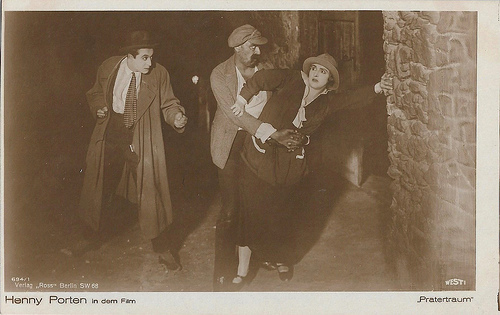
German postcard by Ross Verlag, no. 694/2. Photo: Atlantic Film / Westi Film. Henny Porten in Pratertraum/Prater. Die Erlebnisse zweier Nähmädchen (Peter Paul Felner, 1924).
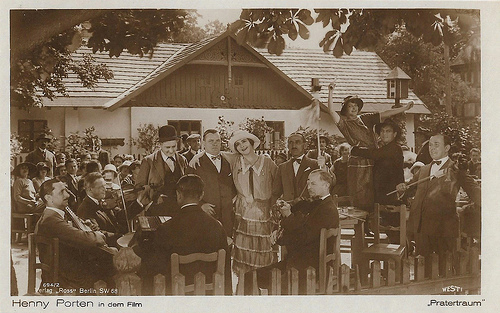
German postcard by Ross Verlag, no. 694/2. Photo: Atlantic Film / Westi Film. Henny Porten in Pratertraum/Prater. Die Erlebnisse zweier Nähmädchen (Peter Paul Felner, 1924).
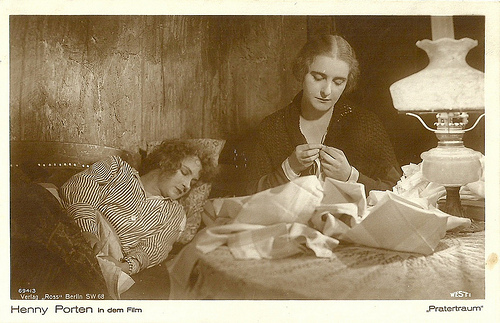
German postcard by Ross Verlag, no. 694/3. Photo: Atlantic Film / Westi Film. Henny Porten and Claire Lotto in Pratertraum/Prater. Die Erlebnisse zweier Nähmädchen (Peter Paul Felner, 1924).
Dark Clouds above the marriage of Countess Annemarie
Pratertraum/Prater. Die Erlebnisse zweier Nähmädchen (Peter Paul Felner, 1924) is about the sisters Annemarie ( Henny Porten ) and Franzi (Claire Lotto), who both earn their living as seamstresses in Vienna. Their brother Martin ( Carl de Vogt ) works as a sailor.
One day, Annemarie meets Count Rynon ( Ossip Runitsch ) in the Prater, who actually marries her despite all the differences in class. Franzi finds her luck with the locomotive driver Fritz ( Johannes Riemann ) and becomes his wife.
Soon, however, dark clouds draw on the marriage sky of Countess Annemarie. Marquis de Monroir ( Angelo Ferrari ), a friend of the Count, tries hard to tie her up with him but is regularly rejected by her. When Franzi visits Annemarie at home, the nobleman tries his luck with her. He hands her a precious piece of jewelry, whereupon Martin reacts very angrily.
The marriages of the two sisters now threaten to break up. In order to make the annoying applicant change his opinion about the married sisters, their brother Martin seeks a conversation with the intrusive. The next day, however, the Marquis is found dead.
Annemarie is suspected of the murder, but it turns out, an unfortunate accident has led to the death of the Marquis. Finally, the two couples reconcile again.
The exteriors of Pratertraum were shot at the Prater amusement park in Vienna and and the Wachau valley in Lower Austria. The film's art direction was by Otto Erdmann and Hans Sohnle. The film was released in November 1924.
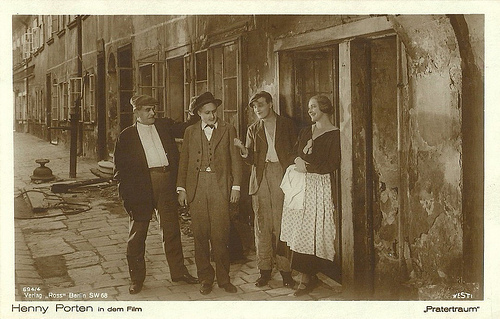
German postcard by Ross Verlag, no. 694/4. Photo: Atlantic Film / Westi Film. Henny Porten in Pratertraum/Prater. Die Erlebnisse zweier Nähmädchen (Peter Paul Felner, 1924).
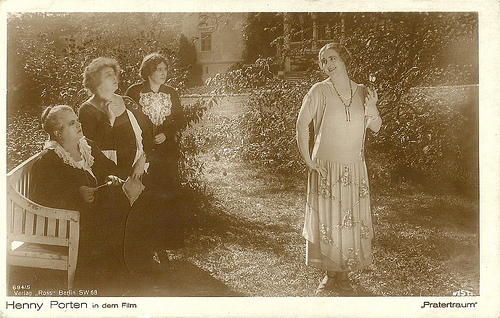
German postcard by Ross Verlag, no. 694/5. Photo: Atlantic Film / Westi Film. Henny Porten in Pratertraum/Prater. Die Erlebnisse zweier Nähmädchen (Peter Paul Felner, 1924).
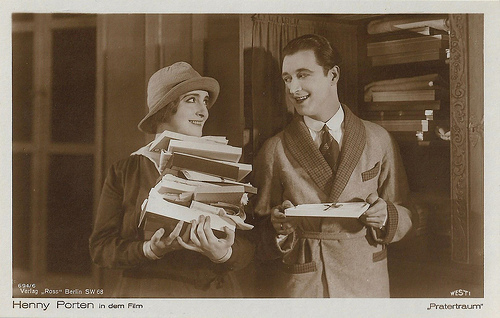
German postcard by Ross Verlag, no. 694/6. Photo: Atlantic Film / Westi Film. Henny Porten and Angelo Ferrari in Pratertraum/Prater. Die Erlebnisse zweier Nähmädchen (Peter Paul Felner, 1924).
Sources: Wikipedia (German) and IMDb.

German postcard by Ross Verlag, no. 694/2. Photo: Atlantic Film / Westi Film. Henny Porten in Pratertraum/Prater. Die Erlebnisse zweier Nähmädchen (Peter Paul Felner, 1924).

German postcard by Ross Verlag, no. 694/2. Photo: Atlantic Film / Westi Film. Henny Porten in Pratertraum/Prater. Die Erlebnisse zweier Nähmädchen (Peter Paul Felner, 1924).

German postcard by Ross Verlag, no. 694/3. Photo: Atlantic Film / Westi Film. Henny Porten and Claire Lotto in Pratertraum/Prater. Die Erlebnisse zweier Nähmädchen (Peter Paul Felner, 1924).
Dark Clouds above the marriage of Countess Annemarie
Pratertraum/Prater. Die Erlebnisse zweier Nähmädchen (Peter Paul Felner, 1924) is about the sisters Annemarie ( Henny Porten ) and Franzi (Claire Lotto), who both earn their living as seamstresses in Vienna. Their brother Martin ( Carl de Vogt ) works as a sailor.
One day, Annemarie meets Count Rynon ( Ossip Runitsch ) in the Prater, who actually marries her despite all the differences in class. Franzi finds her luck with the locomotive driver Fritz ( Johannes Riemann ) and becomes his wife.
Soon, however, dark clouds draw on the marriage sky of Countess Annemarie. Marquis de Monroir ( Angelo Ferrari ), a friend of the Count, tries hard to tie her up with him but is regularly rejected by her. When Franzi visits Annemarie at home, the nobleman tries his luck with her. He hands her a precious piece of jewelry, whereupon Martin reacts very angrily.
The marriages of the two sisters now threaten to break up. In order to make the annoying applicant change his opinion about the married sisters, their brother Martin seeks a conversation with the intrusive. The next day, however, the Marquis is found dead.
Annemarie is suspected of the murder, but it turns out, an unfortunate accident has led to the death of the Marquis. Finally, the two couples reconcile again.
The exteriors of Pratertraum were shot at the Prater amusement park in Vienna and and the Wachau valley in Lower Austria. The film's art direction was by Otto Erdmann and Hans Sohnle. The film was released in November 1924.

German postcard by Ross Verlag, no. 694/4. Photo: Atlantic Film / Westi Film. Henny Porten in Pratertraum/Prater. Die Erlebnisse zweier Nähmädchen (Peter Paul Felner, 1924).

German postcard by Ross Verlag, no. 694/5. Photo: Atlantic Film / Westi Film. Henny Porten in Pratertraum/Prater. Die Erlebnisse zweier Nähmädchen (Peter Paul Felner, 1924).

German postcard by Ross Verlag, no. 694/6. Photo: Atlantic Film / Westi Film. Henny Porten and Angelo Ferrari in Pratertraum/Prater. Die Erlebnisse zweier Nähmädchen (Peter Paul Felner, 1924).
Sources: Wikipedia (German) and IMDb.
Published on March 18, 2019 23:00
March 17, 2019
Colleen Moore
American actress Colleen Moore (1899-1988) was a star of the silent screen who appeared in about 100 films beginning in 1917. During the 1920s, she put her stamp on American social history, creating in dozens of films the image of the wide-eyed, insouciant flapper with her bobbed hair and short skirts.
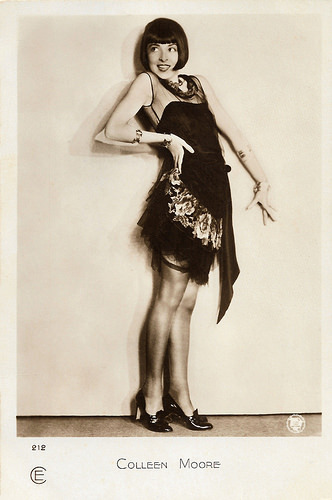
French postcard by Cinémagazine-Edition, Paris, no. 212. Photo: First National Pictures.
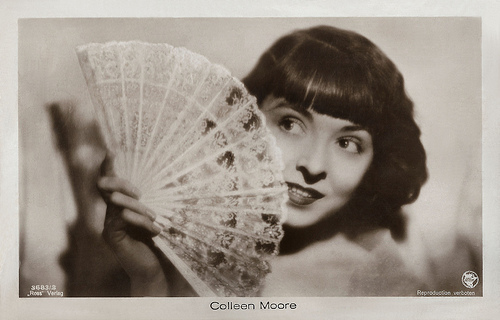
German postcard by Ross Verlag, no. 3683/3, 1928-1929. Photo: First National Pictures.
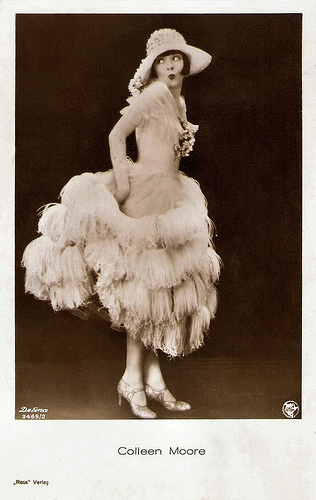
German postcard by Ross Verlag, no. 3469/2, 1928-1929. Photo: Defina / First National Pictures.
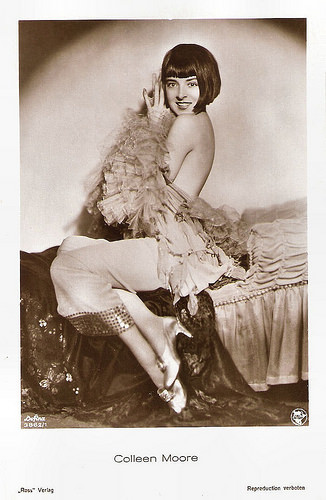
German postcard by Ross Verlag, no. 3862/1, 1928-1929. Photo: Defina / First-National-Film.

German postcard by Ross Verlag, no. 4943/1, 1929-1930. Photo: First National Pictures / Defina. Publicity still for Synthetic Sin (William A. Seiter, 1929) with Antonio Moreno.
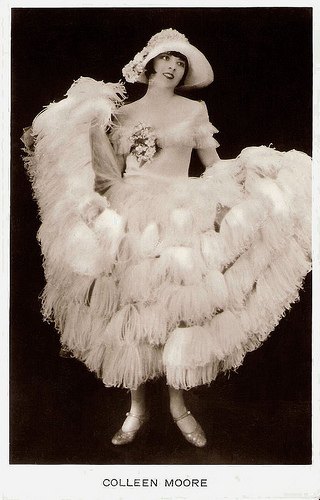
British Real Photograph postcard.
Colleen was on her way
Colleen Moore was born Kathleen Morrison in Port Huron, Michigan in 1899 (the date which she insisted was correct in her autobiography 'Silent Star' was 1902). Her father was an irrigation engineer and his job was good enough to provide the family a middle-class environment.
She was educated in parochial schools and studied piano at the Detroit Conservatory. As a child she was fascinated with films and stars such as Marguerite Clark and Mary Pickford and kept a scrapbook of those actresses.
By 1917 she was on her way to becoming a star herself. Her uncle, Walter C. Howey, was the editor of the Chicago Tribune and had helped D.W. Griffith make his films The Birth of a Nation (1915) and Intolerance: Love's Struggle Throughout the Ages (1916) more presentable to the censors. Knowing of his niece's acting aspirations, Howey asked Griffith to help her get a start in the film industry.
No sooner had she arrived in Hollywood than she found herself playing in five films that year, The Savage (Rupert Julian, 1917) being her first. Her first starring role was as Annie in Little Orphant Annie (Colin Campbell, 1918).
Colleen was on her way. She also starred in a number of B-films and in Westerns opposite Tom Mix, like The Wilderness Trail (Edward LeSaint, 1919) and The Cyclone (Clifford Smith, 1920).
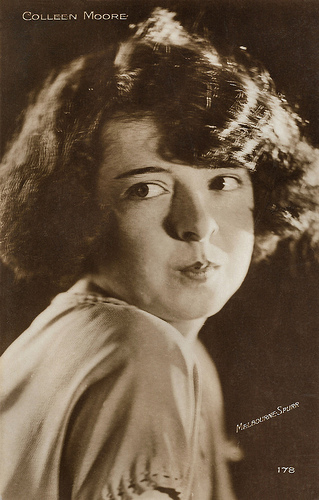
French postcard by Editions Cinémagazine, no. 178. Photo: Melbourne Spurr.
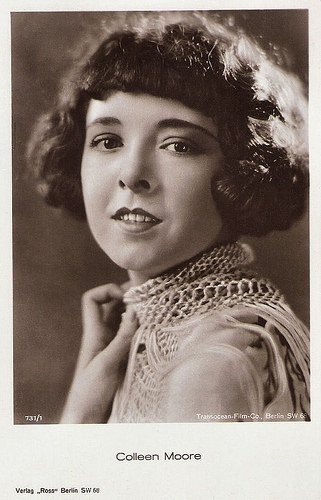
German postcard by Ross Verlag, no. 731/1, 1925-1926. Photo: Transocean-Film-Co., Berlin.
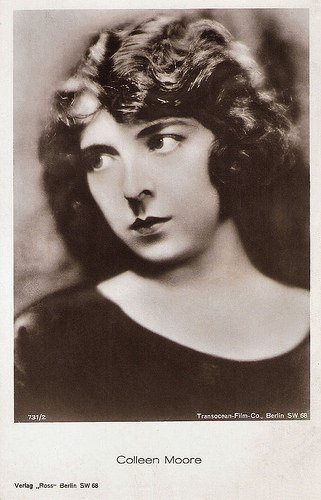
German postcard by Ross Verlag, no. 731/2, 1925-1926. Photo: Transocean-Film-Co., Berlin.
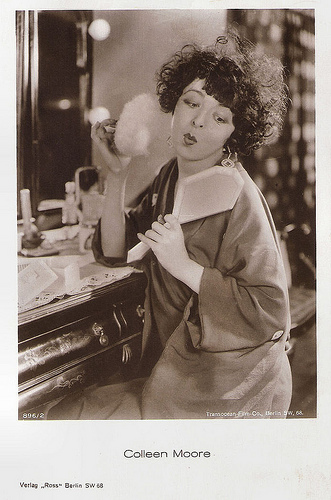
German postcard by Ross Verlag, no. 896/2, 1925-1926. Photo: First National Pictures, New York.
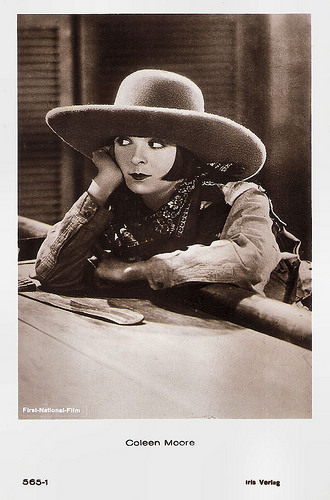
Austrian postcard by Iris-Verlag, no. 565-1. Photo: First-National-Film. Publicity still for The Desert Flower (Irving Cummings, 1925).
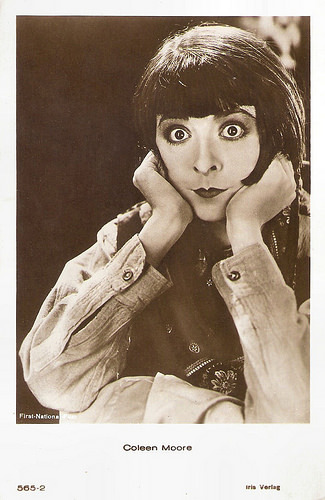
Austrian postcard by Iris-Verlag, no. 565-2. Photo: First-National-Film. Publicity still for The Desert Flower (Irving Cummings, 1925).
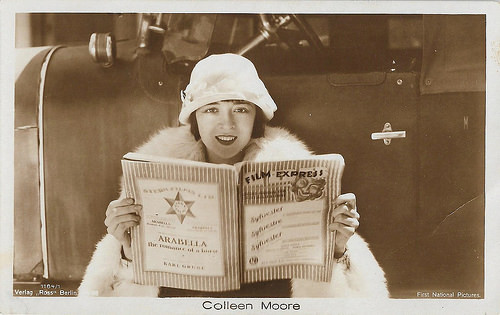
German postcard by Ross Verlag, no. 1184/1, 1927-1928. Photo: First National Pictures.
The inventor of the 'flapper' look
The film which defined Colleen Moore as the inventor of the 'flapper' look was Flaming Youth (John Francis Dillon, 1923), in which she played Patricia Fentriss. Her Dutch bob in the film was soon copied by hairdressers across America and her air of an emancipated young woman inspired countless imitations.
In 1923, she married the first of her four husbands, Frank McCormick, production head of First National Pictures, later part of Warner Brothers. There followed such films as The Perfect Flapper (John Francis Dillon, 1924), The Desert Flower (Irving Cummings, 1925), Ella Cinders (Alfred E. Green, 1926) and Her Wild Oat (Marshall Neilan, 1927).
By 1927 she was the top box-office draw in the US, making $12,500 a week. Her second husband was a New York broker, Albert F. Scott. Moore put her money into the stock market, making very shrewd investments.
She took a hiatus from acting between 1929 and 1933, just as sound film was introduced. Her four sound pictures released in 1933 and 1934 were not financial successes. Moore then retired permanently from screen acting. Her final film role was as Hester Prynne in The Scarlet Letter (Robert G. Vignola, 1934).
In 1937 she married her third husband, Homer Hargrave, again a stockbroker, and ended her film career. After she retired she wrote two books on investing and she travelled widely, frequently to China.
At 83, she married her fourth husband, builder Paul Maginot. In 1988, Colleen Moore died of an undisclosed ailment in Paso Robles, California. She was 88. At the time of her death she was writing a novel, a Hollywood murder mystery centred around a Mae West type.
Tragically, approximately half of Moore's films are now considered lost. Of her most celebrated film, Flaming Youth (1923), only one reel survives.
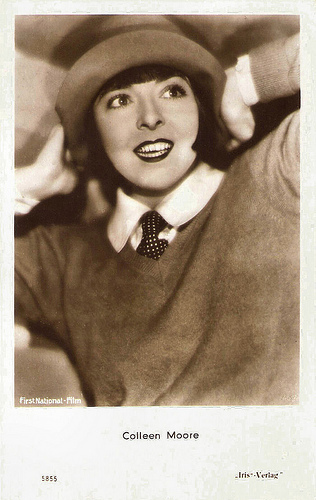
Austrian postcard by Iris-Verlag, no. 5855. Photo: First National-Film.
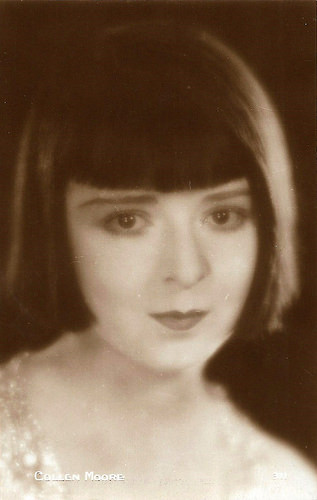
French postcard by Editions Cinémagazine, no. 311.
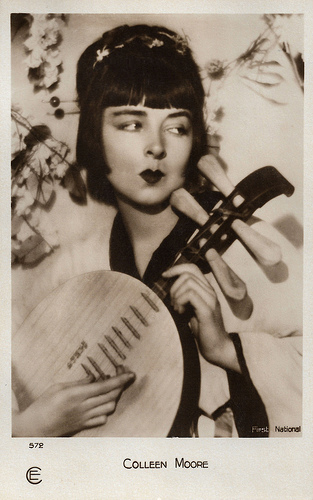
French postcard by Cinémagazine-Edition, no. 572. Photo: Roman Freulich /First National. The photo was specially posed for Motion Picture magazine in 1928.
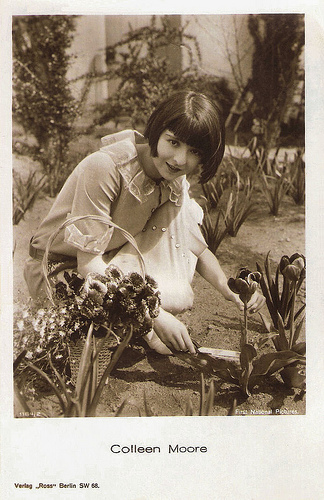
German postcard by Ross Verlag, no. 1184/21, 1927-1928. Photo: First National Pictures.
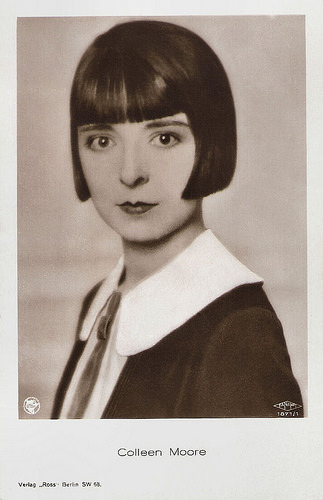
German postcard by Ross Verlag, no. 1871/1, 1927-1928. Photo: First National Pictures / Fanamet.
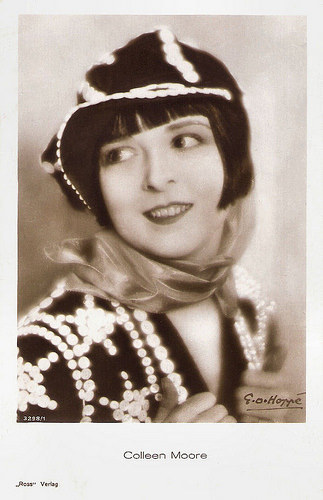
German postcard by Ross Verlag, no. 3298/1, 1928-1929. Photo: E.O. Hoppé.
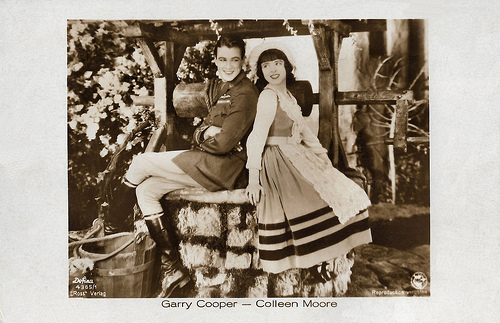
German postcard by Ross Verlag, no. 4365/1, 1929-1930. Photo: Defina / First National. Publicity still for Lilac Time (George Fitzmaurice, 1928) with Gary Cooper.
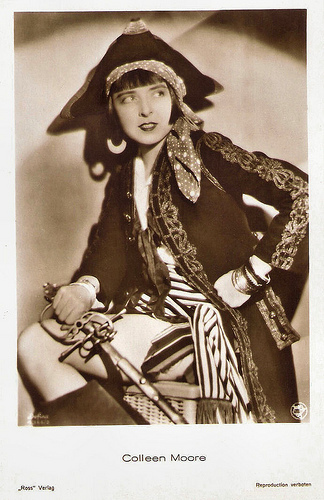
German postcard by Ross Verlag, no. 4366/2, 1929-1930. Photo: Defina / First-National-Film. Publicity still for Oh Kay! (Mervyn LeRoy, 1928).
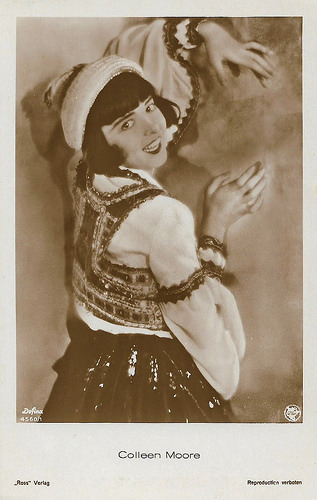
German postcard by Ross Verlag, no. 4560/1, 1929-1930. Photo: Defina / First National.
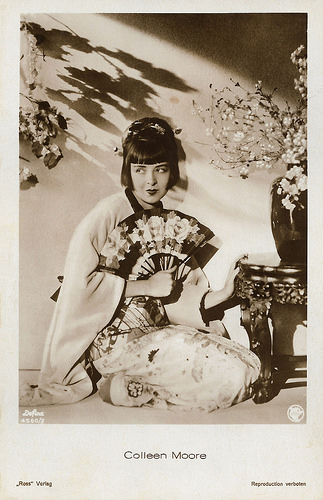
German postcard by Ross Verlag, no. 4560/2, 1929-1930. Photo: Defina / First National Pictures.
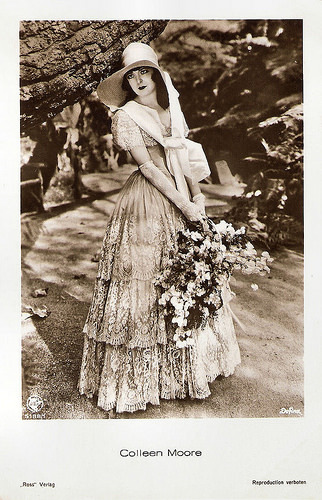
German postcard by Ross Verlag, no. 5188/1, 1930-1931. Photo: First National / Defina.
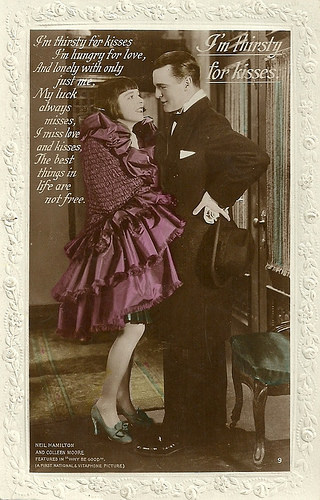
British postcard, no. 9. Photo: First National Pictures. Colleen Moore and Neil Hamilton in Why Be Good? (William A. Seiter, 1929).
Sources: Glenn Fowler (The New York Times), (IMDb), (IMDb), Wikipedia and .

French postcard by Cinémagazine-Edition, Paris, no. 212. Photo: First National Pictures.

German postcard by Ross Verlag, no. 3683/3, 1928-1929. Photo: First National Pictures.

German postcard by Ross Verlag, no. 3469/2, 1928-1929. Photo: Defina / First National Pictures.

German postcard by Ross Verlag, no. 3862/1, 1928-1929. Photo: Defina / First-National-Film.

German postcard by Ross Verlag, no. 4943/1, 1929-1930. Photo: First National Pictures / Defina. Publicity still for Synthetic Sin (William A. Seiter, 1929) with Antonio Moreno.

British Real Photograph postcard.
Colleen was on her way
Colleen Moore was born Kathleen Morrison in Port Huron, Michigan in 1899 (the date which she insisted was correct in her autobiography 'Silent Star' was 1902). Her father was an irrigation engineer and his job was good enough to provide the family a middle-class environment.
She was educated in parochial schools and studied piano at the Detroit Conservatory. As a child she was fascinated with films and stars such as Marguerite Clark and Mary Pickford and kept a scrapbook of those actresses.
By 1917 she was on her way to becoming a star herself. Her uncle, Walter C. Howey, was the editor of the Chicago Tribune and had helped D.W. Griffith make his films The Birth of a Nation (1915) and Intolerance: Love's Struggle Throughout the Ages (1916) more presentable to the censors. Knowing of his niece's acting aspirations, Howey asked Griffith to help her get a start in the film industry.
No sooner had she arrived in Hollywood than she found herself playing in five films that year, The Savage (Rupert Julian, 1917) being her first. Her first starring role was as Annie in Little Orphant Annie (Colin Campbell, 1918).
Colleen was on her way. She also starred in a number of B-films and in Westerns opposite Tom Mix, like The Wilderness Trail (Edward LeSaint, 1919) and The Cyclone (Clifford Smith, 1920).

French postcard by Editions Cinémagazine, no. 178. Photo: Melbourne Spurr.

German postcard by Ross Verlag, no. 731/1, 1925-1926. Photo: Transocean-Film-Co., Berlin.

German postcard by Ross Verlag, no. 731/2, 1925-1926. Photo: Transocean-Film-Co., Berlin.

German postcard by Ross Verlag, no. 896/2, 1925-1926. Photo: First National Pictures, New York.

Austrian postcard by Iris-Verlag, no. 565-1. Photo: First-National-Film. Publicity still for The Desert Flower (Irving Cummings, 1925).

Austrian postcard by Iris-Verlag, no. 565-2. Photo: First-National-Film. Publicity still for The Desert Flower (Irving Cummings, 1925).

German postcard by Ross Verlag, no. 1184/1, 1927-1928. Photo: First National Pictures.
The inventor of the 'flapper' look
The film which defined Colleen Moore as the inventor of the 'flapper' look was Flaming Youth (John Francis Dillon, 1923), in which she played Patricia Fentriss. Her Dutch bob in the film was soon copied by hairdressers across America and her air of an emancipated young woman inspired countless imitations.
In 1923, she married the first of her four husbands, Frank McCormick, production head of First National Pictures, later part of Warner Brothers. There followed such films as The Perfect Flapper (John Francis Dillon, 1924), The Desert Flower (Irving Cummings, 1925), Ella Cinders (Alfred E. Green, 1926) and Her Wild Oat (Marshall Neilan, 1927).
By 1927 she was the top box-office draw in the US, making $12,500 a week. Her second husband was a New York broker, Albert F. Scott. Moore put her money into the stock market, making very shrewd investments.
She took a hiatus from acting between 1929 and 1933, just as sound film was introduced. Her four sound pictures released in 1933 and 1934 were not financial successes. Moore then retired permanently from screen acting. Her final film role was as Hester Prynne in The Scarlet Letter (Robert G. Vignola, 1934).
In 1937 she married her third husband, Homer Hargrave, again a stockbroker, and ended her film career. After she retired she wrote two books on investing and she travelled widely, frequently to China.
At 83, she married her fourth husband, builder Paul Maginot. In 1988, Colleen Moore died of an undisclosed ailment in Paso Robles, California. She was 88. At the time of her death she was writing a novel, a Hollywood murder mystery centred around a Mae West type.
Tragically, approximately half of Moore's films are now considered lost. Of her most celebrated film, Flaming Youth (1923), only one reel survives.

Austrian postcard by Iris-Verlag, no. 5855. Photo: First National-Film.

French postcard by Editions Cinémagazine, no. 311.

French postcard by Cinémagazine-Edition, no. 572. Photo: Roman Freulich /First National. The photo was specially posed for Motion Picture magazine in 1928.

German postcard by Ross Verlag, no. 1184/21, 1927-1928. Photo: First National Pictures.

German postcard by Ross Verlag, no. 1871/1, 1927-1928. Photo: First National Pictures / Fanamet.

German postcard by Ross Verlag, no. 3298/1, 1928-1929. Photo: E.O. Hoppé.

German postcard by Ross Verlag, no. 4365/1, 1929-1930. Photo: Defina / First National. Publicity still for Lilac Time (George Fitzmaurice, 1928) with Gary Cooper.

German postcard by Ross Verlag, no. 4366/2, 1929-1930. Photo: Defina / First-National-Film. Publicity still for Oh Kay! (Mervyn LeRoy, 1928).

German postcard by Ross Verlag, no. 4560/1, 1929-1930. Photo: Defina / First National.

German postcard by Ross Verlag, no. 4560/2, 1929-1930. Photo: Defina / First National Pictures.

German postcard by Ross Verlag, no. 5188/1, 1930-1931. Photo: First National / Defina.

British postcard, no. 9. Photo: First National Pictures. Colleen Moore and Neil Hamilton in Why Be Good? (William A. Seiter, 1929).
Sources: Glenn Fowler (The New York Times), (IMDb), (IMDb), Wikipedia and .
Published on March 17, 2019 23:00
March 16, 2019
Lana Turner
Blonde and voluptuous Lana Turner (1921-1995) was one of the most glamorous superstars of Hollywood's golden era. In the mid-1940s, she was one of the highest-paid women in the United States, and one of MGM's biggest stars, with her films earning the studio over $50 million during her eighteen-year contract with them. Unfortunately, her tumultuous private life sometimes overshadowed her professional accomplishments.
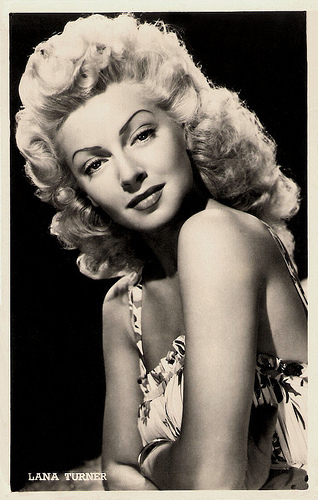
Dutch postcard by J.S.A. (Uitg. J. Sleding N.V., Amsterdam). Photo: Metro Goldwyn Mayer (MGM).
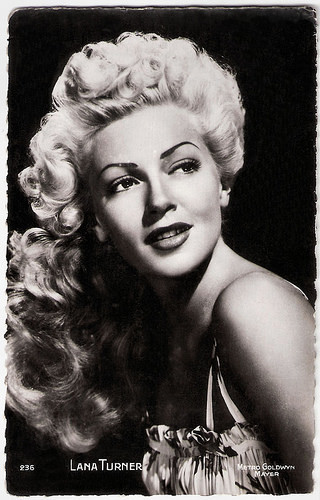
French postcard by Editions P.I., Paris, offered by Victoria, Brussels, no. D 236. Photo: Eric Carpenter / Metro-Goldwyn-Mayer, 1950.
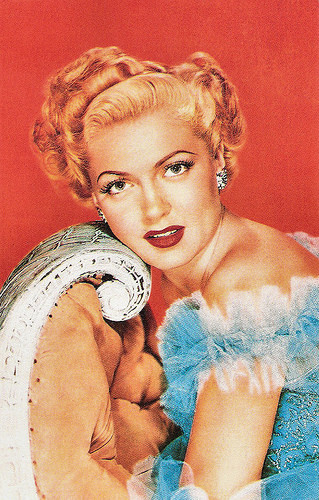
American postcard by Coral-Lee, Rancho Cordova, CA, no. CL/Personality # 107.
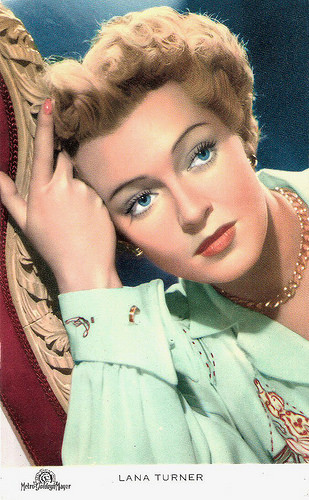
Italian postcard by CCM, no. 2. Photo: MGM.
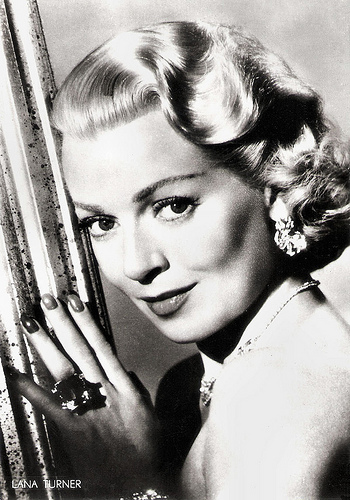
Italian postcard, no. 347.
A show-business legend and part of Hollywood mythology
Lana Turner was born Julia Jean Mildred Francis Turner in Wallace, Idaho, in 1920 or 1921. Her parents were Mildred Frances (Cowan) and John Virgil Turner, a miner. Both were still in their teens when she was born. In 1929, her father was murdered and it was shortly thereafter her mother moved her and the family to California.
Turner's discovery is considered a show-business legend and part of Hollywood mythology. One version erroneously has her discovery occurring at Schwab's Pharmacy. By her own account, as a junior at Hollywood High School, Turner skipped a typing class and bought a Coca-Cola at the Top Hat Malt Shop located on the southeast corner of Sunset Boulevard and McCadden Place.
There she was spotted by William R. Wilkerson, publisher of The Hollywood Reporter. He asked her if she was interested in appearing in films, to which she responded: "I'll have to ask my mother first." With her mother's permission, Turner was referred by Wilkerson to the actor/comedian/talent agent Zeppo Marx.
In December 1936, Marx introduced Turner to film director Mervyn LeRoy, who signed her to a fifty-dollar weekly contract with Warner Bros. In 1937, 17-years-old Lana entered the film world, and made her debut in the crime drama They Won't Forget (Mervyn LeRoy, 1937). She attracted attention with her small role as a murder victim. After that followed parts in the historical comedy The Great Garrick (James Whale, 1937) and A Star is Born (William A. Wellman, 1937) with Janet Gaynor .
In 1938 she had another supportting part in Love Finds Andy Hardy (George B. Seitz, 1938) starring Mickey Rooney . The film made her known as 'The Sweater Girl'. (Some sources say otherwise). Her auburn hair was bleached for Idiot's Delight (Clarence Brown, 1939). She was withdrawn from the film, but the fact that she had become a blonde not only changed her screen image but gave her such an outgoing, swinging personality that Hollywood called her 'the Nightclub Queen'.
One of her first lead roles was in Dancing Co-Ed (S. Sylvan Simon, 1939), a vehicle for 28-year-old bandleader Artie Shaw. The two married, but their highly publicised marriage only lasted four months. Turner became a popular pin-up, especially with American soldiers fighting overseas, and her image appeared painted on the noses of U.S. fighter planes, bearing the nickname 'Tempest Turner'.
In 1941 she starred in the Western Honky Tonk (Jack Conway, 1941), her first major hit. It was the first of four films in which she would star opposite Clark Gable. She was now firmly entrenched in the film business. She had good roles in such films as the Film Noir Johnny Eager (Mervyn LeRoy, 1941), the musical Ziegfeld Girl (Robert Z. Leonard, 1941) with Hedy Lamarr and Judy Garland , the horror film Dr. Jekyll and Mr. Hyde (Victor Fleming, 1941), the romantic war drama Somewhere I'll Find You (Wesley Ruggles, 1942) with Gable again, and Week-End at the Waldorf (Robert Z. Leonard, 1945).
If her career was progressing smoothly, however, her private life was turning into a train wreck, keeping her in the news in a way no one would have wanted. Upon separating from Shaw, Turner married actor-turned-restaurateur Stephen Crane, but when his earlier divorce was declared invalid, a media frenzy followed. They remarried, but divorced in 1944. In the meanwhile their daughter Cheryl was born.
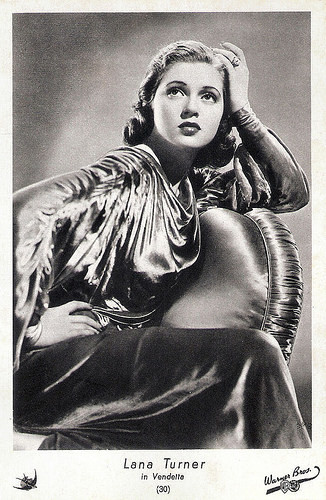
Italian postcard in the '100 Artisti del Cinema' series by Edizione Elah 'La Casa delle Caramelle', no. 30. Photo: Warner Bros. Photo: Warner Bros. Publicity still for They Won't Forget (Mervyn LeRoy, 1937). Vendetta is the Italian title for the film.
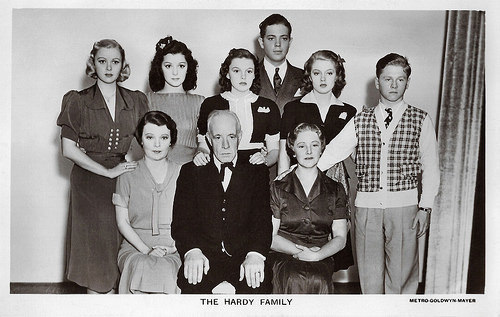
British postcard in the Picturegoer Series, London, no. 1280. Photo: Metro-Goldwyn-Mayer. Publicity still for Love Finds Andy Hardy (George B. Seitz, 1938) with (back row) Cecilia Parker, Ann Rutherford, Judy Garland , Gene Reynolds, Lana Turner and (front row) Mary Howard, Lewis Stone, Fay Holden and Mickey Rooney .

British postcard in the Picturegoer Series, London, no. 1281. Photo: Metro-Goldwyn-Mayer. Publicity still for Love Finds Andy Hardy (George B. Seitz, 1938) with Mickey Rooney , Ann Rutherford, Judy Garland and Lana Turner.
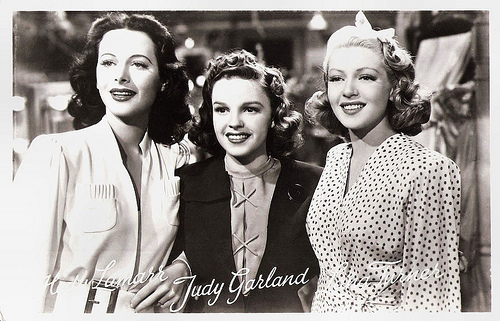
Dutch postcard, no. 3114. Photo: MGM. Publicity still for Ziegfeld Girl (Robert Z. Leonard, Busby Berkeley, 1941) with Hedy Lamarr and Judy Garland .
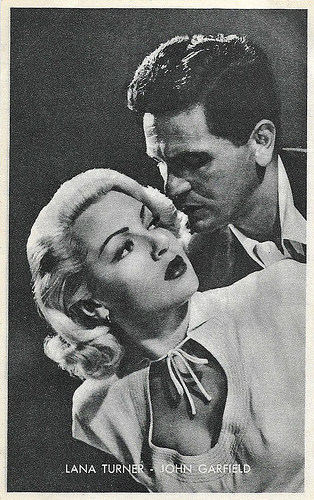
Belgian Collectors Card by Kwatta, Bois d'Haine, no. C. 173. Photo: Metro-Goldwyn-Mayer. Collection: Geoffrey Donaldson Institute. Publicity still for The Postman Always Rings Twice (Tay Garnett, 1946) with John Garfield.
The team that generates steam
Lana Turner's most sultry and effective turn to date was the femme fatale in the Film Noir The Postman Always Rings Twice (Tay Garnett, 1946). She portrayed Cora, a young and ambitious woman married to a stodgy, older owner of a roadside diner (Cecil Kellaway), who falls in love with a drifter (John Garfield) and their desire to be together motivates them to murder her husband.
The film, based on the debut novel of James Cain, was a tremendous success, and it made Turner one of Hollywood's brightest stars. Bosley Crowther, film critic of The New York Times, gave the film a positive review and lauded the acting and direction of the film: "Too much cannot be said for the principals. Mr. Garfield reflects to the life the crude and confused young hobo who stumbles aimlessly into a fatal trap. And Miss Turner is remarkably effective as the cheap and uncertain blonde who has a pathetic ambition to 'be somebody' and a pitiful notion that she can realize it through crime."
In August 1947, only moments after having completed filming of Cass Timberlane (George Sidney, 1947), Turner agreed to appear as the female lead in Homecoming (Mervyn LeRoy, 1948). In this World War II-set romantic drama, she was again paired with Clark Gable, portraying a female army lieutenant who falls in love an American surgeon (Gable). She was the studio's first choice for the role, but they were reluctant to offer her the part, considering her overbooked schedule. Homecoming was well-received by audiences, and Turner and Gable were nicknamed 'the team that generates steam'.
Turner was at the zenith of her film career, and was not only MGM's most popular star, but also one of the 10 highest-paid women in the United States, with annual earnings of $226,000 (equivalent to $2,400,000 in 2018). In late 1947, Turner was cast opposite Gene Kelly as Lady de Winter in The Three Musketeers (George Sidney, 1947), her first Technicolor film. Her popularity continued through the 1950s in dramas such as The Bad and the Beautiful (Vincente Minnelli, 1952) with Kirk Douglas .
After a sabbatical, Lana Turner returned with Peyton Place (Mark Robson, 1957). The adaptation of Grace Metalious' infamous best-seller about the steamy passions simmering beneath the surface of small-town life was hugely successful. Turner's performance won her an Academy Award nomination.
The following year she made international headlines when her lover, gangster Johnny Stampanato, was stabbed to death by her teenage daughter, Cheryl Crane. Crane was eventually acquitted on the grounds of justifiable homicide, but Turner's reputation took a severe beating.
Douglas Sirk's Imitation of Life (1959) was Turner's last major hit. Sirk's final melodrama has an engaging and emotional story with romance, ambition, friendship, love and rejection. The subplot of Turner's black housekeeper Annie (Juanita Moore) who is rejected by her light-skinned daughter (Susan Kohner), in a time when the colour of people was a watershed, is still heartbreaking. Imitation of Life was one of the biggest hits of the year, and the biggest of Turner's career: she owned 50% of the earnings of the picture.
Her final starring role in Madame X (David Lowell Rich, 1966) opposite Ricardo Montalban, earned her a David di Donatello Award for Best Foreign Actress. Her final film, Witches' Brew (Richard Shorr, Herbert L. Strock, 1980) with Teri Garr, a semi-comic remake of the horror classic Weird Woman (Reginald LeBorg, 1944), was shot in 1978 but not widely released until 1985.
In 1982, she published an autobiography, 'Lana: The Lady, the Legend, the Truth', and also began a stint as a semi-regular on the TV soap opera Falcon Crest (1982-1983). Her daughter, Cheryl Crane, also wrote a book about her life with her mother, her mother's 7 husbands and numerous boyfriends and living in Hollywood. 'Detour: A Hollywood Story' was published in 1988.
In 1992 Lana Turner was diagnosed with throat cancer. After spending the majority of her final decade in retirement, Lana Turner died in 1995, at the age of 74. She bequeathed her companion and housekeeper her entire trust estate, valued at almost $2 million, including her apartment in Century City and rights to all income producing assets. She changed the beneficiary of her trust estate in the last years of her life, from her daughter to her housekeeper, and instead left her daughter a cash bequest of only $50,000.
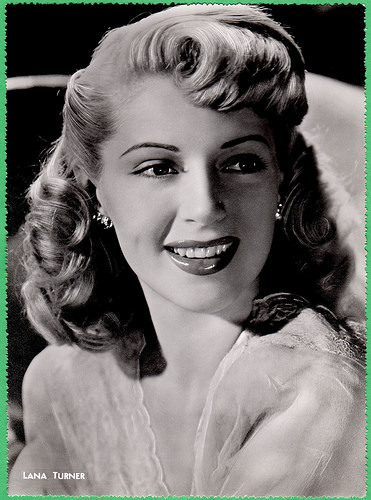
Belgian collectors card by Chocolaterie Clovis, Pepinster. Collection: Amit Benyovits.
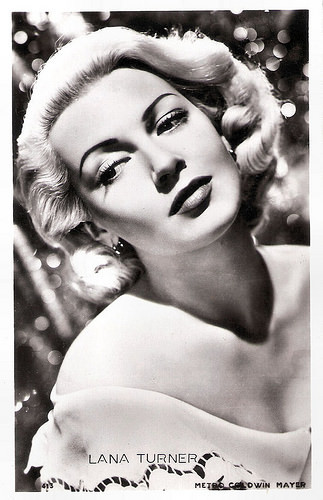
French postcardby Editions P.I., Paris, no. 22 D. Photo: Metro Goldwyn Mayer (MGM), 1953.
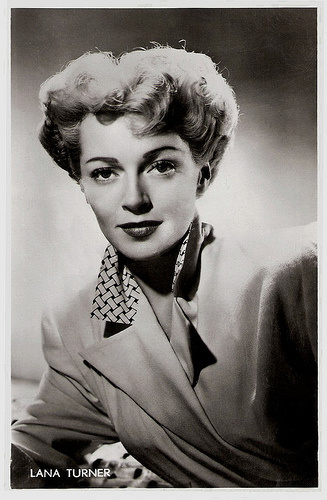
Dutch postcard. Photo: MGM.
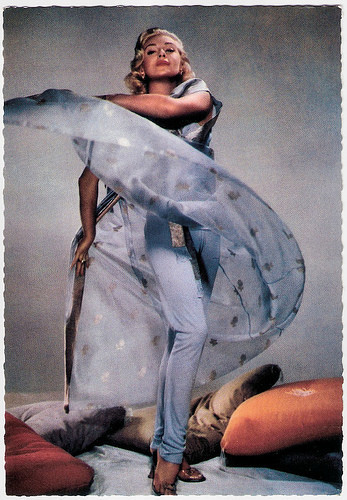
German postcard by ISV, no. D 16. Photo: Star Press.
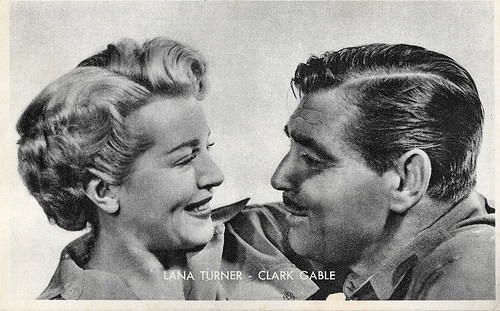
Belgian Collectors Card by Kwatta, Bois d'Haine, no. C. 168. Photo: Metro-Goldwyn-Mayer. Publicity still for Homecoming (Mervyn LeRoy, 1948) with Clark Gable.
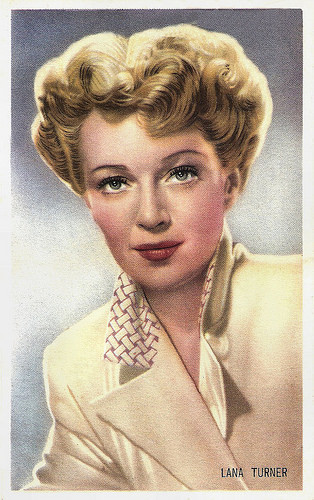
Belgian collectors card by Kwatta, Bois d'Haine, no. C 209. Photo: Metro-Goldwyn-Mayer.
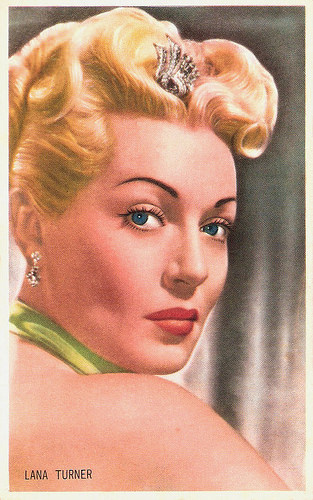
Belgian collectors card by Kwatta, Bois d'Haine, no. C 307. Photo: Metro-Goldwyn-Mayer. Publicity still for A Life of Her Own (George Cukor, 1950).
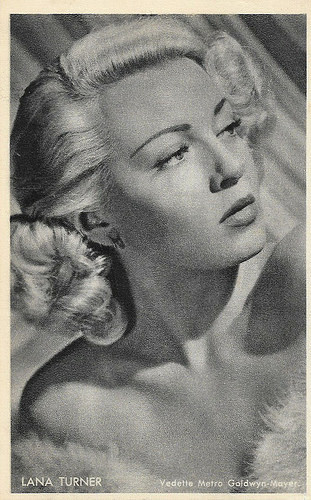
Belgian Collectors Card by Kwatta, Bois d'Haine. Photo: Metro-Goldwyn-Mayer. Collection: Geoffrey Donaldson Institute.
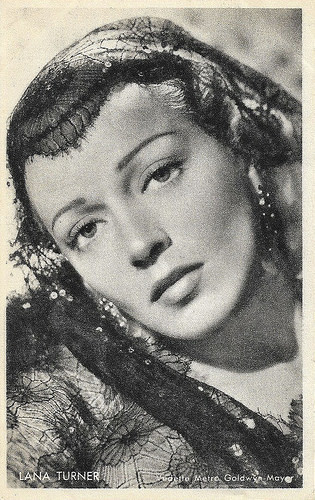
Belgian Collectors Card by Kwatta, Bois d'Haine. Photo: Metro-Goldwyn-Mayer. Collection: Geoffrey Donaldson Institute.
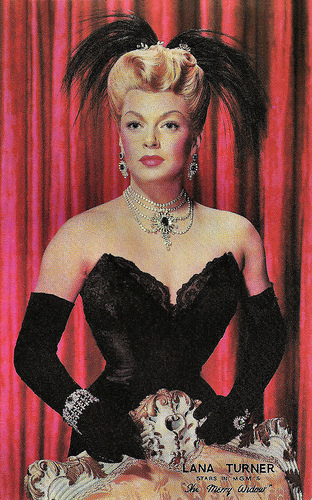
American postcard by Dexter Press, Pearl River, N.Y., no. 61952. Photo: Metro-Goldwyn-Mayer. Publicity still for The Merry Widow (Curtis Bernhardt, 1952).
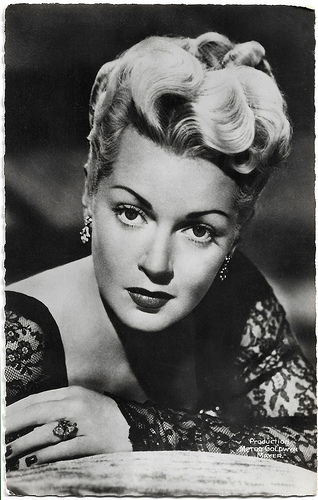
French postcard by Editions du Globe, Paris, no. 408. Photo: Metro Goldwyn Mayer (MGM).
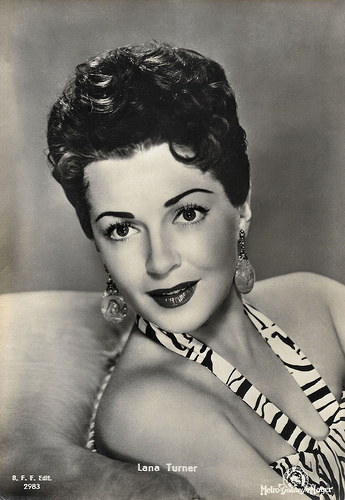
Italian postcard by B.F.F. Edit., no. 2983. Photo: Metro Goldwyn Mayer (MGM).
Source: Jason Ankeny (AllMovie), Wikipedia and .

Dutch postcard by J.S.A. (Uitg. J. Sleding N.V., Amsterdam). Photo: Metro Goldwyn Mayer (MGM).

French postcard by Editions P.I., Paris, offered by Victoria, Brussels, no. D 236. Photo: Eric Carpenter / Metro-Goldwyn-Mayer, 1950.

American postcard by Coral-Lee, Rancho Cordova, CA, no. CL/Personality # 107.

Italian postcard by CCM, no. 2. Photo: MGM.

Italian postcard, no. 347.
A show-business legend and part of Hollywood mythology
Lana Turner was born Julia Jean Mildred Francis Turner in Wallace, Idaho, in 1920 or 1921. Her parents were Mildred Frances (Cowan) and John Virgil Turner, a miner. Both were still in their teens when she was born. In 1929, her father was murdered and it was shortly thereafter her mother moved her and the family to California.
Turner's discovery is considered a show-business legend and part of Hollywood mythology. One version erroneously has her discovery occurring at Schwab's Pharmacy. By her own account, as a junior at Hollywood High School, Turner skipped a typing class and bought a Coca-Cola at the Top Hat Malt Shop located on the southeast corner of Sunset Boulevard and McCadden Place.
There she was spotted by William R. Wilkerson, publisher of The Hollywood Reporter. He asked her if she was interested in appearing in films, to which she responded: "I'll have to ask my mother first." With her mother's permission, Turner was referred by Wilkerson to the actor/comedian/talent agent Zeppo Marx.
In December 1936, Marx introduced Turner to film director Mervyn LeRoy, who signed her to a fifty-dollar weekly contract with Warner Bros. In 1937, 17-years-old Lana entered the film world, and made her debut in the crime drama They Won't Forget (Mervyn LeRoy, 1937). She attracted attention with her small role as a murder victim. After that followed parts in the historical comedy The Great Garrick (James Whale, 1937) and A Star is Born (William A. Wellman, 1937) with Janet Gaynor .
In 1938 she had another supportting part in Love Finds Andy Hardy (George B. Seitz, 1938) starring Mickey Rooney . The film made her known as 'The Sweater Girl'. (Some sources say otherwise). Her auburn hair was bleached for Idiot's Delight (Clarence Brown, 1939). She was withdrawn from the film, but the fact that she had become a blonde not only changed her screen image but gave her such an outgoing, swinging personality that Hollywood called her 'the Nightclub Queen'.
One of her first lead roles was in Dancing Co-Ed (S. Sylvan Simon, 1939), a vehicle for 28-year-old bandleader Artie Shaw. The two married, but their highly publicised marriage only lasted four months. Turner became a popular pin-up, especially with American soldiers fighting overseas, and her image appeared painted on the noses of U.S. fighter planes, bearing the nickname 'Tempest Turner'.
In 1941 she starred in the Western Honky Tonk (Jack Conway, 1941), her first major hit. It was the first of four films in which she would star opposite Clark Gable. She was now firmly entrenched in the film business. She had good roles in such films as the Film Noir Johnny Eager (Mervyn LeRoy, 1941), the musical Ziegfeld Girl (Robert Z. Leonard, 1941) with Hedy Lamarr and Judy Garland , the horror film Dr. Jekyll and Mr. Hyde (Victor Fleming, 1941), the romantic war drama Somewhere I'll Find You (Wesley Ruggles, 1942) with Gable again, and Week-End at the Waldorf (Robert Z. Leonard, 1945).
If her career was progressing smoothly, however, her private life was turning into a train wreck, keeping her in the news in a way no one would have wanted. Upon separating from Shaw, Turner married actor-turned-restaurateur Stephen Crane, but when his earlier divorce was declared invalid, a media frenzy followed. They remarried, but divorced in 1944. In the meanwhile their daughter Cheryl was born.

Italian postcard in the '100 Artisti del Cinema' series by Edizione Elah 'La Casa delle Caramelle', no. 30. Photo: Warner Bros. Photo: Warner Bros. Publicity still for They Won't Forget (Mervyn LeRoy, 1937). Vendetta is the Italian title for the film.

British postcard in the Picturegoer Series, London, no. 1280. Photo: Metro-Goldwyn-Mayer. Publicity still for Love Finds Andy Hardy (George B. Seitz, 1938) with (back row) Cecilia Parker, Ann Rutherford, Judy Garland , Gene Reynolds, Lana Turner and (front row) Mary Howard, Lewis Stone, Fay Holden and Mickey Rooney .

British postcard in the Picturegoer Series, London, no. 1281. Photo: Metro-Goldwyn-Mayer. Publicity still for Love Finds Andy Hardy (George B. Seitz, 1938) with Mickey Rooney , Ann Rutherford, Judy Garland and Lana Turner.

Dutch postcard, no. 3114. Photo: MGM. Publicity still for Ziegfeld Girl (Robert Z. Leonard, Busby Berkeley, 1941) with Hedy Lamarr and Judy Garland .

Belgian Collectors Card by Kwatta, Bois d'Haine, no. C. 173. Photo: Metro-Goldwyn-Mayer. Collection: Geoffrey Donaldson Institute. Publicity still for The Postman Always Rings Twice (Tay Garnett, 1946) with John Garfield.
The team that generates steam
Lana Turner's most sultry and effective turn to date was the femme fatale in the Film Noir The Postman Always Rings Twice (Tay Garnett, 1946). She portrayed Cora, a young and ambitious woman married to a stodgy, older owner of a roadside diner (Cecil Kellaway), who falls in love with a drifter (John Garfield) and their desire to be together motivates them to murder her husband.
The film, based on the debut novel of James Cain, was a tremendous success, and it made Turner one of Hollywood's brightest stars. Bosley Crowther, film critic of The New York Times, gave the film a positive review and lauded the acting and direction of the film: "Too much cannot be said for the principals. Mr. Garfield reflects to the life the crude and confused young hobo who stumbles aimlessly into a fatal trap. And Miss Turner is remarkably effective as the cheap and uncertain blonde who has a pathetic ambition to 'be somebody' and a pitiful notion that she can realize it through crime."
In August 1947, only moments after having completed filming of Cass Timberlane (George Sidney, 1947), Turner agreed to appear as the female lead in Homecoming (Mervyn LeRoy, 1948). In this World War II-set romantic drama, she was again paired with Clark Gable, portraying a female army lieutenant who falls in love an American surgeon (Gable). She was the studio's first choice for the role, but they were reluctant to offer her the part, considering her overbooked schedule. Homecoming was well-received by audiences, and Turner and Gable were nicknamed 'the team that generates steam'.
Turner was at the zenith of her film career, and was not only MGM's most popular star, but also one of the 10 highest-paid women in the United States, with annual earnings of $226,000 (equivalent to $2,400,000 in 2018). In late 1947, Turner was cast opposite Gene Kelly as Lady de Winter in The Three Musketeers (George Sidney, 1947), her first Technicolor film. Her popularity continued through the 1950s in dramas such as The Bad and the Beautiful (Vincente Minnelli, 1952) with Kirk Douglas .
After a sabbatical, Lana Turner returned with Peyton Place (Mark Robson, 1957). The adaptation of Grace Metalious' infamous best-seller about the steamy passions simmering beneath the surface of small-town life was hugely successful. Turner's performance won her an Academy Award nomination.
The following year she made international headlines when her lover, gangster Johnny Stampanato, was stabbed to death by her teenage daughter, Cheryl Crane. Crane was eventually acquitted on the grounds of justifiable homicide, but Turner's reputation took a severe beating.
Douglas Sirk's Imitation of Life (1959) was Turner's last major hit. Sirk's final melodrama has an engaging and emotional story with romance, ambition, friendship, love and rejection. The subplot of Turner's black housekeeper Annie (Juanita Moore) who is rejected by her light-skinned daughter (Susan Kohner), in a time when the colour of people was a watershed, is still heartbreaking. Imitation of Life was one of the biggest hits of the year, and the biggest of Turner's career: she owned 50% of the earnings of the picture.
Her final starring role in Madame X (David Lowell Rich, 1966) opposite Ricardo Montalban, earned her a David di Donatello Award for Best Foreign Actress. Her final film, Witches' Brew (Richard Shorr, Herbert L. Strock, 1980) with Teri Garr, a semi-comic remake of the horror classic Weird Woman (Reginald LeBorg, 1944), was shot in 1978 but not widely released until 1985.
In 1982, she published an autobiography, 'Lana: The Lady, the Legend, the Truth', and also began a stint as a semi-regular on the TV soap opera Falcon Crest (1982-1983). Her daughter, Cheryl Crane, also wrote a book about her life with her mother, her mother's 7 husbands and numerous boyfriends and living in Hollywood. 'Detour: A Hollywood Story' was published in 1988.
In 1992 Lana Turner was diagnosed with throat cancer. After spending the majority of her final decade in retirement, Lana Turner died in 1995, at the age of 74. She bequeathed her companion and housekeeper her entire trust estate, valued at almost $2 million, including her apartment in Century City and rights to all income producing assets. She changed the beneficiary of her trust estate in the last years of her life, from her daughter to her housekeeper, and instead left her daughter a cash bequest of only $50,000.

Belgian collectors card by Chocolaterie Clovis, Pepinster. Collection: Amit Benyovits.

French postcardby Editions P.I., Paris, no. 22 D. Photo: Metro Goldwyn Mayer (MGM), 1953.

Dutch postcard. Photo: MGM.

German postcard by ISV, no. D 16. Photo: Star Press.

Belgian Collectors Card by Kwatta, Bois d'Haine, no. C. 168. Photo: Metro-Goldwyn-Mayer. Publicity still for Homecoming (Mervyn LeRoy, 1948) with Clark Gable.

Belgian collectors card by Kwatta, Bois d'Haine, no. C 209. Photo: Metro-Goldwyn-Mayer.

Belgian collectors card by Kwatta, Bois d'Haine, no. C 307. Photo: Metro-Goldwyn-Mayer. Publicity still for A Life of Her Own (George Cukor, 1950).

Belgian Collectors Card by Kwatta, Bois d'Haine. Photo: Metro-Goldwyn-Mayer. Collection: Geoffrey Donaldson Institute.

Belgian Collectors Card by Kwatta, Bois d'Haine. Photo: Metro-Goldwyn-Mayer. Collection: Geoffrey Donaldson Institute.

American postcard by Dexter Press, Pearl River, N.Y., no. 61952. Photo: Metro-Goldwyn-Mayer. Publicity still for The Merry Widow (Curtis Bernhardt, 1952).

French postcard by Editions du Globe, Paris, no. 408. Photo: Metro Goldwyn Mayer (MGM).

Italian postcard by B.F.F. Edit., no. 2983. Photo: Metro Goldwyn Mayer (MGM).
Source: Jason Ankeny (AllMovie), Wikipedia and .
Published on March 16, 2019 23:00
March 15, 2019
Photo by Messter-Film
Oskar Messter was the 'Father of the German Film Industry'. This film pioneer founded his production company Messter-Film in the early years of cinema. The main star of the studio was Henny Porten, who already made her film debut in 1906. Another star was the Danish actor Viggo Larsen. During the 1910s, Messter-Film was one of the dominant German film studios and produced over 300 films, until it was merged into the UFA in 1918.
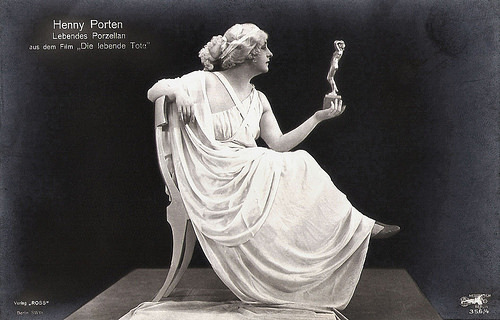
German postcard by Ross Verlag, Berlin, no. 356/4. Photo: Messter-Film. Publicity still for Die lebende Tote/The living dead (Rudolf Biebrach, 1919). Henny Porten appeared in several early films as 'Lebendes Porzellan' (living china).
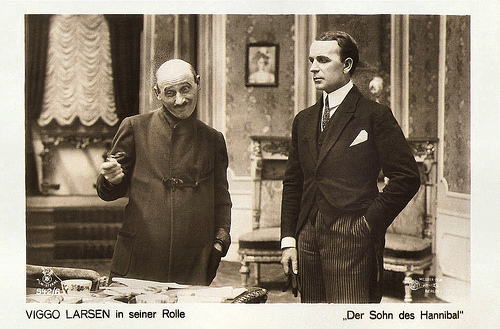
German postcard by Rotophot in the Film Sterne series, no. 542/6. Photo: Messter-Film. Publicity still of Viggo Larsen in Der Sohn des Hannibal/The Son of Hannibal (Viggo Larsen, 1918).
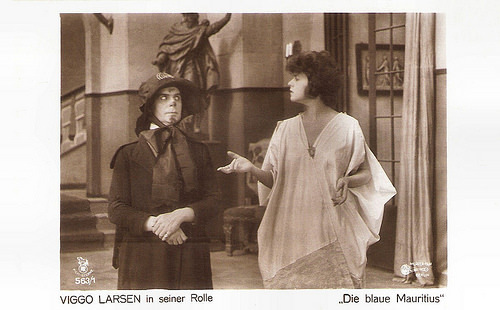
German postcard by Rotophot in the Film Sterne series, no. 563/1. Photo: Messter-Film, Berlin, Berlin. Publicity still with Viggo Larsen and Ria Jende in Die blaue Mauritius/The Blue Mauritius (Viggo Larsen, 1918).
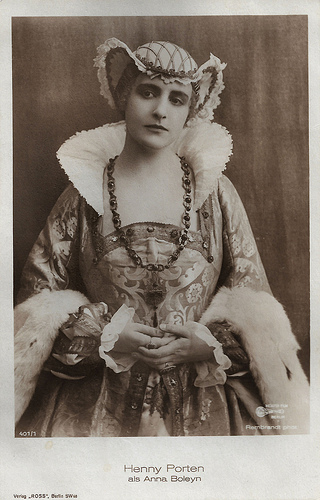
German postcard by Ross Verlag, no. 401/1. Photo: Rembrandt / Messter Film. Publicity still of Henny Porten in Anna Boleyn (Ernst Lubitsch, 1920).
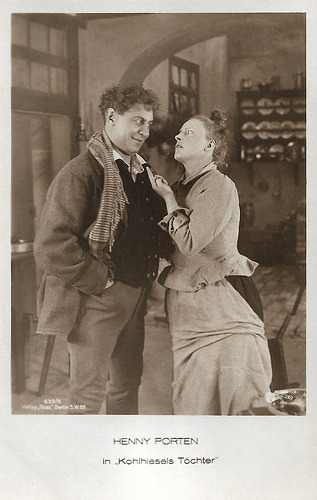
German postcard by Ross Verlag no. 639/5. Photo: Messter-Film. Publicity still of Emil Jannings and Henny Porten in Kohlhiesels Töchter/Kohlhiesel's Daughters (Ernst Lubitsch, 1920).
Film pioneer Oskar Messter
Oskar Eduard Messter (1866-1943) was born in Berlin, where his father Eduard had founded in 1859 a company called 'Optisches und Mechanisches Institut Ed. Messter'. This company manufactured and sold eyeglasses, precision medical devices, optical devices for magicians and show businessmen, electric reflectors for theatres, and projectors for the magic lantern.
Oskar finished an education as an optician by his father. This education proved to be essential for his later career. Oskar acquired both business, optical and mechanical skills, which he later applied in cinematography. He took over the management of his father's company in 1895 and only one year later he developed his first own film projector and began to produce cameras and film projectors in series.
This was one of the first projectors using a Geneva drive to achieve the intermittent motion of the film. He is often credited with inventing this application of the Geneva drive, but both Max Gliewe (also in Berlin) and Robert W. Paul in London independently built projectors using this mechanism for film transport at about the same time. Gliewe later joined Messter's company, and together they produced highly successful projectors. By the end of 1896, Messters-Projection Berlin had produced 64 projectors: 42 of these were sold in Germany and 22, in the rest of Europe.
On 15 June 1896, Messter rented a small theatre that had gone bankrupt at 21 Unter den Linden and inaugurated the second cinema hall in Berlin. The first cinema hall was opened by the envoys of the Lumière brothers that precise year. Messter demonstrated his first own short films to an enthusiastic audience. These films were short documentaries of contemporary events and showed partially everyday entities, partially huge occasions. But everything was interesting and fascinating for the film unacquainted audience.
Messter produced such films as Schlittschuhläufer auf der West-Eisbahn/A Skater at the West Rink (1896), Am Brandenburger Tor zu Berlin/At the Brandenburg Gate, Berlin (1896), Umsturz einer Mauer/Subversion of a wall (1897), Stapellauf vom Kreuzer Wilhelm der Grossen/Launch of cruiser Wilhelm the Great (1897), or Seine Majestät Kaiser Wilhelm II in Stettin/His Majesty Kaiser Wilhelm II in Szczecin (1897). In 1897, Messter already offered 84 films showing a wide variety of scenes.
In just four years, the company's profits had multiplied tenfold. In 1900, Oskar formed his own production company in Berlin, Messter Projections. A year later, he restructured his company into separate firms for film production, distribution, and the manufacturing of optical equipment, including film projectors.
Messter presented the Biophon, his method of producing talking films, as the headlining attraction at Berlin's Apollo Theatre in August 1903. Oskar used his Biophon to shoot his first films at the World Fair in Saint Louis, Missouri, in 1904. These films contained a sound-on-disc system.
He also produced 'short films of stage performances, among them Rapunzel (1897), Hänsel und Gretel/Hansel and Gretel (1897), Die bösen Buben/The bad boys (1897), Walküre (1898), Schlussszene des II Aktes aus Der Fall Corignan/Final scene of the II act from The Fall Corignan (1898) and Der verliebte Reservemann/The Reserve man in love (1898).
To his other milestones belong the development of the slow motion camera, the camera for microscopical shots, the realisation of the very first newsreel and the foundation of the Sascha-Messter-Film together with Sascha Kolowrat-Krakowsky. Oskar Messter continued his career as a producer in the new century and he was also always interested in new inventions.
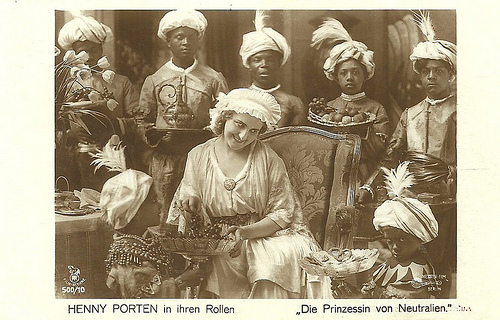
German postcard by Rotophot in the Film Sterne series, no. 500/10. Photo: Messter-Film, Berlin. Publicity still of Henny Porten in Die Prinzessin von Neutralien/The Princess of Neutralia (Rudolf Biebrach, 1917).
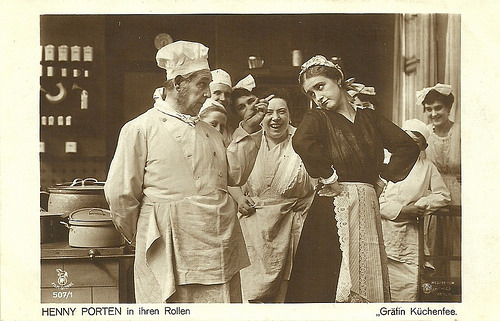
German postcard in the Film Sterne series by Rotophot, no. 507/1. Photo: Messter Film. Publicity still of Henny Porten in Gräfin Küchenfee/Countess Kitchen Fairy (Robert Wiene, 1918).
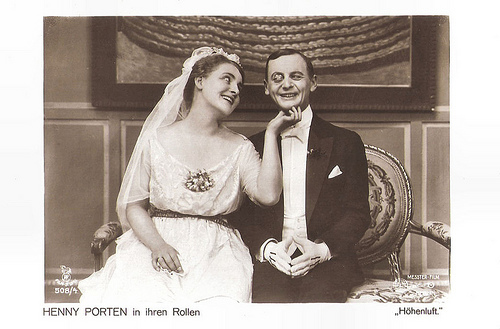
German postcard in the Film Sterne series by Rotophot, no. 508/4. Photo: Messter-Film. Publicity still of Henny Porten and Reinhold Schünzel in the comedy Höhenluft/Mountain air (Rudolf Biebrach, 1917).
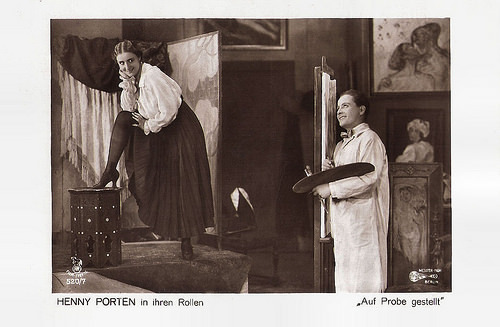
German postcard in the Film Sterne series by Rotophot, no. 520/7. Photo: Messter Film, Berlin. Publicity still of Henny Porten for Auf Probe gestellt/Put to the test (Rudolf Biebrach, 1918).
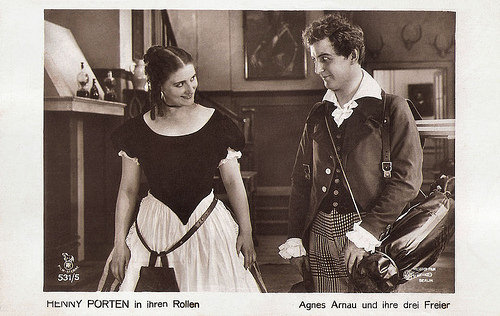
German postcard by Rotophot in the Film Sterne series, no. 531/5. Photo: Messter Film. Publicity still of Henny Porten and Hermann Thimig in Agnes Arnau und ihre drei Freier/Agnes Arnau and her three suitors (Rudolf Biebrach, 1918).
One of the constructors of Stardom
Messter-Film produced a total of three hundred and twenty six silent films between 1896 and 1918. Until 1910, all of them were short films of very short duration and from 1911, they were already medium-length films and feature films.
When the film became established in the 1910s and many directors made films, Oskar Messter remained an important producer in the film business. In the next years he realised more fiction films and less documentaries.
Many stars of the German silent cinema started their careers in these years in the films of Oskar Messter. Among them were such actors as Emil Jannings , Werner Krauss and Paul Hartmann and actresses as Wanda Treumann and Erna Morena , but also future directors like Robert Wiene and Carl Froelich.
Messter was one of the constructors of "stardom" through his promotion of the actress Henny Porten . Porten had already made her first film appearance in Meißner Porzellan/The Porcelain of Meissner (1906), a very short sound film, directed by her father, Franz Porten, for Oskar Messter. In 1907, after finishing her studies at the De Múgica College for Elderly Daughters, the young Porten became a professional actress. She signed an exclusive contract with Messter and starred in the film Lohengrin (Franz Porten, 1910), based on the opera by Richard Wagner. Although without great box office success at first, her striking appearance and simple style of acting exerted a magnetic effect on the public.
Henny became the first diva of the German cinema with her role as a blind girl in the melodrama Das Liebesglucke der Blinden/The Love of a Blind Girl (Heinrich Bolten-Baeckers, Curt A. Stark, 1910), written by her sister Rosa Porten . People started to ask for her name, and thus the Messter girl became one of the first film stars who was known by name.
In January 1911, Messter concluded a one month contract with Porten, which was repeatedly extended. Until 1918, she would make a hundred films for Messter-Film. In 1912, Porten appeared in Maskierte Liebe/Love Masked (Adolf Gärtner, Curt A. Stark, 1912), the first feature film of the Messters-Projection GmbH, Berlin. In 1913/1914 with the success of Eva (Curt A. Stark, 1913), an 'Autorenfilm', there followed the first of the 'Henny Porten film star series', which began with Der Feind im Land/Faithful Unto Death (Curt A. Stark, 1913).
Rudolf Biebrach, who in earlier films often played her father, now takes on the work of film director. At the end of World War I, Porten films are at the peak of success with German film audiences. The filming of the stage play Rose Bernd (Alfred Halm, 1919) is a big success, which greatly adds to the prestige of cinematography among German educated classes as well as critics.
This success is followed with three more hits, the comedy Kohlhiesels Töchter/Kohlhiesel's Daughters (Ernst Lubitsch, 1920), Monika Vogelsang (Rudolf Biebrach, 1920) and Anna Boleyn (Ernst Lubitsch, 1920). The latter two are among the most expensive projects up till then of Messter-Film. But by then, Oskar Messter has retired and Messter-Film has become part of a huge, new conglomerate...
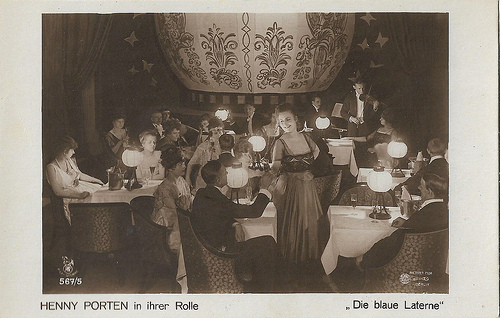
German postcard in the Film-Sterne series by Rotophot, no. 567/5. Photo: Messter-Film, Berlin. Publicity still of Henny Porten in Die blaue Laterne/The Blue Lantern (Rudolf Biebrach, 1918), based on the novel by Paul Lindau. Porten is visible here in the inn The Blue Lantern.
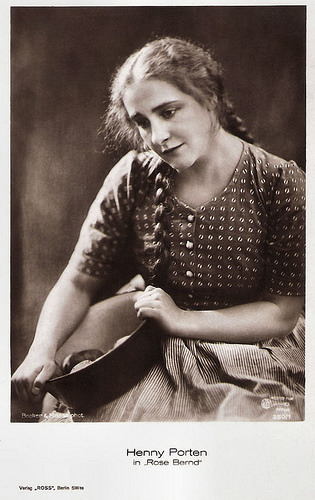
German postcard by Ross Verlag, Berlin, no. 350/1. Photo: Becker & Maass, Berlin / Messter-Film. Publicity still of Henny Porten for Rose Bernd (Alfred Halm, 1919).
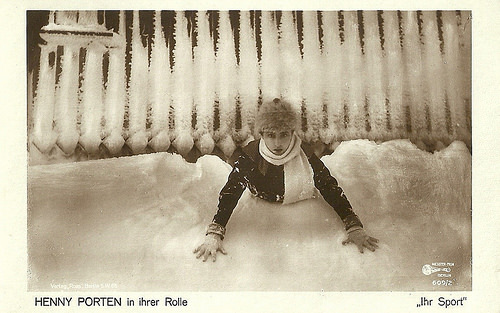
German postcard by Ross Verlag, no. 609/2. Photo: Messter-Film, Berlin. Publicity still of Henny Porten in the romantic comedy Ihr Sport/Her Sport (Rudolf Biebrach, 1919).
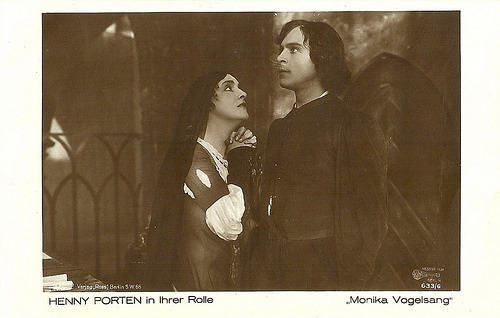
German postcard by Ross Verlag, no. 633/6. Photo: Messter Film. Publicity still of Henny Porten and Paul Hartmann in Monika Vogelsang (Rudolf Biebrach, 1920).
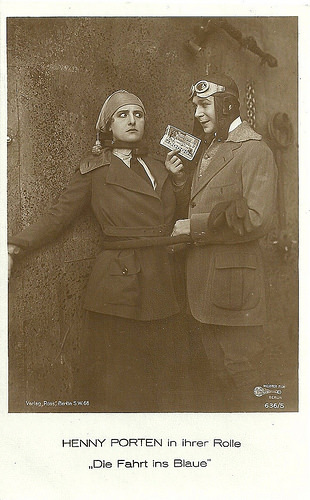
German postcard by Ross Verlag, no. 636/5. Photo: Messter-Film. Publicity still of Henny Porten and Georg Alexander in Die Fahrt ins Blaue/The drive into the blue (Rudolf Biebrach, 1919).
One of the cornerstones of a gigantic concern
In April 1918, at the end of World War I, Oskar Messter sold all his film companies to the newly founded Universum-Film Aktiengesellschaft (UFA) for 5.3 million gold Marks. His companies became one of the cornerstones of the gigantic concern that would dominate the German film industry until the end of 1945.
Messter himself retired from the active film business in 1918. Aged fifty-seven, he remained very active. From 1922 he actively enlarged his collection of historical film equipment. In 1924 he realised one film for the last time called Der Sprung ins Leben/Leap Into Life (Johannes Guter, 1924) starring Xenia Desni and Walter Rilla . It features one the earliest film appearances of the future star Marlene Dietrich . And in August, 1928, Messter was one of the founders of the Tobis sound film company,
In 1932, Oskar Messter donated his collection of historical film equipment to the Deutsches Museum (German Museum) in Munich. This is the world's largest museum of science and technology, with about 28,000 exhibited objects from 50 fields of science and technology.
In 1936, Messter published his biography called 'Mein Weg mit dem Film' (My way with the cinema), based in part on a decade of meticulous correspondence with all of the living film pioneers and inventors that he could reach.
Oskar Messter died in 1943 at his retirement home on the Tegernsee in Bavaria. He was survived by his second wife Antonie König.
Many seemingly lost Messter films have been found in the Desmet Collection of the EYE Filmmuseum in Amsterdam. After restoration they have been shown at numerous festivals all over the world.
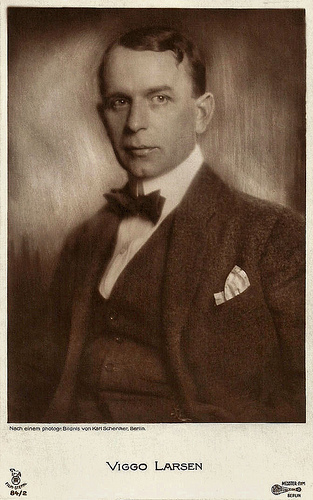
Viggo Larsen . German postcard by Rotophot in the Film Sterne series, no. 84/2. Photo: Karl Schenker / Messter Film, Berlin.
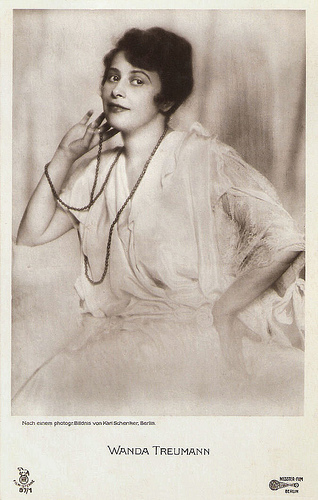
Wanda Treumann . German postcard in the Film Sterne series by Rotophot, no. 87/1. Photo: Karl Schenker / Messter Film, Berlin.
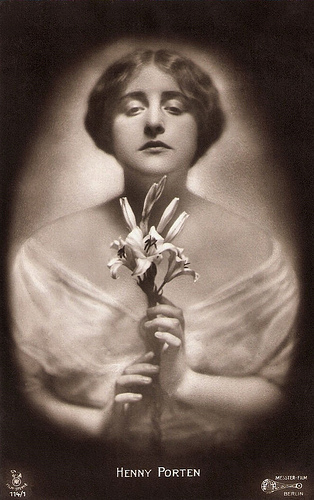
Henny Porten . German postcard by Rotophot in the Film Sterne series, no. 114/1. Photo: Messter Film, Berlin.
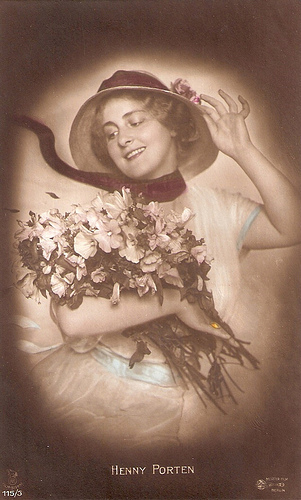
Henny Porten . German postcard by Rotophot in the Film Sterne series, no. 115/3. Photo: Messter Film, Berlin.
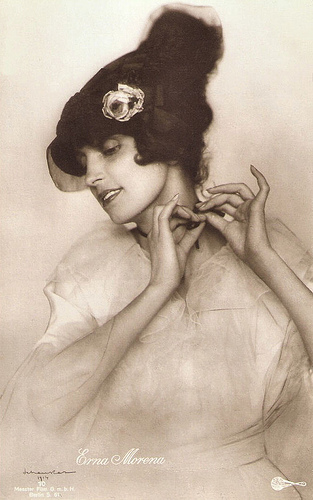
Erna Morena . German postcard, no. 10. Photo: Karl Schenker, 1914 / Messter-Film.

Arnold Rieck . German postcard by Rotophot in the Film Sterne series, no. 185/4. Photo: Nicola Perscheid, Berlin / Messter Film, Berlin.
Living Sculptures: Film Study for Screen Artist (1903) from Lewd Man on Vimeo.
As you can see above, there are many, many Henny Porten postcards. Next Tuesday we will start a weekly series of Film Specials on Henny Porten films. For the fans.
Sources: Deac Rossell (Who's Who of Victorian Cinema?), Filmportal.de, Wikipedia and .

German postcard by Ross Verlag, Berlin, no. 356/4. Photo: Messter-Film. Publicity still for Die lebende Tote/The living dead (Rudolf Biebrach, 1919). Henny Porten appeared in several early films as 'Lebendes Porzellan' (living china).

German postcard by Rotophot in the Film Sterne series, no. 542/6. Photo: Messter-Film. Publicity still of Viggo Larsen in Der Sohn des Hannibal/The Son of Hannibal (Viggo Larsen, 1918).

German postcard by Rotophot in the Film Sterne series, no. 563/1. Photo: Messter-Film, Berlin, Berlin. Publicity still with Viggo Larsen and Ria Jende in Die blaue Mauritius/The Blue Mauritius (Viggo Larsen, 1918).

German postcard by Ross Verlag, no. 401/1. Photo: Rembrandt / Messter Film. Publicity still of Henny Porten in Anna Boleyn (Ernst Lubitsch, 1920).

German postcard by Ross Verlag no. 639/5. Photo: Messter-Film. Publicity still of Emil Jannings and Henny Porten in Kohlhiesels Töchter/Kohlhiesel's Daughters (Ernst Lubitsch, 1920).
Film pioneer Oskar Messter
Oskar Eduard Messter (1866-1943) was born in Berlin, where his father Eduard had founded in 1859 a company called 'Optisches und Mechanisches Institut Ed. Messter'. This company manufactured and sold eyeglasses, precision medical devices, optical devices for magicians and show businessmen, electric reflectors for theatres, and projectors for the magic lantern.
Oskar finished an education as an optician by his father. This education proved to be essential for his later career. Oskar acquired both business, optical and mechanical skills, which he later applied in cinematography. He took over the management of his father's company in 1895 and only one year later he developed his first own film projector and began to produce cameras and film projectors in series.
This was one of the first projectors using a Geneva drive to achieve the intermittent motion of the film. He is often credited with inventing this application of the Geneva drive, but both Max Gliewe (also in Berlin) and Robert W. Paul in London independently built projectors using this mechanism for film transport at about the same time. Gliewe later joined Messter's company, and together they produced highly successful projectors. By the end of 1896, Messters-Projection Berlin had produced 64 projectors: 42 of these were sold in Germany and 22, in the rest of Europe.
On 15 June 1896, Messter rented a small theatre that had gone bankrupt at 21 Unter den Linden and inaugurated the second cinema hall in Berlin. The first cinema hall was opened by the envoys of the Lumière brothers that precise year. Messter demonstrated his first own short films to an enthusiastic audience. These films were short documentaries of contemporary events and showed partially everyday entities, partially huge occasions. But everything was interesting and fascinating for the film unacquainted audience.
Messter produced such films as Schlittschuhläufer auf der West-Eisbahn/A Skater at the West Rink (1896), Am Brandenburger Tor zu Berlin/At the Brandenburg Gate, Berlin (1896), Umsturz einer Mauer/Subversion of a wall (1897), Stapellauf vom Kreuzer Wilhelm der Grossen/Launch of cruiser Wilhelm the Great (1897), or Seine Majestät Kaiser Wilhelm II in Stettin/His Majesty Kaiser Wilhelm II in Szczecin (1897). In 1897, Messter already offered 84 films showing a wide variety of scenes.
In just four years, the company's profits had multiplied tenfold. In 1900, Oskar formed his own production company in Berlin, Messter Projections. A year later, he restructured his company into separate firms for film production, distribution, and the manufacturing of optical equipment, including film projectors.
Messter presented the Biophon, his method of producing talking films, as the headlining attraction at Berlin's Apollo Theatre in August 1903. Oskar used his Biophon to shoot his first films at the World Fair in Saint Louis, Missouri, in 1904. These films contained a sound-on-disc system.
He also produced 'short films of stage performances, among them Rapunzel (1897), Hänsel und Gretel/Hansel and Gretel (1897), Die bösen Buben/The bad boys (1897), Walküre (1898), Schlussszene des II Aktes aus Der Fall Corignan/Final scene of the II act from The Fall Corignan (1898) and Der verliebte Reservemann/The Reserve man in love (1898).
To his other milestones belong the development of the slow motion camera, the camera for microscopical shots, the realisation of the very first newsreel and the foundation of the Sascha-Messter-Film together with Sascha Kolowrat-Krakowsky. Oskar Messter continued his career as a producer in the new century and he was also always interested in new inventions.

German postcard by Rotophot in the Film Sterne series, no. 500/10. Photo: Messter-Film, Berlin. Publicity still of Henny Porten in Die Prinzessin von Neutralien/The Princess of Neutralia (Rudolf Biebrach, 1917).

German postcard in the Film Sterne series by Rotophot, no. 507/1. Photo: Messter Film. Publicity still of Henny Porten in Gräfin Küchenfee/Countess Kitchen Fairy (Robert Wiene, 1918).

German postcard in the Film Sterne series by Rotophot, no. 508/4. Photo: Messter-Film. Publicity still of Henny Porten and Reinhold Schünzel in the comedy Höhenluft/Mountain air (Rudolf Biebrach, 1917).

German postcard in the Film Sterne series by Rotophot, no. 520/7. Photo: Messter Film, Berlin. Publicity still of Henny Porten for Auf Probe gestellt/Put to the test (Rudolf Biebrach, 1918).

German postcard by Rotophot in the Film Sterne series, no. 531/5. Photo: Messter Film. Publicity still of Henny Porten and Hermann Thimig in Agnes Arnau und ihre drei Freier/Agnes Arnau and her three suitors (Rudolf Biebrach, 1918).
One of the constructors of Stardom
Messter-Film produced a total of three hundred and twenty six silent films between 1896 and 1918. Until 1910, all of them were short films of very short duration and from 1911, they were already medium-length films and feature films.
When the film became established in the 1910s and many directors made films, Oskar Messter remained an important producer in the film business. In the next years he realised more fiction films and less documentaries.
Many stars of the German silent cinema started their careers in these years in the films of Oskar Messter. Among them were such actors as Emil Jannings , Werner Krauss and Paul Hartmann and actresses as Wanda Treumann and Erna Morena , but also future directors like Robert Wiene and Carl Froelich.
Messter was one of the constructors of "stardom" through his promotion of the actress Henny Porten . Porten had already made her first film appearance in Meißner Porzellan/The Porcelain of Meissner (1906), a very short sound film, directed by her father, Franz Porten, for Oskar Messter. In 1907, after finishing her studies at the De Múgica College for Elderly Daughters, the young Porten became a professional actress. She signed an exclusive contract with Messter and starred in the film Lohengrin (Franz Porten, 1910), based on the opera by Richard Wagner. Although without great box office success at first, her striking appearance and simple style of acting exerted a magnetic effect on the public.
Henny became the first diva of the German cinema with her role as a blind girl in the melodrama Das Liebesglucke der Blinden/The Love of a Blind Girl (Heinrich Bolten-Baeckers, Curt A. Stark, 1910), written by her sister Rosa Porten . People started to ask for her name, and thus the Messter girl became one of the first film stars who was known by name.
In January 1911, Messter concluded a one month contract with Porten, which was repeatedly extended. Until 1918, she would make a hundred films for Messter-Film. In 1912, Porten appeared in Maskierte Liebe/Love Masked (Adolf Gärtner, Curt A. Stark, 1912), the first feature film of the Messters-Projection GmbH, Berlin. In 1913/1914 with the success of Eva (Curt A. Stark, 1913), an 'Autorenfilm', there followed the first of the 'Henny Porten film star series', which began with Der Feind im Land/Faithful Unto Death (Curt A. Stark, 1913).
Rudolf Biebrach, who in earlier films often played her father, now takes on the work of film director. At the end of World War I, Porten films are at the peak of success with German film audiences. The filming of the stage play Rose Bernd (Alfred Halm, 1919) is a big success, which greatly adds to the prestige of cinematography among German educated classes as well as critics.
This success is followed with three more hits, the comedy Kohlhiesels Töchter/Kohlhiesel's Daughters (Ernst Lubitsch, 1920), Monika Vogelsang (Rudolf Biebrach, 1920) and Anna Boleyn (Ernst Lubitsch, 1920). The latter two are among the most expensive projects up till then of Messter-Film. But by then, Oskar Messter has retired and Messter-Film has become part of a huge, new conglomerate...

German postcard in the Film-Sterne series by Rotophot, no. 567/5. Photo: Messter-Film, Berlin. Publicity still of Henny Porten in Die blaue Laterne/The Blue Lantern (Rudolf Biebrach, 1918), based on the novel by Paul Lindau. Porten is visible here in the inn The Blue Lantern.

German postcard by Ross Verlag, Berlin, no. 350/1. Photo: Becker & Maass, Berlin / Messter-Film. Publicity still of Henny Porten for Rose Bernd (Alfred Halm, 1919).

German postcard by Ross Verlag, no. 609/2. Photo: Messter-Film, Berlin. Publicity still of Henny Porten in the romantic comedy Ihr Sport/Her Sport (Rudolf Biebrach, 1919).

German postcard by Ross Verlag, no. 633/6. Photo: Messter Film. Publicity still of Henny Porten and Paul Hartmann in Monika Vogelsang (Rudolf Biebrach, 1920).

German postcard by Ross Verlag, no. 636/5. Photo: Messter-Film. Publicity still of Henny Porten and Georg Alexander in Die Fahrt ins Blaue/The drive into the blue (Rudolf Biebrach, 1919).
One of the cornerstones of a gigantic concern
In April 1918, at the end of World War I, Oskar Messter sold all his film companies to the newly founded Universum-Film Aktiengesellschaft (UFA) for 5.3 million gold Marks. His companies became one of the cornerstones of the gigantic concern that would dominate the German film industry until the end of 1945.
Messter himself retired from the active film business in 1918. Aged fifty-seven, he remained very active. From 1922 he actively enlarged his collection of historical film equipment. In 1924 he realised one film for the last time called Der Sprung ins Leben/Leap Into Life (Johannes Guter, 1924) starring Xenia Desni and Walter Rilla . It features one the earliest film appearances of the future star Marlene Dietrich . And in August, 1928, Messter was one of the founders of the Tobis sound film company,
In 1932, Oskar Messter donated his collection of historical film equipment to the Deutsches Museum (German Museum) in Munich. This is the world's largest museum of science and technology, with about 28,000 exhibited objects from 50 fields of science and technology.
In 1936, Messter published his biography called 'Mein Weg mit dem Film' (My way with the cinema), based in part on a decade of meticulous correspondence with all of the living film pioneers and inventors that he could reach.
Oskar Messter died in 1943 at his retirement home on the Tegernsee in Bavaria. He was survived by his second wife Antonie König.
Many seemingly lost Messter films have been found in the Desmet Collection of the EYE Filmmuseum in Amsterdam. After restoration they have been shown at numerous festivals all over the world.

Viggo Larsen . German postcard by Rotophot in the Film Sterne series, no. 84/2. Photo: Karl Schenker / Messter Film, Berlin.

Wanda Treumann . German postcard in the Film Sterne series by Rotophot, no. 87/1. Photo: Karl Schenker / Messter Film, Berlin.

Henny Porten . German postcard by Rotophot in the Film Sterne series, no. 114/1. Photo: Messter Film, Berlin.

Henny Porten . German postcard by Rotophot in the Film Sterne series, no. 115/3. Photo: Messter Film, Berlin.

Erna Morena . German postcard, no. 10. Photo: Karl Schenker, 1914 / Messter-Film.

Arnold Rieck . German postcard by Rotophot in the Film Sterne series, no. 185/4. Photo: Nicola Perscheid, Berlin / Messter Film, Berlin.
Living Sculptures: Film Study for Screen Artist (1903) from Lewd Man on Vimeo.
As you can see above, there are many, many Henny Porten postcards. Next Tuesday we will start a weekly series of Film Specials on Henny Porten films. For the fans.
Sources: Deac Rossell (Who's Who of Victorian Cinema?), Filmportal.de, Wikipedia and .
Published on March 15, 2019 23:00
March 14, 2019
L'infermiere di Tata (1916)
L'infermiere di Tata/The nurse of Tata (Leopoldo Carlucci, 1916) is the final of the nine short silent films, which the Italian company Film Artistica Gloria produced, based on the nine stories in Edmondo De Amicis's book 'Cuore' (Heart). Star is the young Guido Petrungara, who plays the Cicillo, who thinks his father is dying in a hospital. Once again, Stabilimenti Alterocca in Terni published a series of sepia postcards to promote the film.
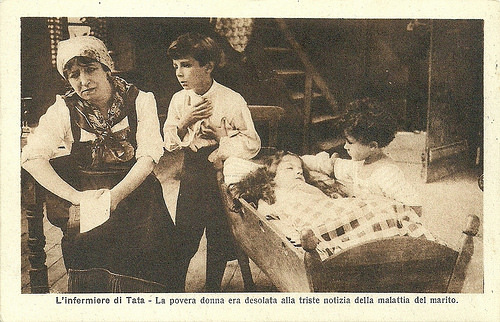
Italian postcard by Alterocca, Terni, no. 3419. Photo: Film Artistica Gloria, Torino. Publicity still for L'infermiere di Tata (Leopoldo Carlucci, 1916). Caption: The poor woman was desolate because of the sad news about her husband's illness.
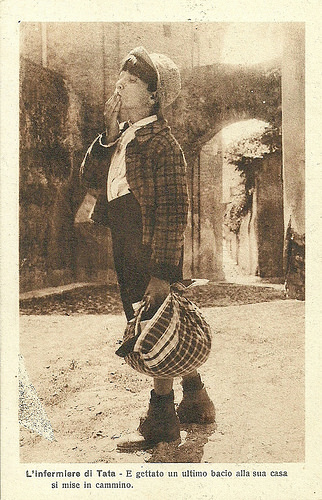
Italian postcard by Alterocca, Terni, no. 3380. Photo: Film Artistica Gloria, Torino. Publicity still for L'infermiere di Tata (Leopoldo Carlucci, 1916). Caption: After throwing an ultimate kiss to his house he went on his journey.
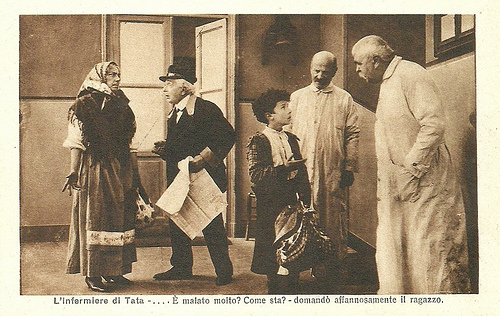
Italian postcard by Alterocca, Terni, no. 3379. Photo: Film Artistica Gloria, Torino. Publicity still for L'infermiere di Tata (Leopoldo Carlucci, 1916). Caption: Is he very ill? How is he?, the boy breathlessly asked.
A boy with a heart
The Italian silent film L'infermiere di Tata (Leopoldo Carlucci, 1916) is an adaptation of one of the nine short stories from Edmondo De Amicis' volume Cuore (1885). In Cuore, De Amicis tells about the life of nine boys in a school class in the city of Turin. Cuore is written in a diary form as told by Enrico Bottini, an 11-year-old primary school boy in Turin with an upper class background who is surrounded by working class school mates.
The stories are set during the Italian unification, and include several patriotic themes. The other boys are from various parts of Italy, giving a strong hint to the unity between the various regions of the Kingdom, both culturally as well as politically. The book was issued on 18 October 1886, the first day of school in Italy, and rose to an immediate success.
In 1915-1916, the company Film Artistica Gloria in Turin turned the stories of Cuore into a series of nine short silent films to support the war effort during World War I. In these shorts, the heroes are again nine young Italian boys who sacrifice themselves for their country and fight against the enemies at all time, even in distant wars.
L'infermiere di Tata (Leopoldo Carlucci, 1916) tells the story of the young boy Cicillo (Guido Petrungara). Because of a sad misunderstanding in a hospital, he attends to a agonising ill man, thinking he is his father.
The boy thinks of his poor mother and brother and sister, far away. Then his real father appears who embraces his son. The boy however doesn't leave the dying man and stays with him till he passes away.
Earlier in 1916, Guido Petrungara had also played Ferruccio in another part of the Cuore series, Sangue romagnolo/Blood from the Romagna (Leopoldo Carlucci, 1916). L'infermiere di Tata was his last film.
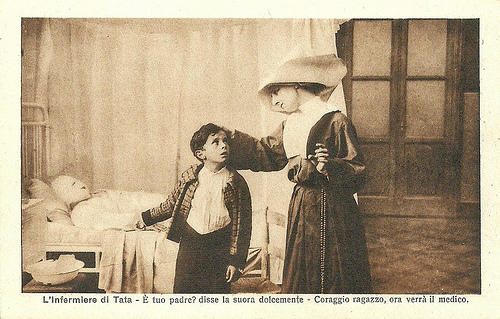
Italian postcard, no. 3378. Photo: Film Artistica Gloria, Torino. Publicity still for L'infermiere di Tata (Leopoldo Carlucci, 1916). Caption: Is he your father?, the nurse asked in a sweet voice. Have courage, boy, the doctor is coming now.
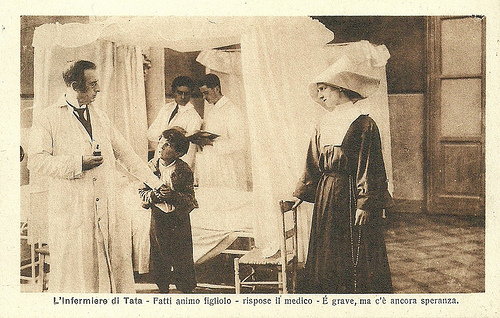
Italian postcard by Alterocca, Terni, no. 3377. Photo: Film Artistica Gloria, Torino. Publicity still for L'infermiere di Tata (Leopoldo Carlucci, 1916). Caption: Take heart, son, the doctor answered. It is serious, but there is still hope.
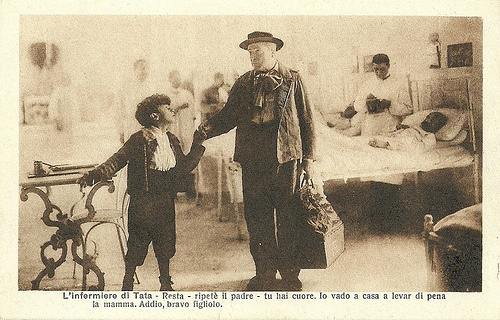
Italian postcard by Alterocca, Terni, no. 3376. Photo: Film Artistica Gloria, Torino. Publicity still for L'infermiere di Tata (Leopoldo Carlucci, 1916). Caption: Stay, the father repeated, because you have a heart. I am going home to relieve mother from her sorrow. Farewell, my dear son.
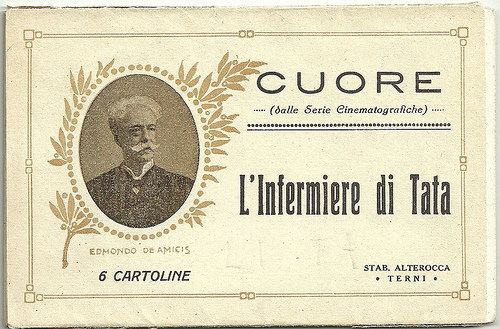
Italian edition by Alterocca, Terni. Cover of a series of 6 postcards on the Italian silent film L'infermiere di Tata (Leopoldo Carlucci, 1916), as part of the Cuore Series. Focus on the cover is on the author of the classic children's book, Edmondo De Amicis.
Sources: Wikipedia (Italian and English), and IMDb.

Italian postcard by Alterocca, Terni, no. 3419. Photo: Film Artistica Gloria, Torino. Publicity still for L'infermiere di Tata (Leopoldo Carlucci, 1916). Caption: The poor woman was desolate because of the sad news about her husband's illness.

Italian postcard by Alterocca, Terni, no. 3380. Photo: Film Artistica Gloria, Torino. Publicity still for L'infermiere di Tata (Leopoldo Carlucci, 1916). Caption: After throwing an ultimate kiss to his house he went on his journey.

Italian postcard by Alterocca, Terni, no. 3379. Photo: Film Artistica Gloria, Torino. Publicity still for L'infermiere di Tata (Leopoldo Carlucci, 1916). Caption: Is he very ill? How is he?, the boy breathlessly asked.
A boy with a heart
The Italian silent film L'infermiere di Tata (Leopoldo Carlucci, 1916) is an adaptation of one of the nine short stories from Edmondo De Amicis' volume Cuore (1885). In Cuore, De Amicis tells about the life of nine boys in a school class in the city of Turin. Cuore is written in a diary form as told by Enrico Bottini, an 11-year-old primary school boy in Turin with an upper class background who is surrounded by working class school mates.
The stories are set during the Italian unification, and include several patriotic themes. The other boys are from various parts of Italy, giving a strong hint to the unity between the various regions of the Kingdom, both culturally as well as politically. The book was issued on 18 October 1886, the first day of school in Italy, and rose to an immediate success.
In 1915-1916, the company Film Artistica Gloria in Turin turned the stories of Cuore into a series of nine short silent films to support the war effort during World War I. In these shorts, the heroes are again nine young Italian boys who sacrifice themselves for their country and fight against the enemies at all time, even in distant wars.
L'infermiere di Tata (Leopoldo Carlucci, 1916) tells the story of the young boy Cicillo (Guido Petrungara). Because of a sad misunderstanding in a hospital, he attends to a agonising ill man, thinking he is his father.
The boy thinks of his poor mother and brother and sister, far away. Then his real father appears who embraces his son. The boy however doesn't leave the dying man and stays with him till he passes away.
Earlier in 1916, Guido Petrungara had also played Ferruccio in another part of the Cuore series, Sangue romagnolo/Blood from the Romagna (Leopoldo Carlucci, 1916). L'infermiere di Tata was his last film.

Italian postcard, no. 3378. Photo: Film Artistica Gloria, Torino. Publicity still for L'infermiere di Tata (Leopoldo Carlucci, 1916). Caption: Is he your father?, the nurse asked in a sweet voice. Have courage, boy, the doctor is coming now.

Italian postcard by Alterocca, Terni, no. 3377. Photo: Film Artistica Gloria, Torino. Publicity still for L'infermiere di Tata (Leopoldo Carlucci, 1916). Caption: Take heart, son, the doctor answered. It is serious, but there is still hope.

Italian postcard by Alterocca, Terni, no. 3376. Photo: Film Artistica Gloria, Torino. Publicity still for L'infermiere di Tata (Leopoldo Carlucci, 1916). Caption: Stay, the father repeated, because you have a heart. I am going home to relieve mother from her sorrow. Farewell, my dear son.

Italian edition by Alterocca, Terni. Cover of a series of 6 postcards on the Italian silent film L'infermiere di Tata (Leopoldo Carlucci, 1916), as part of the Cuore Series. Focus on the cover is on the author of the classic children's book, Edmondo De Amicis.
Sources: Wikipedia (Italian and English), and IMDb.
Published on March 14, 2019 23:00
March 13, 2019
Die verwunschene Prinzessin (1919)
Eva May played the leading role in the German silent film Die verwunschene Prinzessin/The Enchanted Princess (1919), directed and produced by Erik Lund and scripted by Ruth Goetz. Among the cast were also Johannes Riemann, Olga Engl, Ernst Behmer and Leopold von Ledebuhr. The film was produced by Ring Film and the sepia postcard series for the film was published by Ross Verlag.
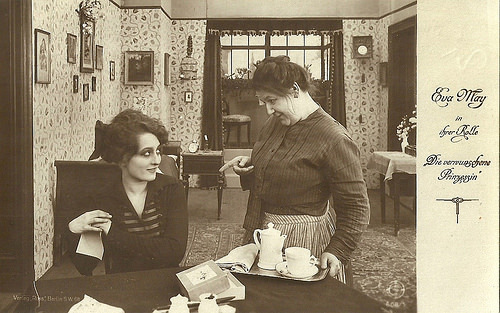
German postcard by Verlag Ross, Berlin, no. 608/1. Photo: Ring Film. Eva May (left) in Die verwunschene Prinzessin (Erik Lund, 1919).
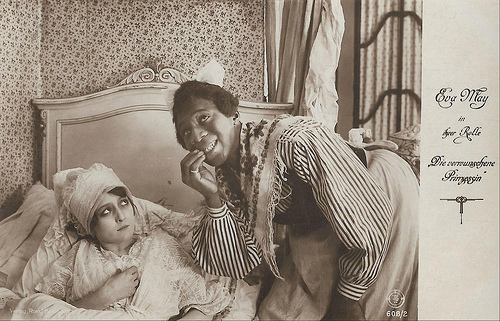
German postcard by Ross Verlag, no. 608/2. Photo: Ring-Film. Eva May in Die verwunschene Prinzessin (Erik Lund, 1919).
Everybody's Sweetheart
Die verwunschene Prinzessin/The Enchanted Princess (1919) was directed and produced by Erik Lund, born as Manfred Liebenau. Between 1918 and 1922 he directed dozens of silent films. He was also the first husband of the star of Die verwunschene Prinzessin, Eva May .
Eva was the princess of the silent German film industry. Her mother was the famous film actress Mia May and her father the powerful producer and director Joe May. Eva their only child and she was the apple of their eyes.
When she was only 12, Eva made her film debut in in a Stuart Webbs-Detective film called Stuart Webbs: Die geheimnisvolle Villa/The Black Triangle (1914) under the direction of her father. In 1918 Eva played the leading role in the silent film Sadja (1918) opposite Hans Albers . The film was directed by Adolf Gärtner and Erik Lund. Lund and his 16-year-old star actress fell in love and they married.
Eva went to work exclusively for the Ring-Film GmbH, managed by her husband. Lund directed his young wife in such films as Das törichte Herz/The Foolish Heart (1919), Schwarze Perlen/Black Pearls (1919) and Die Fee von Saint Ménard/The Fairy of Saint Ménard (1919). Liebenau and May created their own Eva-May-Serial for which Eva also wrote the scripts. She was treated kindly by the press and rose to ‘Jedermanns Liebling’ because of her nice roles.
But the marriage did not last long and by 1920 Eva was back with her parents and her films were now directed by her father. In the next years she would marry twice again, both times with a film director, but her marriages ended soon in divorces. Thomas Staedeli at Cyranos : "Privately Eva May was regarded as very difficult and sometimes freakish. She often argued with her father." In the night of the 9th to 10th September 1924 Eva May brought her life to an end with a gun shot. She was only 22.
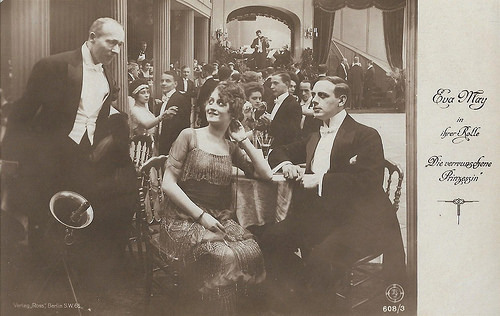
German postcard by Ross Verlag, no. 608/3. Photo: Ring-Film. Eva May and Johannes Riemann in Die verwunschene Prinzessin (Erik Lund, 1919). The man on the left could be Ernst Behmer.
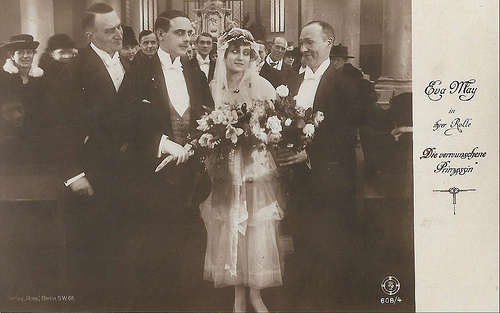
German postcard by Ross Verlag, no. 608/4. Photo: Ring-Film. Publicity still of Eva May and Johannes Riemann in Die verwunschene Prinzessin (Erik Lund, 1919). The man on the left, half behind Riemann, is Leopold von Ledebur. The man on the right could be Ernst Behmer.
Sources: Thomas Staedeli (Cyranos), Wikipedia and IMDb.

German postcard by Verlag Ross, Berlin, no. 608/1. Photo: Ring Film. Eva May (left) in Die verwunschene Prinzessin (Erik Lund, 1919).

German postcard by Ross Verlag, no. 608/2. Photo: Ring-Film. Eva May in Die verwunschene Prinzessin (Erik Lund, 1919).
Everybody's Sweetheart
Die verwunschene Prinzessin/The Enchanted Princess (1919) was directed and produced by Erik Lund, born as Manfred Liebenau. Between 1918 and 1922 he directed dozens of silent films. He was also the first husband of the star of Die verwunschene Prinzessin, Eva May .
Eva was the princess of the silent German film industry. Her mother was the famous film actress Mia May and her father the powerful producer and director Joe May. Eva their only child and she was the apple of their eyes.
When she was only 12, Eva made her film debut in in a Stuart Webbs-Detective film called Stuart Webbs: Die geheimnisvolle Villa/The Black Triangle (1914) under the direction of her father. In 1918 Eva played the leading role in the silent film Sadja (1918) opposite Hans Albers . The film was directed by Adolf Gärtner and Erik Lund. Lund and his 16-year-old star actress fell in love and they married.
Eva went to work exclusively for the Ring-Film GmbH, managed by her husband. Lund directed his young wife in such films as Das törichte Herz/The Foolish Heart (1919), Schwarze Perlen/Black Pearls (1919) and Die Fee von Saint Ménard/The Fairy of Saint Ménard (1919). Liebenau and May created their own Eva-May-Serial for which Eva also wrote the scripts. She was treated kindly by the press and rose to ‘Jedermanns Liebling’ because of her nice roles.
But the marriage did not last long and by 1920 Eva was back with her parents and her films were now directed by her father. In the next years she would marry twice again, both times with a film director, but her marriages ended soon in divorces. Thomas Staedeli at Cyranos : "Privately Eva May was regarded as very difficult and sometimes freakish. She often argued with her father." In the night of the 9th to 10th September 1924 Eva May brought her life to an end with a gun shot. She was only 22.

German postcard by Ross Verlag, no. 608/3. Photo: Ring-Film. Eva May and Johannes Riemann in Die verwunschene Prinzessin (Erik Lund, 1919). The man on the left could be Ernst Behmer.

German postcard by Ross Verlag, no. 608/4. Photo: Ring-Film. Publicity still of Eva May and Johannes Riemann in Die verwunschene Prinzessin (Erik Lund, 1919). The man on the left, half behind Riemann, is Leopold von Ledebur. The man on the right could be Ernst Behmer.
Sources: Thomas Staedeli (Cyranos), Wikipedia and IMDb.
Published on March 13, 2019 23:00
Paul van Yperen's Blog
- Paul van Yperen's profile
- 13 followers
Paul van Yperen isn't a Goodreads Author
(yet),
but they
do have a blog,
so here are some recent posts imported from
their feed.



